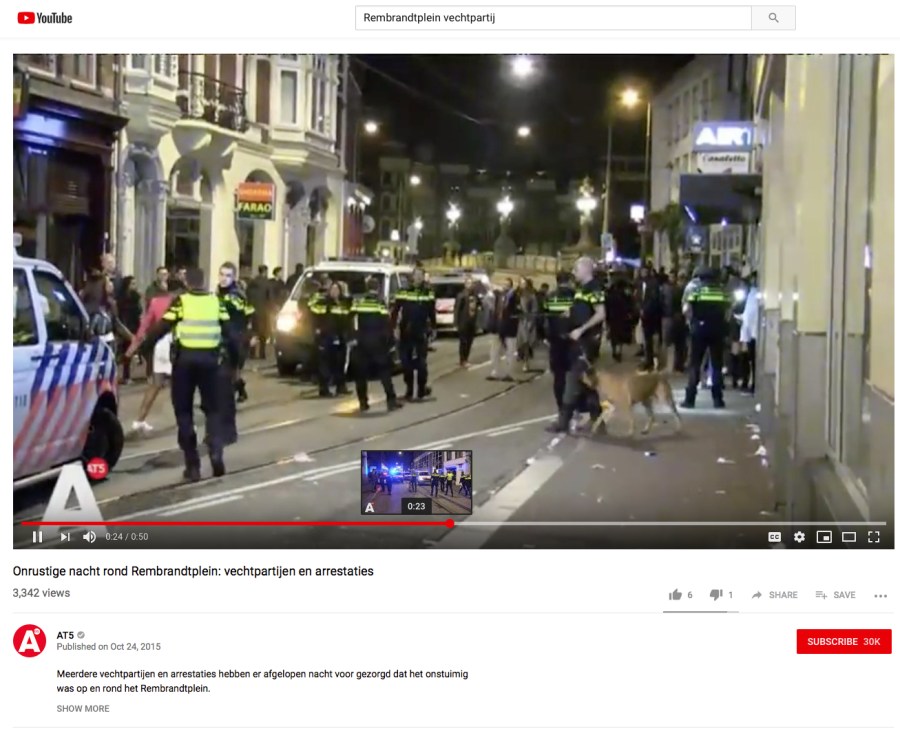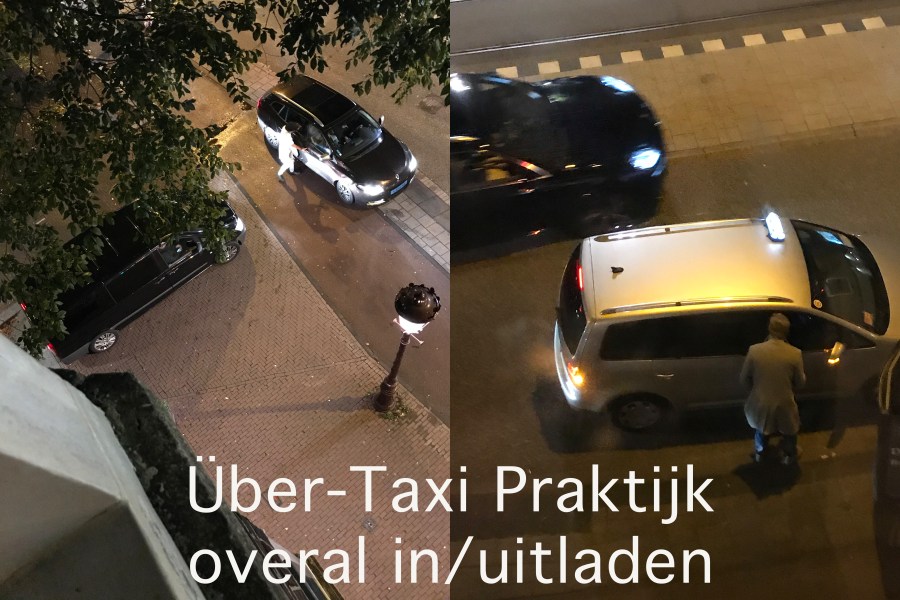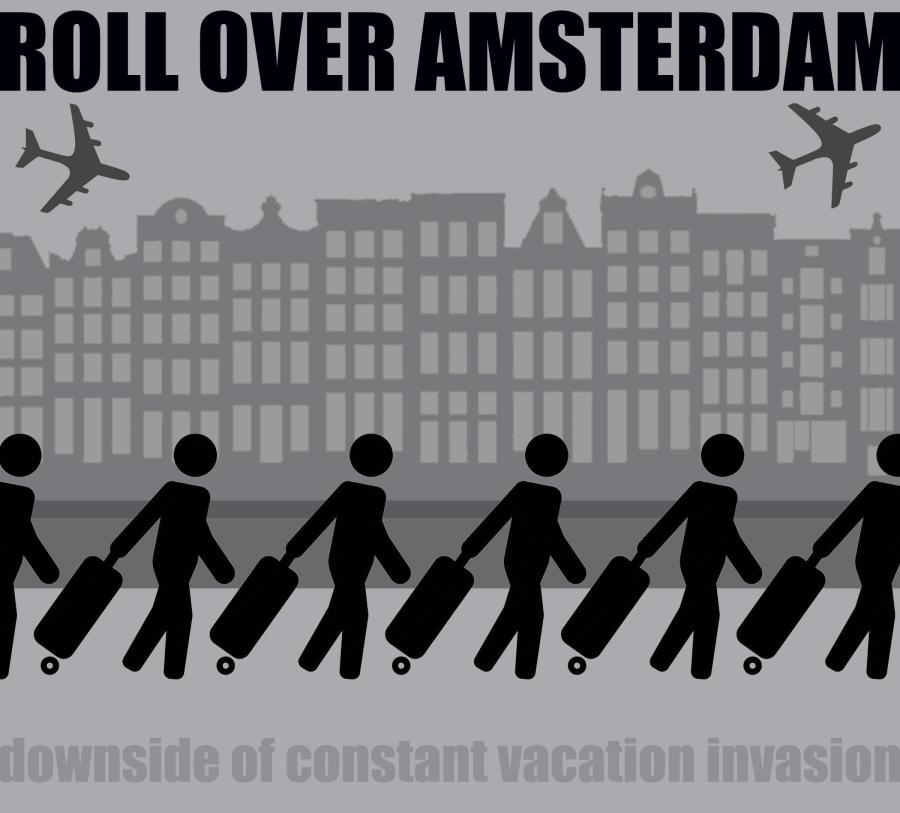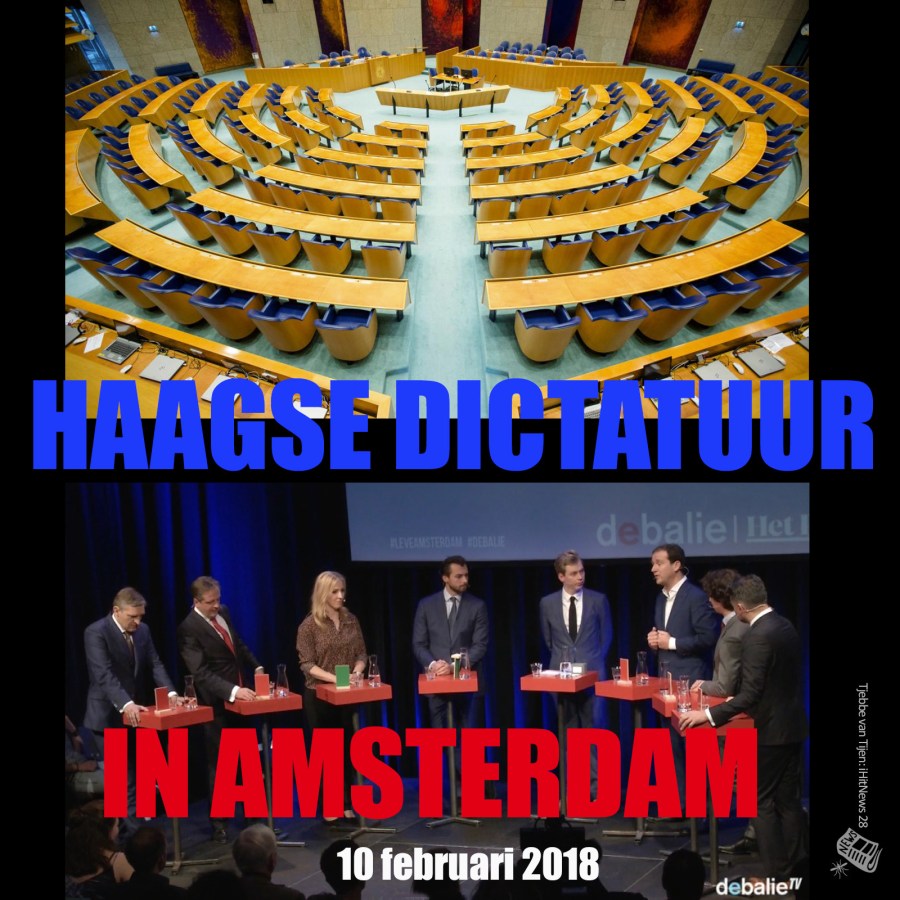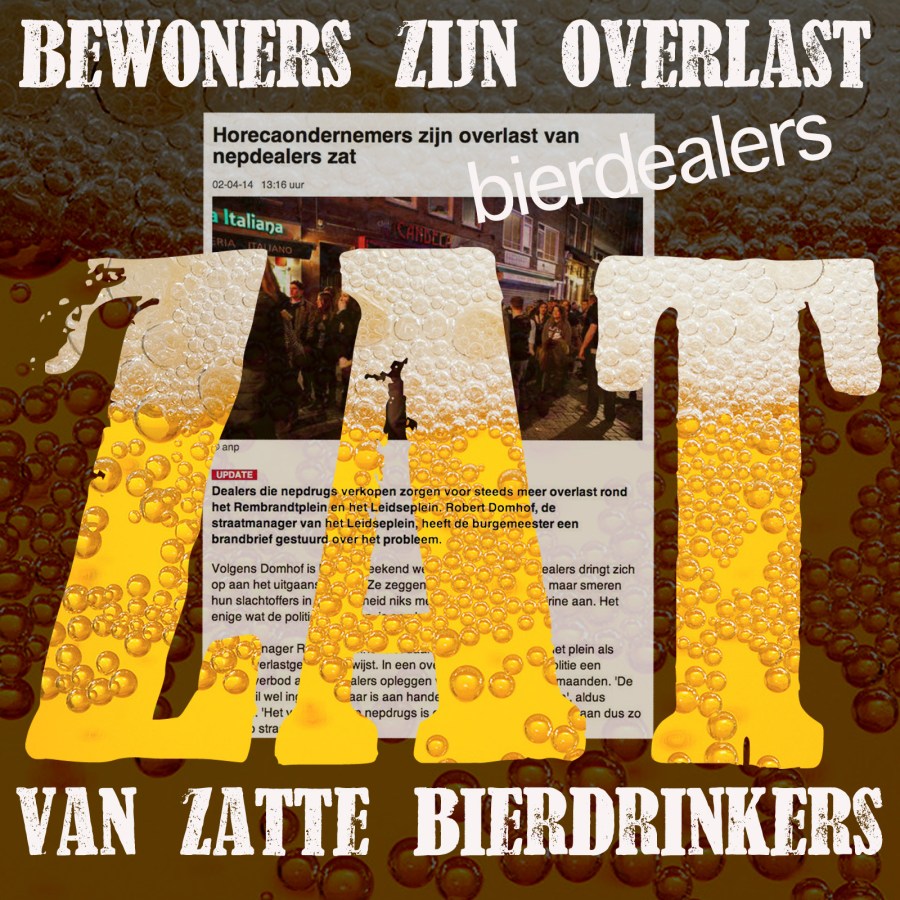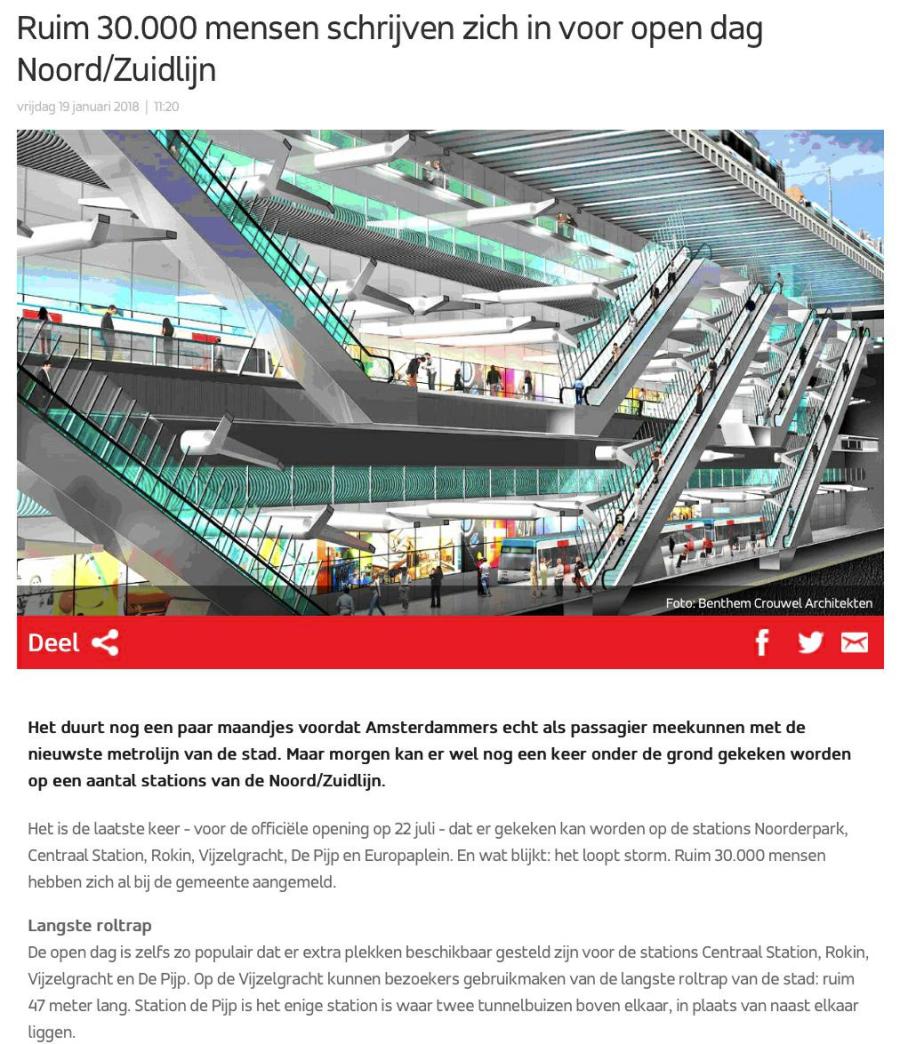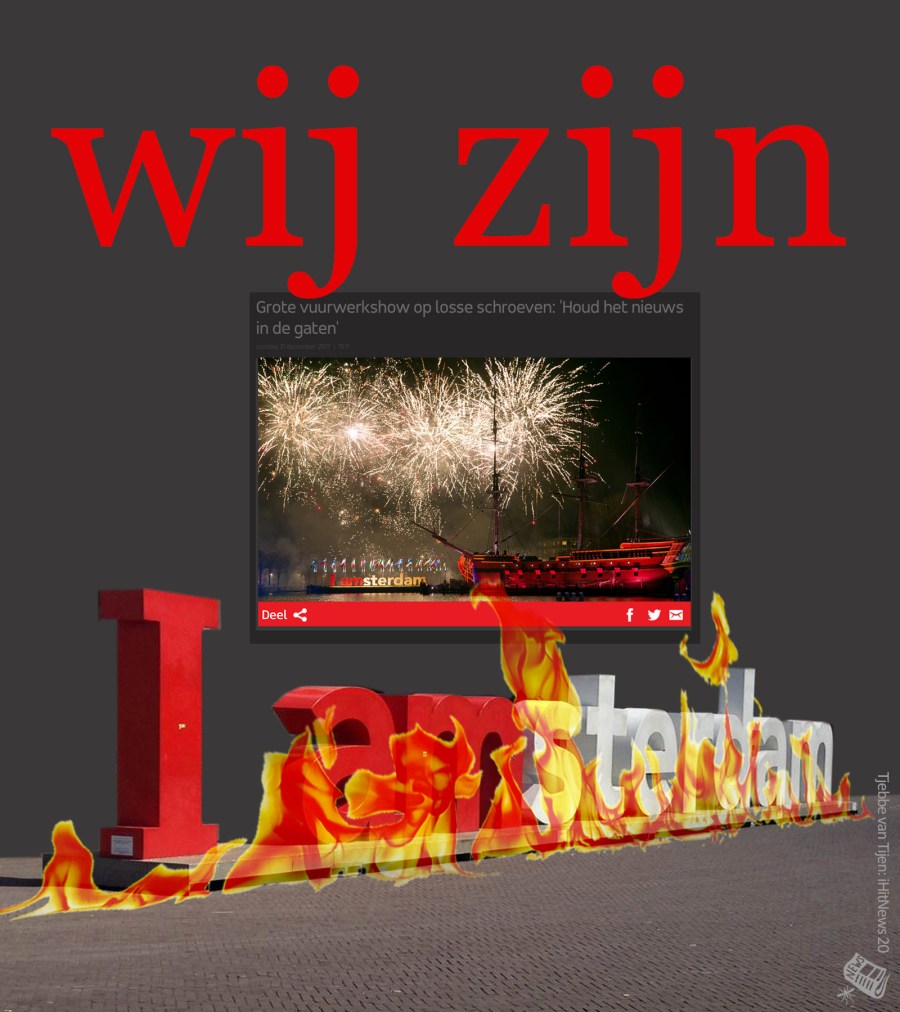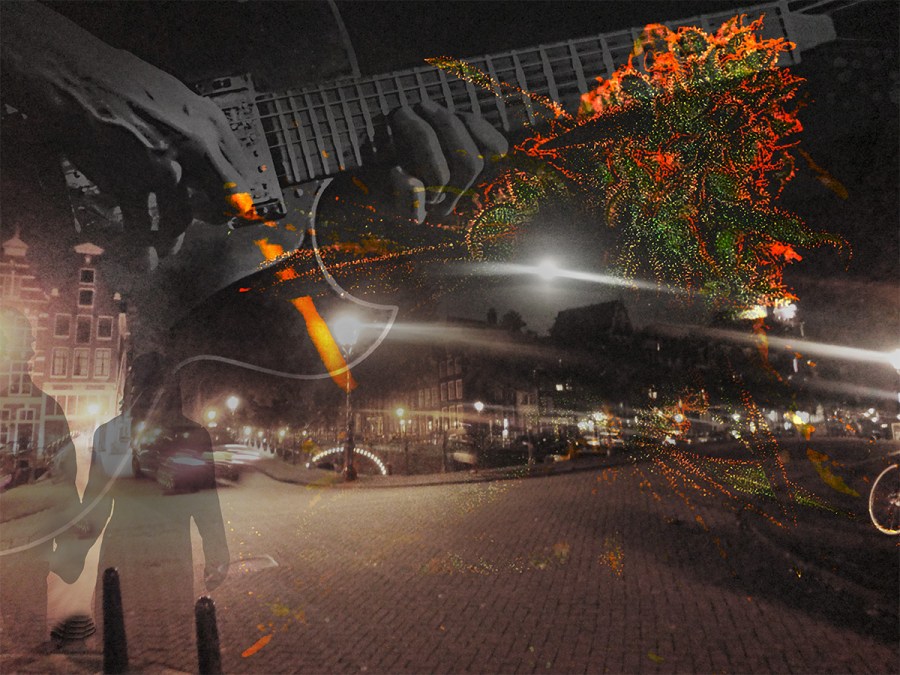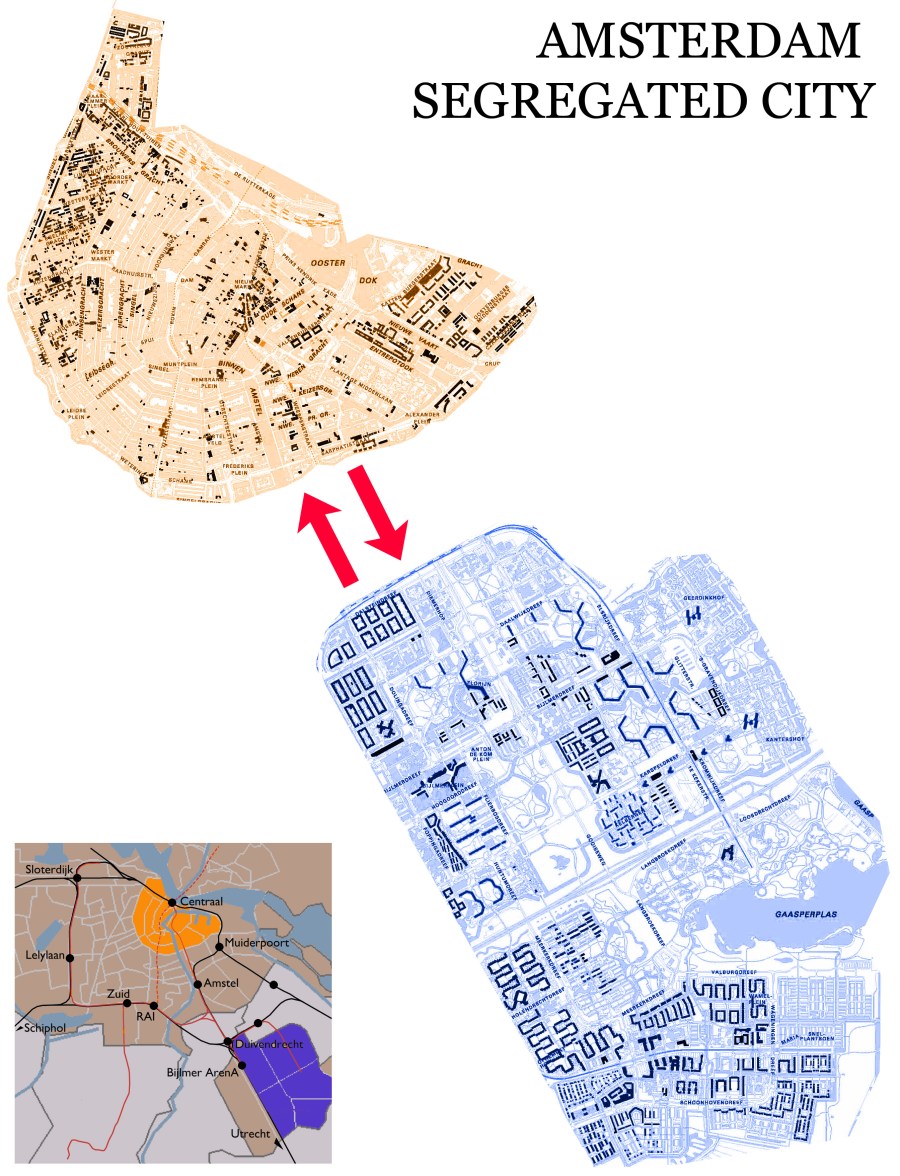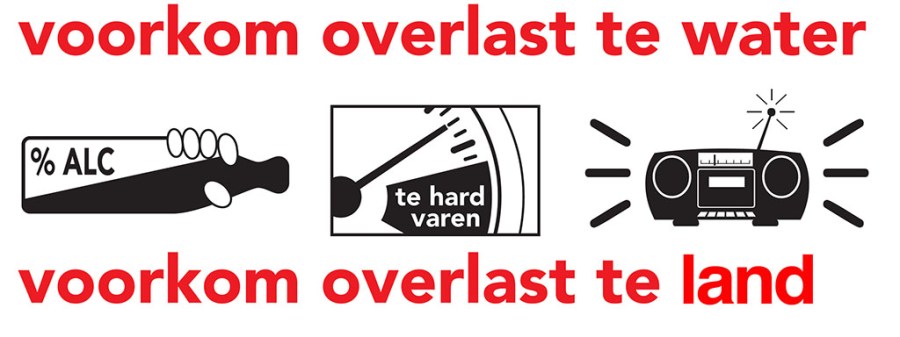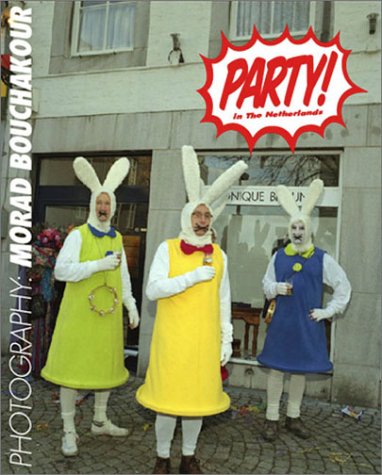~
(*) Het Parool 30/1/2019: “American Hotel wordt eerste Hard Rock Hotel in Nederland // Het American Hotel aan het Leidseplein, vanaf april 2020 een Hard Rock Hotel. Eden Hotels Amsterdam krijgt een vestiging van het Amerikaanse Hard Rock Hotels. Het American Hotel aan het Leidseplein, gevestigd in een 117 jaar oud Jugendstilmonument, wordt in april 2020 de eerste Nederlandse vestiging van de Amerikaanse keten. // Dat zegt hoteluitbater Léon Dijkstra. “Met de artiesten die wij hier in het verleden hebben ontvangen – en nog steeds ontvangen – is deze combinatie volstrekt logisch. En een luxehotel met muziekthema past precies in de driehoek DeLaMar, Melkweg en Paradiso.” Eén van de 100 kamers die inmiddels in de stijl van Hard Rock Hotels zijn verbouwd. Onderdeel van de formule is een manshoge spiegel © Eden Hotels Het hotel, in 2005 door het Amsterdamse Eden Hotels overgenomen van InterContinental, is al twee jaar bezig met de omslag. Zo zijn inmiddels 100 kamers en suites in de stijl van de Hard Rock Hotels gebracht. Binnenkort worden de resterende 75 kamers en de openbare ruimten, waaronder de lobby, onder handen genomen.”
Archive for the ‘Amsterdam World Village’ Category
‘Américain’ op ‘t Leidseplein wordt ‘Hard Rock Hotel’ in de toerismewoestijn
Posted in Amsterdam history, Amsterdam World Village, tagged Américain (Leidseplein - Amsterdam), Americain Leidseplein, American Hotel Amsterdam, cultureel geheugenverlies, Hard Rock Hotel Amsterdam, Hotelhouder Roderick Smith, massatoerisme, stadsgeheugen, volksmond namen gebouwen Amsterdam on January 30, 2019| 1 Comment »
Amsterdam: eindejaarsinvasie AUTOFIELE DEBIELEN in hun eigen file
Posted in Amsterdam World Village, Ecology, tagged Amsterdam, autofiles, binnenstede, eindejaarsdagen, GroenLinks (sic), luchtverontreiniging, massa-verveling on December 30, 2018| Leave a Comment »
WEER IS DE BEDREIGDE ZWAAN OPGESTAAN – Amsterdam 3 december 2018 prent bij de verwijdering van de “I amSTERDAM” letters op het Museumplein
Posted in Amsterdam history, Amsterdam World Village, tagged #Iamsterdam, Annemarie de Wildt, David Veldhoen (1957-), I amSTERDAM letters, iHitNews tableaus, Museumplein, Rijksmuseum (Amsterdam), selfies, toerisme, Zwaan schilderij van Jan Asselijn on December 3, 2018| Leave a Comment »
iHitNews tableau nummer 37 ter ere van het van het verwijderen van de I amSTERDAM letters op het Museumplein in de vroege ochtend van de 3e december 2018; met dank aan Annemarie de Wildt van het Amsterdam Museum voor de foto op de onderste helft van dit tableau, zij was als conservator van Amsterdamse geschiedenis naar het Museumplein getogen om het moment van verwijdering en de situatie pal erna vast te leggen…
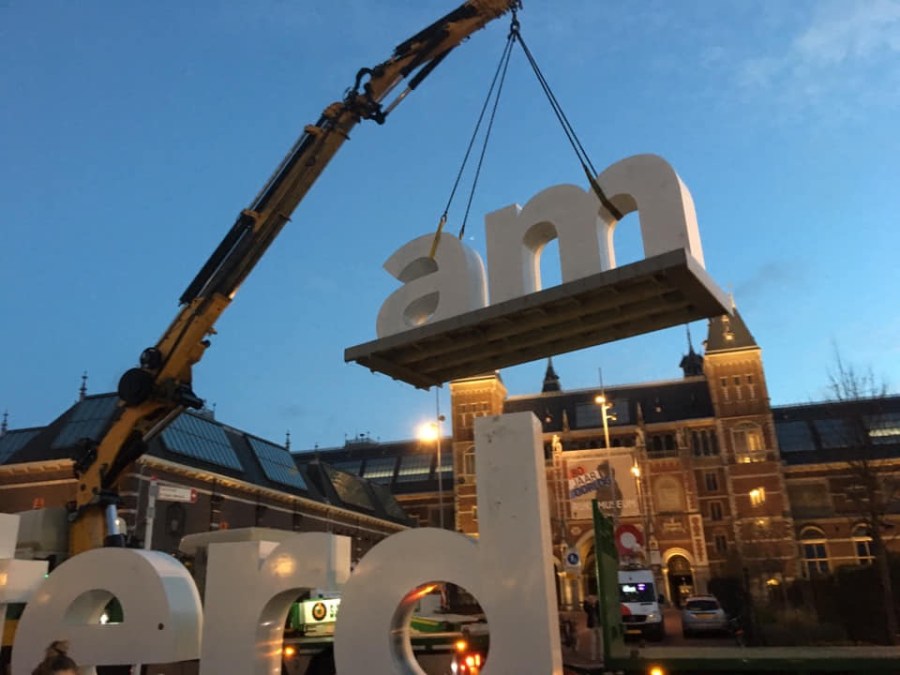
Bijschrift op de Facebook pagina van Annemarie de Wildt: “Historisch moment vastgelegd. De iconische I amsterdam letters zijn weg van het Museumplein. Het Amsterdam Museum heeft het werk van David Veldhoen verworven waarin hij de letters heeft verbeeld als een ruïne omgeven door anonieme toeristen. Veel pers, goed moment om deze actuele aankoop die binnenkort te zien zal zijn in Amsterdam DNA te presenteren. En de laatste foto is de eerste letterloze foto van een groep Indonesische toeristen die zich meteen begonnen te verontschuldigen toen ik zei dat de letters weg moesten vanwege het massatoerisme.
#Iamsterdam“

“Het Amsterdam Museum heeft het werk van David Veldhoen verworven waarin hij de letters heeft verbeeld als een ruïne omgeven door anonieme toeristen.”
De prent van David Veldhoen is te zien op zijn web-site: “Tourists pop up, colonise the city and then vanish in the haze. We don’t know who they are.”
De zwaan is van Jan Asselijn, ca. 1650 geschilderd en hangt in de permanente opstelling van het Rijksmuseum in de Eregalerij met dit bijschrift:
“olieverf op doek, h 144cm × b 171cm // Energiek verdedigt een zwaan haar nest tegen een hond. Het gevecht werd in latere eeuwen politiek geduid: de witte zwaan werd opgevat als de in 1672 vermoorde staatsman Johan de Witt, die het land verdedigt tegen zijn vijanden. Met die interpretatie kwam het schilderij in 1800 als eerste aankoop in de Nationale Kunstgalerij (de voorloper van het Rijksmuseum) terecht.”
OM EEN SNOEK TE VANGEN & DE MASSIFICATIE VAN AMSTERDAM
Posted in Amsterdam World Village, Consumerism, tagged Amsterdam City Swim 2018, demassificatie, festival-manie, massamens, pretpark Amsterdam, snoek (roofvis) on September 10, 2018| Leave a Comment »

Die snoekbaars vandaag in de Nieuwe Herengracht gevangen (zie AT5 bericht *) en naar ik hoop weer uitgezet – zie ik als symbool voor de noodzakelijke kentering bij het organiseren van manifestatie in deze stad. Weer de zoveelste ‘massa-manifestatie’ in de stad, waar over het grote aantal deelnemers in de pers gepocht wordt, met groot gejammer dat het dit jaar door vervuild grachtenwater niet kon doorgaan. Is dat wat voor mensen ongeschikt geacht wordt dan wel geschikt voor vissen en andere waterdieren? De gevangen snoekbaars was daarmee de enige deelnemer van Amsterdam City Swim die net uit het water gevist op de foto mocht.
Zwemmen in de gracht? Prima op je eentje of met een klein clubje. Muziek op een bootje (mits niet versterkt) als het niet te vaak is en goed klinkt… kan een aanwinst zijn voor de stad. Hardlopen door de stad? Waarom toch ‘en masse’? Wat is het toch dat al die organisatoren (gesteund door de gemeente) ertoe brengt om het aantal deelnemers steeds tot een maximum op te drijven?
Waarom die concetraties van mensen, teveel mensen… Arena, Ziggodome, overspoelde pretpleinen en -wallen: Rembrandt-, Leidse-… uitgaan en plezier maken in een grote groep, aangevoerd per vliegtuig-, bus-, trein- en metrolading? Toeristen in kluitjes lopend achter de vlag van een gids… Fietsen als toeristische groepsactiviteit, in plaats van als individueel vervoer- en zwerfmiddel bij uitstek.. Wat is die behoeft aan ‘massa’, tot ‘massamens’ gemaakt te worden?
De individueel opererende snoek zoekt scholen aasvis…. zo zijn al die massamanifestaties vooral het tot aasvis maken van mensen, zodat zij zich niet als enkeling, maar in grote scholen bewegen… DAN SLAAT DE SNOEK TOE .. HAP…HAP… de massamens is niet meer dan prooi, verslaafde consument van het heden… die zichzelf het individuele genot ontzegt en zich laat slachtofferen door gehaaide ondernemers.
Het Hollands spreekwoord is “een bliekje werpen om een snoek te vangen” (met iets onbeduidends iets belangrijks proberen te krijgen). Een ‘bliekje’, is een aasvisje, een spiering, dat zijn de tot massa gemaakte mensen, die gevangen worden tussen de scherpe tanden en krachtige kaken van de snoek.
Buig liever de massificatie van Amsterdam om naar demassificatie van Amsterdam.
(*) Tom vangt snoek van ruim een meter in Nieuwe Herengracht
https://www.at5.nl/artikelen/186190/tom-vangt-snoek-van-ruim-een-meter-in-nieuwe-herengracht
Halsema, Denk en CIDI doen de Gay Pride was
Posted in Amsterdam World Village, Emancipation, tagged burgemeester Femke Halsema, CIDI, DENK politieke partij, Gay Pride Amsterdam 2018, homo emancipatie, Israel, marketing, Numan Yilmaz, pinkwashing, regenboogvlag, Turkije, witwassen on August 13, 2018| Leave a Comment »
BONTE WAS is NIET GEBAAT bij WIT- ROZE- of ROOD-WASSERS

Er wordt wat afgewassen met betrekking tot de Gay Parade Amsterdam… terecht wordt er naar mijn mening gesproken over ‘pinkwashing’ van de Gay Pride Amsterdam (*) met al haar kapitale boten van bedrijven, instellingen en politieke partijen die zo hun progressief imago, voor wat voor hen een luttele cent is, weten op te schonen.
De politieke partij DENK die zelf aan ‘turks roodwassen’ doet beschuldigd nu burgemeester Femke Halsema con sui (de rozewassers) ervan Israel en met name Tel Aviv als voorbeeld te stellen van steden waar men goed zou weten om te gaan met emancipatie van homo’s en lhbti-rechten, terwijl het met de rechten van minderheden en verdrukte meerderheden in die streek slecht gesteld is (niet alleen DENK denkt dan aan de recente wetswijziging in Israel waarbij de staat zelf tot een Hebreeuws/Joodse eenheid uitgeroepen wordt, met als gevolg dat zij die een andere indentiteit hebben tweederangs burgers worden).
Het DENK raadslid Numan Yilmaz noemt dat ‘pinkwashing’ (nogmaals, misbruiken van lhbti-acties voor eigen politiek voordeel of imago)… DENK vergat daarbij de benarde positie van homos’ in Turkije in herinnering te brengen, laat staan de verturking van de Turkse staat, die maar niet weet te komen tot een vreedzaam samenleven met de Koerdische minderheid, een verwant conflict in historisch perspectief als we ook de Armeense genocide daar bij betrekken.
Daartegen kwam dan van de weeromstuit het CIDI – de pro-Israel lobby alsook ant-semitisme actievoerder in Nederland – in het geweer met “Niet burgemeester, maar Denk doet aan pinkwashing”… maar ook het CIDI moet daarbij flink wassen om de vuile was van de Israelische staat schoon aan de lijn te krijgen…
Er is het oude spreekwoord ‘de pot verwijt de ketel dat ie zwart ziet’, waarop we hier dan een moderne variant kunnen maken ‘het laken verwijt het kussensloop dat deze wit is’. Ondertussen krijgt de ‘bonte was’ hierdoor een grauw sluier die – ook – niet helemaal fris ruikt. Voor een mooie regenboogvlag heb je een ander wasmiddel nodig.
Referentie artikel in Het Parool : ‘Niet burgemeester, maar Denk doet aan pinkwashing’
Referentie artikel in De Volkskrant: ‘Omstreden wet maakt van Israël Joodse staat; Arabieren voelen zich weggezet als tweederangsburgers’
(*) Hier nog een commentaar uit de marketting branche op ‘pinkwashing”: “Het voelt soms alsof bedrijven alleen met de regenboogvlag zwaaien voor ‘gratis’ aandacht en hun employer brand.” lees hele artikel in ‘marketing facts’: ‘Pride en pinkwashing in marketingland’
Amsterdam SOHO HOUSE rooftop swim action by non-member locals on August 8. 2018
Posted in Amsterdam World Village, tagged Amsterdam University as property speculator, Bunge Huis, citizens protests, gentrification, Nick Jones, Rolkoffergroep, rooftop swimming pool, Soho House Amsterdam, Spuistraat 210 Amsterdam, Wijkcentrum d;Oude Stadt on August 7, 2018| Leave a Comment »
AMSTERDAM ROOFTOP SWIMMING POOL COMMONS ACTION

A reportage of the rooftop swimming pool action can be found at the web-site of the neighbourhood council (Wijkcentrum d’Oude Stadt)…..

The web-site HIGHSNOBIETY (the name is serious) has this item on the Bungehuis on the Amsterdam Spuistraat now appropriated by a British based fast grow company ‘Soho House’, after the University of Amsterdam (one of the big property speculators in town with its many buildings acquired in times when real estate prices were of another order) chucked out in 2015 protesting students that had occupied the building and sold it to this supra-jetset-company…
Protest about the extreme gentrification effects of this project by local inhabitants have been negated by the city municipality, direct actions and juridical actions did lead to nothing… so read how such a contested place is sold to its clientele:
“Opening canal-side in Amsterdam’s iconic Bungehuis building on Spuistraat on Monday, July 30, the latest outpost from Soho House is one of it’s nicest members clubs yet. Characteristic of previous clubs, a rooftop pool overlooking Amsterdam comes complete with parasol-covered sun loungers to be fought over on warm weekends. Meanwhile, the house features 79 hotel bedrooms, screening rooms, a state-of-the-art gym, spa, and Cecconi’s restaurant, as well as club spaces decked out with antique and custom-made furniture. Unique to the cycling-obsessed city, the new house will also offer bicycle repairs from a small workshop next to a dedicated storage space for 75 bikes. Like its recent opening in West London’s iconic former Television Centre, the building housing the club is iconic to the city. Built in the 1930s as a trading office, and since serving as the humanities building for the University of Amsterdam, its six stories are covered in limestone and granite, with no shortage of art-deco flourishes. Soho House is accepting membership applications for its new club now. Feast your eyes on the first shots of the stylish new spot in the gallery above.”
All this to make you understand the action for taking a dip in the rooftop pool by the locals – an initiative of the ‘Rolkoffergroep‘ (rolling case/trolley group, named after the irritating sound of tourists with suitcases on small wheel banging over the inner town streets) – on August the 8th..
The text on the poster says “the neighbourhood/buurt can go to the rooftop/het dak op” which is a Dutch expression equaling ‘you can fuck off’… this is in fact what the inner city council (Gemeente Amsterdam Stadsdeel Centrum) did say by it support for this decadent jetset abode, while at the same time failing to quell the ever growing tourist influx that consumes the city. It is the same inner city council that fails to safeguard the office space of the local inhabitant council, the Wijkcentrum d’oude Stadt (neighbourhood centre the old city). That centre for support of the inner town city well being was formerly owned by a social housing estate corporation, sold to the highest bidder in the Amsterdam housing bubble. This organisation, het Wijkcentrum d’Oude Stadt, is an organisation that exists since 1949 and has been at the core of civil action in the inner town for many decades. Mind you all this is happening in a city that – since the last elections – claims to have a Green Left signature government…
Especially the issue of a swimming pool in the old inner town has its own sad history, as there has been a public one at the Heiligeweg (not far from the new exclusive one at the Soho House), that existed for 91 years (1896-1987). Inner town inhabitants did form a committee in the eighties of last century to keep the swimming pool from closing because of budget cuts by the then social-democrat city government. They even did manage themselves this public swimming pole for several years. Seeing an exclusive club swimming pool getting a municipal permit 30 years later did remind many of us the loss of social common facilities in a town with a local government that often claims to be social progressive, which is a deep lie.

Campaign poster from 1983 for keeping the municipal swimming pool open: “B&W (local government) wants to close down the Heiligeweg pool because of needed budget cuts. Swimming is important for kids en grown ups. Now the only swimming pool in the inner town is about to disappear…”
some other thoughts…
“ Feast your eyes on the first shots of the stylish new spot” was the comment of the HighSNOBiety web-site commentator on the interior of Soho House Amsterdam, which amounts up to nothing more than a ‘non-style’, a smug bric-à-brac of recycled furniture sold under the common-donominator of ‘vintage’ or ‘retro’, a concept that may perfectly fit the ‘retarded’ minds of those who want to spend one and a half thousand euros a year for the ‘mediocre exclusiveness’ of the Soho House enterprise.

Already in 2016 there was this comment on the so called ‘exclusivity of Soho House in The Guardian (click the ‘The Guardian” for direct link; link underline is not well visible): “York said: “The whole point of private members’ clubs is that exclusivity, that they are where the magic people will all gather. Soho House is a very efficient operation, but there is one at every turn now, and they have diluted their brand to, I think, their detriment.
“I have been going to Soho House since it opened, and going there now it feels like it has lost something. There’s nothing special about it any more; they’ve lost that sheen, and that’s why it’s not where the magic people, the famous people, go any more.”
Soho House has attempted to maintain its appeal to artists and creatives, offering discounts for those under 27, and the only condition of joining is that people have a “creative soul”. Five years ago, it culled hundreds of members from it branch in New York, whom it deemed “too corporate”.
Gay Pride Canal Parade Amsterdam 2016: UNPLUGGED emancipation
Posted in Amsterdam World Village, tagged Amsterdam canals, Canal Parade, Dutch, Gay Pride Amsterdam, Gay Pride Unplugged, sound pollution, street stages far too loud on August 3, 2018| Leave a Comment »
In 2015 I published this lightly formulated protest against the unbearable sound pollution produced by the Gay pride Canal Pride (with sound systems on board of the boats that send shock waves through all the canals and neighbouring neighbourhoods where the parade passes… and worst the pre- and after-parties with street stages with many hours of sound terror. Did it have any effect? NO there is only brute force and brute commercialism in the minds of the Gay Pride organisers. They aim at tolerance and mutual respect in words but the sound terror that is part of Gay Pride has the opposite effect. Why is it that there must always be bug amplifiers and huge loud speakers, competing for who has the loudest?
Here at least in an image a show that it could all be different and nicer…
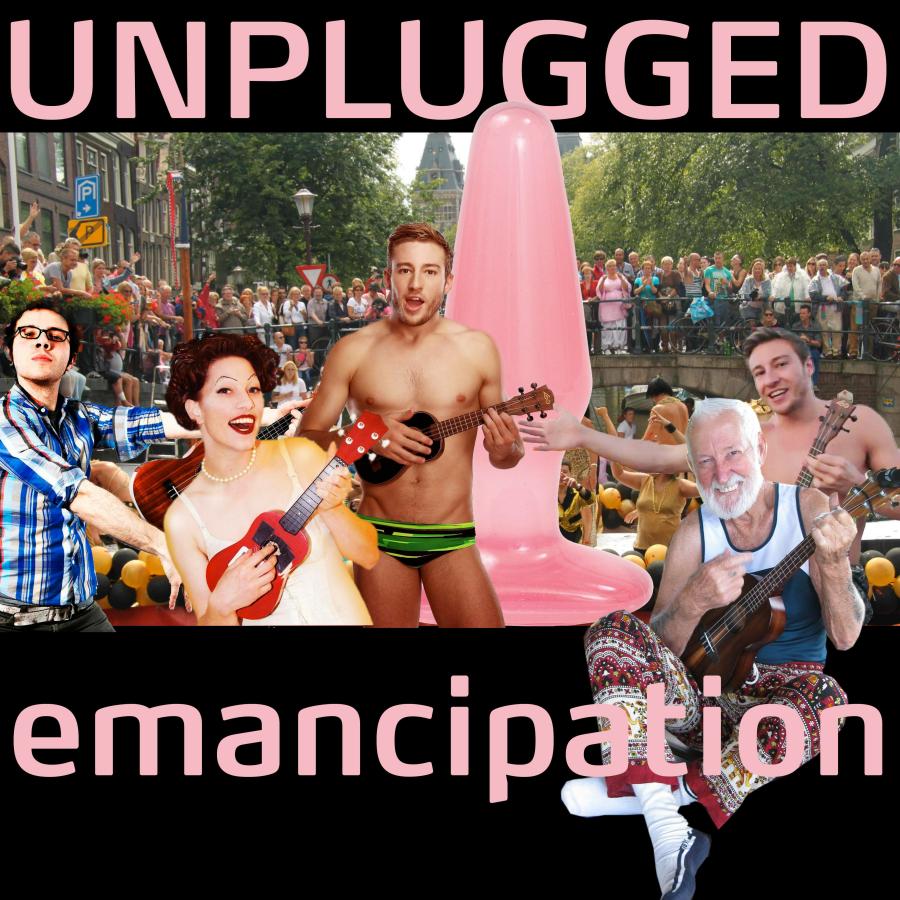
After years of Proud & Loud Gay pride Cana Parades that invade the city of Amsterdam with unbearable levels of noise pollution, finally it has dawned on a few more creative inclined fighters for the good cause of emancipation of everyone that it is time to unplug and show that gay emancipation should be considerate also to the inhabitants of the inner town that hosts them. It is not only about the ears of the public, but also their own hearing now and in the future that needs to be recognised. Too long the organisers of Gay pride Amsterdam have remained deaf to complaints about the negative side effects of what in itself is a just cause.
Pain level sound produced not only during the Canal Parade but also on the city streets with outdoor stages during three nights, are experienced as nothing but noise to those who live in the inner town. Many inhabitants are fleeing their homes – some for several days – because of an event that could be liked, but has turned into a hard core commercial enterprise with a competition who has the loudest sound system on board, who dares to turn the amplifiers up beyond any regulation. For those living around the Gay Pride is nothing less and more than three days of ‘sound pollution’.
Many living around the festival will hear from a distance only a mechanical droning base sound without any melody, with some high pitched over-modulated exalted sounds of people shouting in a microphone, this from seven in the evening until midnight during three days. If it was only one afternoon of the Canal Parade moving through the ‘grachten’ it would have been bearable. Each year the outdoor stages produce most of the time the same repertoire of disco and the like, with no renewal whatsoever. The only difference being that the amplification of that repertoire gets louder by the year.
Let’s get over with all this cheap and easily produced invasive self-centred party noise. Let’s become finally creative.
From 2016 on Gay pride Amsterdam will be UNPLUGGED and so many new inspiring opportunities lay ahead: ukelele orchestra on boats, plucking guitars, falsetto voices echoing underneath the bridges, violins, bassoons, flutes, the sound of horns from afar, the dying thunder of timpani, the high tone of a triangle bouncing over the surface of the water and choirs, many choirs of all sorts, performing in many styles…
The emancipation of all those that are treated as unequal will be married to the emancipation of the ear… than the inhabitants do not need to flee or burry their heads under the blanket, wear ear-plugs…
GAY PRIDE UNPLUGGED 2016 will become the herald of a genuine attempt of communicating joy and playfulness to the pleasure of all.
Gay Pride 2013 Amsterdam Proud and Too Loud: unplug your sound
Posted in Amsterdam World Village, Uncategorized, tagged Gay Pride 2013 Amsterdam, Gay Pride Canal Parade, misuse of public space, sound pollution on August 3, 2018| Leave a Comment »
In 2013, 5 years ago, I made this map and statement to visualise and made understood the extreme sound nuisance produced by the street stages that are part of the Gay Pride manifestation. There is hardly any effect of all the protests (especially by the inhabitants of the inner town of Amsterdam against the street stages with blasing sound systems during three days in a town with a refined structure of working and housing. The Amsterdam city authority are deaf for these protest and favour the Gay Pride use of public space which has developed into a party-industry. There is NO respect for the inhabitants of Amsterdam. The only difference is that we do have this year – 2018 – 21 hours of sound blasting from street stages as compared to 27 hours in 2013. Here we see 5 main street clusters with sound producing stages. In 2018 we count 10 place (in three clusters). [see my article and map on Gay Pride 2018]
CANAL PARADE? OK!
but before and after another 27 hours of too loud sound? NO!

Gay pride 2013 offers pleasure and fun for many who all say they LOVE Amsterdam as a tolerant city BUT do they love its inhabitants?
Why is it that we who live close to none less than 5 different outdoor stages near the Amstel river have to flee our houses, because during 3 days there is 27 hours of blasting sound with sub-sonic bass sounds that make our windows vibrate. NO consideration for those who live here, those who have helped to make it a tolerant town, which is now exploited commercially up to the limit making our living habitat into an industrial party zone.
Neither the city of Amsterdam nor the Gay pride organisers seem to be aware of the fact that the quality of Amsterdam is that the inner town has a great mix of functions, one being housing for a very mixed population, from the very rich, to middle classes and even low income housing that has escaped the gentrification process.
JUST THE CANAL PARADE and parties during 1 DAY OK! but 3 days of super loud outdoor events is TOO MUCH
Some of us ask themselves if the industrial booming sounds is the only thing Gay Culture has to offer to our city… The boat parade over the years has developed from a pleasure parade for the eyes into a horror flotilla for the ears.
CAN WE HAVE GAY PRIDE UNPLUGGED NEXT YEAR?
Can we be embraced in a more positive way next year by the local, national and international gay community?
YOUR LOUDNESS MAKES MANY DEAF TO YOUR MESSAGE which is about EQUALITY
We are made into UNEQUAL AND UNWILLING PARTICIPANTS by this form of Gay Pride… many living near the open air stages have fled their homes by now… and think about those who can NOT move from their houses because they have no money to go somewhere else, are ill or bound to their house in other ways.
I am about to leave to return only after midnight…. and have to leave again on Sunday from midday to late in teh evening because there is that third day of open air loud music and shouting once more.
Tjebbe van Tijen Saturday August 3. 2013 living very close to the Blauwe Brug over the Amstel river.
PS you should know that the maximum noise levels set by the authorities for the Gay pride (and similar festivals) are constantly broken by the DJs who do not give “a fuck” about anybody else than their fans. Also the specific structure of the city with its canals and the Amstel river and the location of the 5 stages from Amstelveld, Rembrandtplein, Paardenstraat and near the Munt, makes that through reflection and interference the sound produced by the huge loudspeakers travels over the water much further than in other circumstances, it even gets louder at times when two waves of sound combine.
UNPLUG far too loud GAY PRIDE Amsterdam
Posted in Amsterdam World Village, tagged disrespect for local inhabitants, far too loud music, Gay Pride Amsterdam 2018, party industry, pubic drunkeness, sound pollution, street parties on July 30, 2018| 2 Comments »
UNPLUG far too loud GAY PRIDE
– emancipation should be about mutal respect
– about sharing space
– about caring for others

The GAY PRIDE canal parade only takes 5 hours with an over the top loud blasting sounds from all the boats participating… it is still bearable in the sense that it is moving through the town and then for each region it is only 2 to 3 hours of the nasty blasting high tones and deep roaring bases that pollute the streets and houses: still DOABLE.
For years many people from this town have asked the question what this sound blasting street parties that pester entire neighborhoods have to do with ‘homo-emancipation’. Why it is that the local population should be pestered by high volume sound as an expression of ‘love’, and ‘friendship’. This critique is ONLY about the events of Gay Pride in PUBLIC SPACE… when one reads the whole program, there are many valuable and positive meetings, performances, exhibitions and concerts. Concerts that are not out on the streets are of course NO PART of this critique. There are a few events outside this map at Mercatorplein (good idea to go there), none in the Blijlmer, none in Noord… sonly one seems to be an acceptable level of duration (maybe also of sound content) the event planned at the Nieuwmarkt on August the second.
High sound volumes can be produced by anyone these days. Big sound systems can be rented or bought for low prices. FAR TOO LOUD music in the public space is a structural problem in this city, not only during the Gay Parade, there are many contested outdoor festivals that pester whole neighborhoods, ruin public parks and chase away animals. The organizers of Gay Pride seem to be totally blind to these civil protests against commercial outdoor mass events.
WHY HAS THERE NEVER BEEN A THOUGHT, LET ALONE AN ATTEMPT, TO HAVE AN UNPLUGGED GAY PRIDE? Does that idea not fit with the idea of GAY EMANCIPATION? Is the total commercialized party industry of our days the norm?
What comes before and after the (doable) Canal Parade for those who live in one of the ‘clusters’ of open air stages as mapped here is UNBEARABLE.
We inhabitants of this town have many years of experience with the Gay Pride FAR TOO LOUD event… and those who are not deaf and sensible try to flee their houses… If it was only one day that would have been doable. NO it is two to three days now. Many people do not have the financial means to leave their house and town for several days. Check out the permissible permits given by this town council who supports this sound-terror (that is what it is) and chases the people they should care for, the inhabitants, out of their houses.
There is 21 hours of street-stage activity planned, but NOWHERE it is possible to see what is in the making. The organizers, both from the Gay Enterprise and the Municipality are aware that they stretch things to the limit. This explains their vicious strategy of deception when it comes to give a full insight of the impact on town of the coming up outdoors events. That impact is hidden, not shown.
NO OVERVIEW MAPPING by the organizers, NO OVERVIEW MAP by the Municipality. When you check the many web-sites of Gay Pride promotors you are confronted with amateur made agendas full with superlative descriptions, but with no clear indication of what is ‘indoors’ and what is ‘outdoors’ often very unclear about when a specific event is starting or ending.
So the only overview I could find is a municipal page with links to 15 ‘bewonersbrieven’ (letters to the inhabitants)…
https://www.amsterdamgaypride.nl
Each letter is in PDF format (so they need to be opened one by one). The links to the ‘bewonersbrieven’ do indicate only partly the street of area name, some only carry the name of a bar that has a permit for a street stage, without mentioning a street name, like: ‘Bewonersbrief straatfeest Cafe Reality’, Bewonersbrief straatfeest Vivelavie’.
The content of the ‘bewonersbrieven’ all mention the fact that the event will create ‘some disturbance/nuisance’ followed by a contact number 14020 (which is the general nuisance complain number of the city). There is NO statement about the admissible sound-level set by the municipality and how sound levels will be controlled, if there is any mechanism to stop a situation when too much noise is produced.
Of course us inhabitants of the inner town know, that once the party is going there is NO STOPPING… You can call, wait for a long, long time before getting someone on the telephone. There is always insufficient response capacity, not enough controllers on the ground that have the equipment to do sound measuring, let alone anybody willing or formally entitled to unplug a sound system that breaches all rules.
Nobody ever has thought about the municipality buying sound-control systems that can be steered by the municipality itself instantly and constantly keeping the sound levels at the level promised. There have been many meetings and commissions and procedures, but these are all just for producing documents that prove that ‘on paper’ everything is done correctly.
This is a the typical Amsterdam bureaucracy specialty. The paper work they produce is impressive, but means nothing. Let me quote the titles of two of such documents form the list on the municipal web site:
– ‘Beleidskader 2011’ (policy paper 20110)
– ‘Handreiking voor een brandveilig evenement’ (reach-out paper for a fire safe event)
Then I see a link to a PDF with drawings at the bottom of that list… https://bekendmakingen.amsterdam.nl/publish/pages/96787/6_tekeningen_feesten_en_overig_2018.pdf
And when I browse through this document I come across a few more stages than in the list of letters to the inhabitants: -Geelvincksteeg, -Rembrandtplein, -Elandsstraat/Hazenstraat. Are these street events scrapped? No idea! This almost hidden document just shows detailed drawings for stages and loudspeakers.
The dates and times mentioned in the municipal permits and shown in this map DO NOT INCLUDE the building up and taking down of all the stage equipment, outside bars and the like. Also several permits for sound from street stages end at midnight, but the street parties may continue – according to the permits – for one hour more…
What is also not included is the tremendous noise produced by the municipal vacuum cleaners and broom wagons that will be for hours in the streets and areas affected.
What is not included is the noise and nuisance of masses of party goers who will have not only filled themselves to the limit with alcohol but also with all kinds of other recreational drugs. They will shout, they will piss, they will leave their tins, bottles and so on, on the doorsteps of houses and in wide circles around the core space of the 10 street events.
ALL THIS IN THE NAME OF GAY EMANCIPATION… which thus becomes a lie because it does not produce “love and friendship”. It is just like any other mass consumption party event… that brutally takes over public space and negates the fact that all this is happening inside a city, putting the burden on a few neighborhoods that are already affected by mass tourism and all the misfortunes of being part of the leisure industry that slowly takes over this town.
EMANCIPATION SHOULD BE ABOUT MUTAL RESPECT, ABOUT SHARING SPACE, ABOUT CARING FOR OTHERS, not a self centred international community partying with total disrespect of local inhabitants.

poster I made in the year 2012… nothing has been learned by the Gay Pride Incorporated enterprises and the community that supports their business.
DE AMSTERDAMSE WALLEN ZIJN TRENDY ook voor gezagsdragers
Posted in Amsterdam World Village, tagged burgemeester Femke Halsema, De Wallen (Amsterdam), koning Willen-Alexander, Majoor Bosshardt, media-belangstelling, ombudsman Arre Zuurmond, overlast Amsterdamse binnenstad, Prinses Beatrix, sprookjes met goede koning, undercover observatie on July 29, 2018| Leave a Comment »
DE WALLEN ZIJN TRENDY
– of de teloorgang van gerechtigheid uit sprookjes –

Nadat de Ombudsman met zijn berichtgeving over de onhoudbare toestand voor de gewone Amsterdamse buurtbewoner op De Wallen eerst het lokale nieuws wist te bereiken, vervolgens de landelijke pers en zelfs de NOS er een item aan wijdde, kunnen andere gezagsdragers niet achterblijven… zo spoedde Femke Halsema zich met heel haar gevolg van assistenten, politieagenten en vooral veel camera’s zich naar de Rosse Buurt om acte de présence te geven. Het zal niet lang meer duren of Femke en Willem Alexander wandelen hand in hand over De Wallen… dat moet de burger moed geven is de gedachte hierachter en ook is het een onmisbaar onderdeel van de waardebepaling van een gezagdrager of -draagster op de media-markt (en laten we wel wezen dat is het uiteindelijke hoogste doel van alles als je in bestuur of politiek actief bent).
De door velen zeer gewaardeerde ‘eigen observaties’ van de ombudsman, Arre Zuurmond gingen aanvankelijk gepaard zonder beelden van hem als persoon, laat staan geposeerde beelden op de plaats des onheils.
Dat was even effectief als sympathiek. Zijn gang naar het nieuws, met de bijbehorende fixatie op zijn persoon, mag dan wel tot doel hebben om de goede zaak van het bestrijden van overlast te dienen, de consequentie is dat hij zijn taak als incognito observant daarmee verloren heeft. Dat is jammer en het is de vraag of hij een legertje ‘mollen’ als plaatsvervangende observanten achter de hand heeft om zijn goede werken voor te zetten.
Anders is het voor hoogwaardigheidsbekleders die niet langer – zoals in vele sprookjes uit vele culturen te vinden is – vermomd als ‘gewone vrouw of man’ zelf de ware toestand van het volk in ogenschouw nemen om vervolgens gerechtigheid te laten zegevieren. Het bezoekje van Femke Halsema aan De Wallen ervaar ik als misplaatst. Dat had anders gekund, kunnen de grimeur en kleermaker uit de Stopera niet een voortreffelijke vermomming voor haar fabriceren? Wat was het nut van die kleine stoet met floodlights en camera’s op De Wallen? Had zij niet beter zich publiekelijk kunnen uitspreken over de waarde die zij hecht aan de reportages van de gemeentelijke ombudsman?
Het wachten is op de koning die op Koningsdag De Wallen gaat bezoeken en persoonlijk al het gajes in de gracht zal smijten… gaan we dat meemaken?
~
Willem-Alexander zijn moeder deed het wel. Laat ik dit in herinnering roepen, het jaar is 1965 (Willem Alexander is nog niet geboren): “Het had allemaal een groot geheim moeten blijven. In 1965 nam majoor Bosshardt van het Leger des Heils prinses Beatrix mee door de Wallen, de rosse buurt van Amsterdam. In vermomming, want de jonge prinses mocht niet herkend worden. Uiteindelijk werd ze, ondanks haar pruik, hoofddoek en dikke bril, herkend tijdens het uitdelen van De Strijdkreet, het tijdschrift van het Leger des Heils.”
Op de web-site van het Legers des Heils op een pagina gewijd aan Majoor Bosshardt is een foto met bijschrift te vinden van dit sprookjesachtig bezoek aan de wallen van Beatrix.

“Er waren weinig mensen zó benaderbaar als majoor Bosshardt. Ze had veel bekende vrienden die bewondering hadden voor de tomeloze inzet voor de naaste in nood. Ze raakte zelfs bevriend met prinses en later koningin Beatrix. Ze nam de prinses eens undercover mee de Wallen op om de verschrikkelijke realiteit van prostitutie en armoede te laten zien. Later kwamen ze elkaar geregeld tegen bij officiële gelegenheden, zoals het openen van diverse nieuwe locaties van het Leger. Na het overlijden van de majoor opende prinses Beatrix het Leger des Heilsmuseum op de Wallen en de vernieuwde opvanglocatie voor dak- en thuislozen, vlak naast het huis waar Bosshardt altijd heeft gewoond. Ook met koningin Juliana had de majoor goed contact. Zo is ze eens met haar kenmerkende mandje via de achterdeur het paleis ingegaan om de koningin te bezoeken.” (bijschrift op web-site Leger des Heils)
EASYJET AIRBNB roller suitcase bombardment
Posted in Amsterdam World Village, Consumerism, Urban questions, tagged AIRBNB, Amsterdam, EasyJet, mass tourism, rolfkoffers on March 31, 2018| Leave a Comment »
Picture originally made for my Flickr news-tableau pages in the year 2015 and republished on the eve of Eastern 2018 from Amsterdam with even more easyjet invasion….
EASYJET AIRBNB roller suitcase bombardment – the more reachable a city, the less attractive it becomes because of invasive tourism that changes the social economics of what were once thought to be the most attractive parts of town… Local services disappear to make place for tourist oriented facilities, Rental houses are sold and often turned into high rent ex-pat apartments and the like. Legal or illegal or half legal more and more houses are turned into temporal or full time rent-out rooms for tourist. Whole trains of roller suitcases can be heard on the week-ends and endless in-between-holidays of tourists flown in on cheaper and cheaper flights. Airplanes which were not flown over the centre of town in the past do so now regularly, because of an enormous increase in air-traffic, so even for setting a foot on the local soil the tourists have invaded the town-space. Who do benefit from this? Certain parts of local businesses, tour operators, and the digitally managed systems of mass transportation and holiday rental: EASYjet and other + AIRBNB.
All this written from Amsterdam, but it could be any other attractive city in the world.
Roll Over Amsterdam – the downside of constant vacation invasion
Posted in Amsterdam World Village, Urban questions, tagged #Iamsterdam, affiches, anti-tourism campaigns, Easy Jet, EasyJet, mass tourism, posters, raamposters, rolkoffers, vacation invasion on March 31, 2018| Leave a Comment »
Originally made in the year 2015 for my Flickr pages with news-tableaus, republished on the eve of Eastern in 2018 with a much larger tourist invasion as three years ago….
The better a place can be reached the less remains that is worthwhile reaching
ROLL OVER AMSTERDAM
Een poster voor een even onmogelijke als noodzakelijke campagne… hoe aangenamer toeristen-herkomst-woonplaatsen gemaakt worden hoe minder behoefte voor hen om en masse naar afgelikte steden als Amsterdam af te reizen… dat geldt ook binnen Nederland en binnen steden zelf, denk een in: de buitenwijk beter en mooier vertier te bieden heeft dan de binnenstad….
HOE BEREIKBAARDER EEN PLAATS HOE MINDER ER OVERBLIJFT DAT DE MOEITE VAN HET BEREIKEN WAARD IS
Hang ‘m voor je raam!
onKIESwijzer: roestige BestuursKracht Amsterdamse PVDA versus de gevreesde BestuursKrach van D66 in 2014 (door de bril van Ed van Thijn)
Posted in Amsterdam World Village, Dutch politics, tagged bestuurskracht, coalitievorming Amsterdam, D66, Ed van Thijn (PvdA), Hans van Mierlo (D66), Rood Bolwerk Amsterdam, Wim Wessels (D66) on March 21, 2018| Leave a Comment »
NRC 13/3/2014, ik lees “VAN THIJN (PVDA) VREEST VOOR AMSTERDAM ALS D66 GROOTSTE WORDT” (1)

D66 16 REGEERJAREN SAMEN MET DE PVDA
Die uitspraken zijn verbazingwekkend aangezien sinds D66 voor het eerst in de Amsterdamse politiek een rol ging spelen…
(in 1970 met 3 zetels en tot 1990 een kwakkelend kiesresultaat bereikt en soms vrijwel geheel weggevaagd werd, kwam deze partij in 1990 flink op in 1990 met 9 zetels, om acht jaar later weer teruggezakt te zijn tot 4 en met hangen en wurgen in 2010 7 zetels te behalen)
die partij in 44 jaar vier keer deel uitmaakte van het Amsterdamse stadsbestuur.
Na de verkiezingen van 1982, 1986, 1994 en 1998. Al die 16 regeerjaren werkte D66 samen met de PvdA.
Hoe zo zegt een vroeger Amsterdams raadslid en burgermeester van Amsterdam in de periode 1983-1994, dat D66 geen bestuurservaring kan hebben?
Diezelfde blindheid voor het eigen verleden tref je bij het D66 van het jaar 2014 aan. Ik zie in talloze one-liners en twitters deze leuze terugkomen in een aantal variaties (“70 jaar PvdA bewind”; “Rood Bolwerk”, “PvdA bolwerk”)
—-
“Stientje v Veldhoven @SvVeldhoven Mar 16
Geef na 60 jaar Pvda, dit keer #D66 een kans in Amsterdam! Elke stem telt! @jpaternotte #nuvooruit”
—
Ontkent D66 dan haar eigen verleden, dat zij van de 48 jaar dat zij als partij bestaan 16 jaar samen geregeerd hebben met de PvdA in Amsterdam? Dat is één derde van haar bestaan als Amsterdamse partij, waarbij aangetekend moet worden dat door eigen stommigheid in het jaar 2010, D66 een plaats in het stadsbestuur misliep.
Is het soms daarom dat nu zo vol ingezet wordt tegen dat wat toch een logische ‘paarse’ coalitiegenoot zou kunnen zijn, de PvdA?
Veranderd daarom D66 van politieke kleur met haar voorkeur mét VVD & zónder PvdA?
AHISTORISCH GEBLER OVER EINDE MAKEN AAN RODE BOLWERK AMSTERDAM
<intermissie>
Ook het ahistorische geblèr van de VVD over een eind maken aan het “rode bolwerk Amsterdam” (via haar megafoon De Telegraaf), is even huichelachtig als onwaar.
De VVD was maar liefst 20 jaar lang één van de partners van de PvdA in het stadsbestuur: 1990 (PvdA+D66+VVD+GL); 1994 (PvdA+VVD+D66); 1998 (PvdA+VVD+D66+GL(die haakte tijdens de rit af)); 2002 (PvdA+VVD+CDA); 2010 (PvdA+VVD+GL)
</intermissie>
Deze overdenking was de aanleiding voor mij om nog eens in het verleden van beide partijen te duiken en van daaruit de verwijten over en weer van D66 en de PvdA opnieuw te bekijken.
…met ex-raadslid/wethouder/burgermeester Ed van Thijn (Edje Kadetje was zijn naam bij krakers in de tachtiger jaren tijdens zijn burgermeesterschap) die waarschuwt voor het gebrekkige bestuurstalent van D66 en ons aanraadt toch vooral op de partij van echte bestuurders te gaan/blijven stemmen.(1) …Was het nu dankzij of ondanks Ed van Thijn dat Amsterdam ontsnapte aan de Olympische Spelen van het jaar 1992?…
Wel heeft Ed van Thijn zelf geboekstaafd dat hij er – begin jaren 90 – nog voor geijverd heeft om het oude Olympisch Stadion van het jaar 1928 af te breken, ten faveure van het nieuwe Ajax Stadion de Arena en de bewoners uit Zuid die de voetbalvandalen beu waren (2). Wat was er al niet gesloopt, aamgeplempt en bijgebouwd als Amsterdam opgeofferd zou zijn op het onroerendgoed, staal, glad en beton altaar van de Olympische spelen?
ZITVLEES
Moeten wij onder de indruk zijn van het zitvlees van de niet van hun zetels te branden sociaal-democraten in het Amsterdamse stadsbestuur? Gaat het Ed van Thijn bij de gemeenteraadsverkiezingen nu om VolksMacht of BestuursKracht?
Volksmacht: je stem uitbrengen en dan anderhalfduizend dagen je mond moeten houden omdat de parlementaire democratie er een is van de helft + één?
BESTUURSKRACHT
BestuursKracht: iets weten door te drukken zonder acht te slaan op omstandigheden of andere opvattingen?
BESTUURSKRACH
Vreest de PvdA, die toch steeds voorstander is geweest van grootse economische visioenen voor de stad van Wibaut en Den Uyl tot Lammers en Van Thijn, nu een gebrek aan het koste wat het kost er-door-drammen bij de gevreesde VVD66 coalitie? Zijn zij bang voor een D66-BestuursKRACH?In hoeverre verschillen de naar het neo-liberalisme opgeschoven D66-ers en het VVD-kompanen nu echt van hun oude rotgenoten van de PvdA?
SOCIALE WONINGEN IN DE UITVERKOOP
Zou VVD66 niet in staat zijn de stad op gelijk wijze verder uit te verkopen aan de belangengroepen voor onroerend-goed, aannemerij, belastingparadijs, toerisme en horeca? Was het de PvdA die op de bres heeft gestaan tegen de afbraak van de sociale woonsector, of was de PvdA uiteindelijk de partij die al laverend tussen de belangenklippen, de afbraak van deze sociale sector mee heeft helpen uitvoeren, ook op stadsniveau? Hele straten met sociale woningbouw waarvan een deel door de oude sociaal-democratie uit de grond gestampt was, werden onder gecombineerd GroenLinks-PvdA-VVD bewind in de uitverkoop gedaan.
Moeten wij vrezen voor een Bestuurs-Krach in het jaar 2014 met een partij als D66, die in 2010 nog de PVDA de deur wees toen D66 lokaal (wie weet was het achter de schermen wel een nationale tactiek van Pechtold) probeerde een ‘rechts’ stadsbestuur te vormen met de VVD, en op een bespottelijke wijze door eigen onvermogen buiten de boot viel (ondanks hun goede kiescijfers) toen er uiteindelijk een VVD+PvdA stadsbestuur gevormd werd? (3)
NEGATIEVE POPULARITEIT D66
Politieke partijen zijn als levende wezens, zij houden wel dezelfde naam, maar veranderen mettertijd. Het D66 van het jaar 1966 liet al het leven voordat haar oprichter (Hans van Mierlo de man die de vastgeroeste politieke verhoudingen wilde losmaken) in 2010 overleed. Nu is het oorspronkelijke gedachtengoed van D66 zelf roestig geworden en valt de partij enkel negatieve populariteit ten deel: daar waar het kiezersvolk niet langer gebeten wil worden door PvdA of VVD, vlucht zij naar degene die het bijten nog moet leren, maar het zeker niet zal laten als zij aan de macht komen.
D66 ziet zichzelf ook als een ‘partij van het midden’ die haar gewicht dan eens naar de ene dan weer naar de andere kant van de politieke wip schuift, zonder zelf echt helemaal ‘omhoog’, of helemaal ‘omlaag’ te gaan. (4)
In de eerste twintig jaar van haar bestaan heeft D66 wel degelijk meegeregeerd, zowel in de plaatselijke en de landelijke politiek, waarbij meerdere malen sprake was van een bestuurlijke samenwerking tussen PvdA en D66. Historisch gesproken zijn de uitspraken van Ed van Thijn anno 2014 ongefundeerd, of lijdt Van Thijn door zijn leeftijd aan geheugenverlies? In de landelijke politiek doet D66 meerdere malen mee aan coalities waar ook de PvdA bij betrokken is en levert ook meerdere malen ministers, waarvan verschillende later na hun pensioen aangesteld worden als adviseurs van de regering (Staatsraad) zoals de onlangs vermoorde ex–minster en partijleidster Els Borst.
ED VAN THIJN 1962-1971 PRO CITY-VORMING RAADSLID AMSTERDAM
Op het Amsterdamse politieke toneel is D66 sinds het jaar 1970 een speler en dat begint op een opmerkelijke manier in de oppositie, samen met de VVD. De Amsterdamse coalitie van PvdA samen met de CPN, was de toenmalige regering in Den Haag een doorn in het oog. De PvdA/CPN regering van de stad was destijds een groot voorstander van economische groei van de stad, met het centrum als een zakenwijk die zowel per metro als per auto bereikt diende te worden. De metro (Oostlijn) om de door de PvdA bejubelde Bijlmermeer slaapstad met de binnenstad te verbinden en de snelweg omdat de Kamer van Koophandel van de stad de auto als alleen-heilgmakend zag om het bedrijfsleven op te stuwen. Ed van Thijn, had zich in de periode van zijn lidmaatschap van de gemeenteraad van Amsterdam voor de PvdA (1962-1971) steeds sterk gemaakt voor de grote visie van Joop den Uyl (als wethouder van Amsterdam, 1962-1965) van een nieuwe metropool Amsterdam met kantoren in het centrum, licht, lucht slaapwijken er om heen (zoals Bijlmermeer) en autosnelwegen en een metro voor respectievelijk de ondernmers en het gewone werkvolk. Zo ook stemde Van Thijn voor de Nieuwmarktplannen van midden zestig, een wijk met een brede autosnelweg boven op een metrotracé (Oostlijn) en aan weerskanten kantoren.
De buurtactiegroepen die begin 1968 ontstonden, protesteerden tegen deze plannen, tegen dit PvdA-beleid.
UIT HET VERRE PROGRESSIEF VERLEDEN VAN D66: 1972
Zo kwam het dat in januari 1972 gestemd werd in de Amsterdamse gemeenteraad over de dan omstreden snelweg door de Nieuwmarktbuurt (Ed van Thijn was toen net weg uit Amsterdam om zich, ondanks zijn lijsttrekkerschap voor de gemeenteraadsverkeizingen in 1970) geheel aan zijn wat eerst dubbele baan was, in de Tweede Kamer te wijden). Hier speelde D66 voor het eerst een duidelijke oppositierol en keerde zich tegen de snelwegplanen en onderschreef aldus het buurtprotest ertegen (Wim Wessels was toen raadslid). Curieus was dat ook de VVD tgen het snelwegplan stemde (grotendeels uit kinnesinne tegen de merendeels linkse PvdA/CPN colaitie met de KVP (voorloper van het CDA) als bijwagen. Met slects één stem verschil werd het plan voor de snelweg (ingediend door PvdA Nieuw Links wethouder Han Lammers) verworpen.
Wij schreven destijds in ons buurtblaadje, Nieuwsmarkt, hierover: “Kortom een zo’n belangrijke beslissing lijkt af te hangen van toevalligheden. Lijkt, want achter deze onverwachte beslissing speelt een politieke machtstrijd, waarbij een van de inzetten de verhouding van het “linkse” Amsterdamse stadsbestuur tegenover de rechtse regering in den Haag is, waarbij het zo gek toegaat, dat de VVD zich tegen de belangen van de Kamer van Koophandel keert door tegen de weg te stemmen en de CPN door in zijn geheel vóór de weg te stemmen het streven van de Kamer van Kooophandel steunt.”
(nr.44 8/1/1972; p.3)
Deze terugblik werpt toch een ander licht op de persoon en de uitspraken van Ed van Thijn die zich nu opwerpt als woordvoerder voor de belangen van de Amsterdamse bevolking (en niet een deel ervan), zijn eigen rol in het verleden geheel en al verzwijgend en vergetend.
D66 IS NU D2014 OFTEWEL VVD66
Sterker nog het past een ’eminence grise’ van de PvdA niet om zijn partij die nu in de opiniepeilingen voor de komende verkiezingen angstaanjagend aan het wankelen is geslagen, te ondersteunen door D66 aan te vallen op een gebrek aan bestuurlijke kracht, daar waar zijn eigen partij in de periode 1978-1986 innig heeft weten samen te werken met D66 in het stadsbestuur (zie daarvoor mijn andere tableau over de uitverkoop van sociale woningen tot stand gekomen tijdens deze periode met als wethouders Jan Schaefer voor de PvdA en Gerrit Jan Wolffensperger voor D66.
PVDA ANNO 2014 VOOR DE VRIJE MARKT?
Zoals al gezegd het gaat niet enkel over een neo-liberaal geworden D66 anno 2014, maar evenzeer over een veranderde PvdA, die door samenwerking (al dan niet gedwongen) met haar tegenstrever de VVD, de afgelopen jaren aanzienlijk conservatiever geworden is en eveneeens – vergeleken met de praktijk van de sociaal-democraten enkele decennia terug – fundamentele veranderde standpunten heeft die met de ogen uit het verleden niet anders dan als ‘liberale vrije markt opvattingen’ gekwalificeerd kunnen worden.
Nog denk ik dat er bij de PvdA een vraagteken gezet kan worden als het er om het sociale beleid van deze partij gaat.
D66 ANNO 2014 PARTIJ VOOR DE BETER GESITUEERDE MIDDENKLASSE
Bij D66 anno 2014 (D2014) kan dat vraagteken gevoegelijk weggelaten worden, nu die partij zich profileert voor de belangen van de middenklasse en niet langer het algemeen belang probeert te dienen. Extra ruimte voor deze middenklasse wordt door D66 gecreëerd door afbraak van sociale voorzieningen aan de onderkant van de samenleving. (4)
(Foto van Ed van Thijn met lollige Olympiadebril is uit het jaar 1986 en van Paul Huf)
—
(1) Oud-burgemeester Ed van Thijn vreest voor Amsterdam als D66 er de grootste partij wordt. Met nog een week te gaan voor de gemeenteraadsverkiezingen zegt PvdA-coryfee (tevens oud-volksvertegenwoordiger, -minister, -senator) Van Thijn in een interview met NRC Handelsblad: “Ik maak me zorgen over de bestuurskracht van D66.”
www.nrc.nl/nieuws/2014/03/13/pvda-prominent-van-thijn-bez…
(2) “Begin jaren negentig wilde Van Thijn het Olympisch Stadion slopen. In het hoofdstuk Arena schrijft hij over de moeizame totstandkoming van het nieuwe Ajax-stadion. Daarin merkt hij tevens op dat met zo’n nieuw onderkomen er wel iets anders moest verdwijnen: ‘Het idee om een nieuw stadion te bouwen is een voortvloeisel van de olympische kandidatuur. Het bestaande voldeed in de verste verte niet aan de tegenwoordige eisen van het IOC en dus moest er een nieuw komen, compleet met atletiekbaan. Als locatie werd Amsterdam-Zuidoost gekozen, een plek bij Strandvliet. Voorwaarde was wel dat het monumentale Olympisch Stadion uit de jaren twintig zou worden afgebroken – een hard gelag voor de echte voetballiefhebbers, maar twee stadions zou de financiële spankracht van Amsterdam te boven gaan.’ Het is dus maar goed dat Amsterdam die Spelen bespaard is gebleven, want anders had het Olympisch Stadion niet meer bestaan. Of de stad had net als Athene 2004 net op tijd moeten bedenken dat het juist extra charmant is om zowel in een nieuw als in het voormalige Olympische Stadion evenementen te organiseren. ”
www.sportgeschiedenis.nl/2007/06/04/ed-van-thijn-wilde-ol…
(3) “Collegevorming in Amsterdam kost D66-politica Telleman de kop (…) Ze neemt, zo stelde het partijbestuur in een verklaring, ’verantwoordelijkheid voor het feit dat het proces van collegevorming voor D66 niet goed is verlopen.’”
www.trouw.nl/tr/nl/4324/Nieuws/archief/article/detail/158…
(4) Markus Lucas in politiekblog.nl 28/2/2014: “Pechtold wil meer snijden in zorg en sociale zekerheid. (…) Hakbijl in zorg en sociale zekerheid -‘We willen in de onderste schijf een miljard belastingverlaging’, zegt Pechtold nu. Dat zou neerkomen op een verlaging van een half procent. Klinkt goed, maar om zijn plan te bekostigen wil Pechtold de hakbijl zetten in zorg en sociale zekerheid. – Het systeem van toeslagen, een erfenis van CDA en D66, is niet onomstreden. Het is echter op dit moment nog wel het belangrijkste middel dat de overheid heeft om lage en middeninkomens een broodnodig extraatje te geven dat de rijken niet krijgen. Pechtold wil dat sociale principe haastig afbreken. – Het is een voorbeeld van trickle-down economics, de gefaalde rechts-liberale ideologie van de Amerikaanse Republikeinen. De maatregel vergroot de inkomensverschillen, maar politici als Pechtold geloven dat extraatjes voor de rijken langzaam ‘omlaag druppelen’ naar lage en middeninkomens. – Het probleem is dat al is bewezen dat die trickle-down-trucs niet werken. De rijken worden rijker en potten de extraatjes vooral op in belastingparadijzen.”
politiek.blog.nl/binnenlandse-politiek/2014/02/28/pechtol…
Jan Paternotte D66 OMKEER of INKEER van de zegevierder: geen Paars maar Donker-Bruin….
Posted in Amsterdam World Village, Dutch politics, tagged Amsterdams gemeentebestuur, coalitievorming, D66, gemeentelijke coalities, gemeenteraadsverkiezingen 2014, GroenLinks, Jan Paternotte (D66), Paars, SP, VVD on March 20, 2018| 1 Comment »
“Jan Paternotte D66 OMKEER of INKEER van de zegevierder: het Canossa aan de Amstel gaat over Paars”
Was de kop van een artikel dat ik op 20 maart 2014 nog voordat de coalitiebesprekingen van de Amsterdamse partijen nade gemeentraadsverkiezingen tot een conclusie gekomen was, publiceerde op mijn Flickr web site met ‘nieuws-tableaus’. Het werd uiteindelijk geen Paarse coalitie, maar een donker-bruine…. met het groen van D66, het blauw van de VVD en het rood van de SP.
Een coalitie van de twee (relatief) grootste partijen van Amsterdam – groen en rood – ligt voor de hand, dat is meer een uitdrukking van de ‘wil van de kiezer’ dan de rommelcoalities die nu voorgesteld worden.
Samen hebben D66 26,8% en PvdA 18,4 45,2% van de uitgebrachte stemmen. Dat vertaalt zich in 24 van de 44 zetels dat is dan (44 :2) + 2 dat is 2 meer dan de helft zetels, en voor zolang deze partijen de eigen volksvertegenwoordigers op één lijn weten te houden voldoende om te regeren in de stad Amsterdam.
D66 probeert de spil van een verdeel & heers beleid te worden met op zijn minst twee partners (14 + 6 + 6) : 2 = 28 zetels waarbij de tegenstrevende elementen (GroenLinks of SP tegenover de VVD) moeilijk in de hand te houden zijn en voor je het weet de stemmen staken of erger nog één of twee dissidenten ervoor kunnen zorgen dat het monsterverbond uiteenvalt.
De gok is of de partijdiscipline bij een aangegaan akkoord bij een partner als GroenLinks wel sterk genoeg is. Ook is het de vraag of de huidige SPers nog wel te rekenen zijn tot het oude ‘democratisch centralisme’ ooit ingegeven door de oerbron van de partij de Communistische Partij van China met groet roerganger Mao. Zo’n laatste figuur lijkt mij zeker op lokaal vlak niet aanwezig binnen de SP en de splijtgevoeligheid van GroenLinks ligt al besloten in haar ontstaan als een ‘politiek schaap met vier poten’ die niet allemaal dezelfde kant op willen (PPR, PSP, CPN en Evangelische Volks Partij).
De VVD, die op landelijk niveau splitserig kan zijn (denk aan Wilders en Rita Verdonk), lijkt op Amsterdamse Peil dusdanig te functioneren als opstapje naar een landelijke politieke carrière, dat de fractiediscipline van redelijk goede kwaliteit geacht kan worden. Wie wil nu zijn eigen toekomst verspelen voor een of andere ‘principe kwestie’ (dit gerekend zonder de afgesplitste VVD wethouder van Heerlen)?
SP en GroenLinks hebben door deelname aan een D66/VVD ‘kongsi’ een afstraffing door de principiële kiezer die dit als ‘collaboratie’ ziet te vrezen in het volgende verkiezingsjaar, 2018. Dit mag dan ook als een drijfveer gezien worden voor GroenLinks om uit het eerst als succesvol gelanceerde o zo ‘Groene Akkoord’ (1), te stappen.
Bij de vorige coalitievorming in het jaar 2010 viel D66 door haar harkerige optreden al snel uit de boot en werd het hoofd van D66-leidster Ageeth Telleman op het hakblok van de lokale democratie gelegd en afgehakt. (2) Een zelfde kunstje nogmaals vertonen is iets wat D66 Amsterdam het laatst zou willen, dus blijft een gang naar het Canossa aan de Amstel als een vluchtweg uit de huidige impasse over… PAARS
PAARS? Dat waren de kabinetten destijds geprezen heden ten dage verfoeid waarbij de PvdA gesymboliseerd door ROOD en de VVD gesymboliseerd door BLAUW de dienst uitmaakten. Dat D66 zich steeds meer in GROEN verhult om haar eigenlijke (blauwe) liberale karakter te verhullen, daardoor laten wij ons die oud en wijs genoeg zijn om enig historisch overzicht te hebben onze blik niet door vertroebelen. Als je PvdA (rood) in dezelfde percentages als het verkiezingsresultaat zou vermengen (heb het zojuist voor de zekerheid nog even uitgeprobeerd) dan krijg je een soort vaal-bruin kleurtje.
——-
Voor verdere uitleg zie: 20/5/2014 “TRAMHALTE STOPERA mei 2014 – aangepaste dienstregeling met “En nu vooruit met nieuw elan: D66 Amsterdam”
www.flickr.com/photos/7141213@N04/14042495357/
—
(1) 18/4/2014: “D66 + GroenLinks “HET GROENSTE AKKOORD IN AMSTERDAM” = Totale Uitverkoop Van Sociaal Wonen”
(2) 10/4/2010 NRC: “Amsterdam, 10 april. De fractievoorzitter van D66 in Amsterdam, Ageeth Telleman, is vandaag opgestapt omdat ze „verantwoordelijkheid neemt voor het feit dat het proces van collegevorming voor D66 niet goed is verlopen”, aldus de partij, die als winnaar uit de verkiezingen kwam, in een verklaring.
D66 staat in Amsterdam buitenspel omdat de PvdA niet wil dat de partij verder meedoet aan de onderhandelingen voor een nieuw college. D66 had ernstige kritiek op de benoeming van PvdA-lijsttrekker en wethouder Lodewijk Asscher tot waarnemend burgemeester van Amsterdam na het vertrek van Job Cohen.”
vorige.nrc.nl/binnenland/article2522151.ece/Fractievoorzi…
TRAMHALTE STOPERA mei 2014 – aangepaste dienstregeling met “En nu vooruit met nieuw elan: D66 Amsterdam”
Posted in Amsterdam World Village, Dutch politics, tagged coalitievorming, D66 Amsterdam, Jan Paternotte (D66) on March 20, 2018| 1 Comment »
Oorspronkelijk gepubliceerd op 20 mei 2014 op mijn Flickr web site met nieuws-tableaus de tekst herinnerd er aan dat al decennia terug D66 in Amsterdam coalities aanging met de PvdA, zo was D66er Gerrit Jan Wolffensperger van 1978 tot en met 1986 wethouder in een Amsterdamse coalitie met de Partij voor de Arbeid. In 2014 echter profileerde D66 zich als een partij die walgde van dat wat zij ‘Het Rode Amsterdam’ noemde…
De cliënten-partij voor de betere middenstand D66 merkt nu weer hoe de tactiek van het schuiven in het midden (nu weer een beetje naar de ene, dan weer wat meer naar de andere kant van het politieke spectrum) wel werkt in de oppositie (1), maar niet als het er om gaat het kleine beetje macht dat je middels verkiezingen veroverd denkt te hebben in de vorming van regering of stadsbestuur om te zetten.
De lijstverbinding aangegaan door D66 voor de Gemeenteraadsverkiezingen 2014 met de VVD (om in weerwil van de formele partijopvatting van D66 op dit punt, eventuele restzetels te kunnen opsnoepen) leidde er niet toe dat de VVD als gewenste coalitiepartner door de kiezers meer zetels kreeg: de VVD verloor 2 zetels en ging van 8 naar 6. (2)
De uitgebazuinde afkeer van het huidige D66 van de partij waarmee in de afgelopen decennia meerdere malen als coalitiegenoot in de stadsregering is deelgenomen, de PvdA, met a-historische argumenten met een impliciet rechtse ondertoon (afbraak van “het Rode Bolwerk” Amsterdam), leidde weliswaar tot een neergang met 5 zetels van die partij, maar creëerde gelijkertijd de patstelling die nu twee maanden later voor een ieder zichtbaar is. (3; 4)
Door een nipte D66 overwinning van 4 zetels (ten opzichte van de voormalig koploper PvdA) te presenteren als een monsterzege (4), terwijl de zetelverdeling van potentiële coalitiegenoten al met een simpel rekensommetje aangaf dat er maar weinig te kiezen was met de de driemaal 6 partijtjes + twee 1-persoonsfracties, overspeelde D66 van het begin af aan de overgebleven kaarten in haar hand: VVD 6; GroenLinks 6; SP 6; CDA 1; Partij voor de Dieren 1.
Wat vertegenwoordigt D66 dan wel is de vraag die gesteld moet worden (en de principes van deze observatie geldt voor alle partijen). Het aantal kiesgerechtigden in Amsterdam was in 2010 604.583 en in 2014 642.286. Het opkomst percentage in 2010 was 51,4 en in 2014 50,3. In 2010 kreeg D66 45.524 stemmen goed voor 14,8% van de uitgebrachte stemmen en dit jaar in maart waren het 85.241 stemmen, 26,8 procent. Ruim één kwart van de uitgebrachte stemmen, waarmee gerekend volgens persoonlijk gegeven mandaat, niet meer dan de één achtste van de Amsterdamse kiesgerechtigden hun voorkeur voor D66 uitgesproken hebben. (5)
Dat is een jammer genoeg niet gebruikelijke, maar democratisch-technsich enige juiste visie op de getalsmatige positie van D66 in wat dan de Amsterdamse democratie zou dienen te zijn.
Ik kan hier met geen mogelijkheid een brede steun van de kiezer in zien voor de vergaande ingrepen in de sociale sector die aan de lijstverbinding van D66 & VVD verbonden zijn. De achterliggende partijprogramma’s (die maar weinigen lezen) tonen een stapsgewijze afbraak van de sociale woning sector, ten gunste van het eigen D66+VVD electoraat en ten nadele van hen die tot onderklasse gemaakt worden. Belangrijkste programmapunt waarmee deze electorale minderheid (20 van de 44 zetels) probeert de onzalige uitverkoop van wat nu nog gemeenschapsbezit is (erfpacht) aan de onroerend goed sector toe te spelen, dezelfde sector die met hun speculatieve op niets gebaseerde waardevermeerdering van grond en opstallen ons in een jarenlange economische crisis gedreven hebben. (6)
Daadwerkelijke kiescijfers zouden alle betrokken volksvertegenwoordigers tot enige bescheidenheid moeten brengen. Het tegendeel is voor het merendeel van hen het geval.
Er is in het getalslandschap 14 – 10 – 6 – 6 – 6 -1 – 1, weliswaar het getal 14 dat er uit springt, maar aangezien “democratie” hier ten landen betekent beslissingen genomen door 44 : 2 + 1 en de beste Amsterdamse regeringscoalitie 14 + 10 taboe is, komt er van het met veel bombarie aangekondigde “nieuwe elan” van D66 niets terecht (7) en grijnst het verkiezingsaffiche van deze partij sardonisch (“D66 biedt geen loze beloftes”) op de tramhalte van de Stopera: “aangepaste dienstregeling” is het eufemisme van de geprivatiseerde nutsbedrijven (D66 & VVD zijn voorstanders van privatisering overheidsbedrijven, zoals het Gemeentelijk Vervoerbedrijf Amsterdam GVB)
Of wordt Amsterdam alsnog Paars?
———-
(1) 9/9/2012: D66 Alexander Pechtold Wipje Wagen? “wij schuiven wel in het midden”
www.flickr.com/photos/7141213@N04/7963204294/in/photolist…
28/2/2103: Alexander Pechtold: D66 Principieel Als Een Kameleon
www.flickr.com/photos/7141213@N04/8515306809/
(2) 15/3/2014: ONkiesWijzer: D66 idealen uit zestiger jaren zijn al lang verroest – D66 is nu neo-liberaal = VVD66
www.flickr.com/photos/7141213@N04/13165757995/in/set-7215…
(3) 7/3/2014: ONkiesWIJZER: “Stem ASociaal Liberaal” D66 voor de afbraak van de sociale huursector
Hier een analyse van het even a=historische optreden van PvdA corifee Ed van Thijn in het debat voorafgaande aan de Gemeenteraadsverkiezingen 2014: 14/3/2014
www.flickr.com/photos/7141213@N04/13144201934/in/set-7215…
(4) 20/3/2104 Financieel Dagblad artikel van Sakia Jonker observeert Jan Paternotte op de verkiezingsnacht van 19 maart:
“Na de eerste prognose waarschuwt hij nog: de stemmen in deelraad Noord zijn nog niet het binnen. Het van oudsher rode bolwerk kan zijn avond nog verpesten, zegt hij. Maar hij weet het en de grijns van lijsttrekker Jan Paternotte van D66 verraadt zijn euforie. Zijn partij wordt de grootste in de hoofdstad en verstoot daarmee de PvdA van de troon.”
fd.nl/economie-politiek/449088-1403/geweldig-jan-paternot…
Ja het is gezegd door Paternotte “Rode Bolwerk” en of dat nu over Amsterdam Noord of Amsterdam in zijn geheel gaat wordt niet duidelijk uit deze tekst, wel dat misplaatste gevoel van ‘verstoting’ en ‘zegeviering’, alsof nu een troon van 15 zetels (PvdA 2010) en de nieuwe troon van D66 in 2014 (14 zetels) zulk een ‘torende machtspositie’ binnen het totaal van 44 zetels zou zijn.
(5) Definitieve uitslag Amsterdamse Gemeenteraadsverkiezingen 2014 met vergelijkende cijfers (pagina 6)
www.os.amsterdam.nl/pdf/2014_gemeenteraad_definitieve%20u…
(6) 18/4/2014: D66 + GroenLinks “HET GROENSTE AKKOORD IN AMSTERDAM” = Totale Uitverkoop Van Sociaal Wonen
(7) 3/2014: Verkiezingspagina van de lijstrekker van D66 Jan Paternotte 2014 op de D66 website:
Jan Paternotte is fractievoorzitter van D66 Amsterdam.
D66 wil hervormen. Dat is niet makkelijk, maar wel hard nodig. Amsterdam heeft meer banen nodig. Meer woningen. Meer geld – en ruimte – voor onderwijs. En Amsterdam moet de stadsschuld gaan terugdringen. Om dat te bereiken wil D66 meer ruimte voor Amsterdammers. Nu, meer dan ooit, heeft Amsterdam een gemeentebestuur nodig dat durft los te laten, dat de creativiteit van mensen en de kunde van professionals de ruimte geeft. Als we dat niet alleen roepen, maar ook gaan doen kan de stad geld besparen op een peperduur gemeentelijk apparaat. Geld dat nodig is voor meer banen en woningen, betere scholen en betere zorg. Hervormen om te kunnen investeren.
Het stadsbestuur van PvdA, VVD en GroenLinks heeft de afgelopen jaren te traag hervormd en de gemeentefinanciën zijn nog lang niet op orde. D66 krijgt steeds meer steun in de stad. We hebben 3500 leden, waarvan er steeds meer actief worden en aan de slag gaan voor de partij. Vorig jaar stemden voor de Tweede Kamerverkiezingen bijna 60.000 Amsterdammers op D66. Een nog groter D66 wil met nieuw elan Amsterdam echt vooruit brengen.
D66 biedt geen loze beloftes. Wie zorg nodig heeft, gaat de veranderingen elke dag merken. En belastingen zullen in crisistijd niet omlaag gaan, hoe vaak politici dat ook beweren. Wij geven geen cadeautjes, maar wel keuzevrijheid: om zelf te bepalen wie je zorg verleent. En waar je kind naar school gaat.
d66amsterdam.nl/mensen/jan-paternotte-2/
D66 + VVD + SP: SNUFFELFORMATIE AMSTERDAM = bastaardisering gemeentepolitiek (een prent uit 2014)
Posted in Amsterdam World Village, tagged coalitievorming Amsterdam, D66 - VVD - SP, gemeentepolitiek, gemeenteraadsverkiezingen 2014 on March 20, 2018| Leave a Comment »
Oorspronkelijk gepubliceerd op mijn Flickr Nieuws-tableaun web-site op 29 maart 2014.
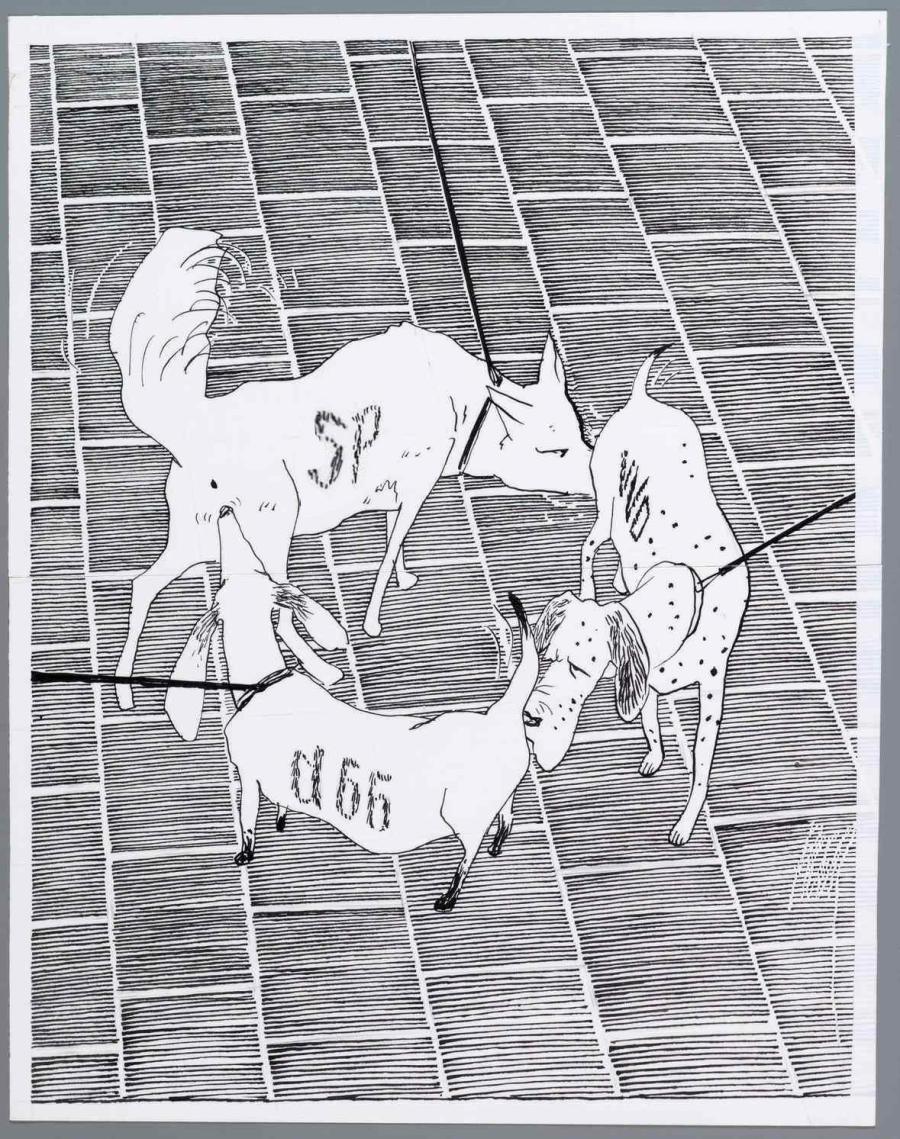
D66 + VVD + SP: SNUFFELFORMATIE AMSTERDAM
oftewel de SP als hond in de pot
…hoefde slechts 3 letters weg te halen en 1 letter toe te voegen aan deze 1998 prent van Peter van Straten (1) om deze weer actueel te maken….
BASTAARDISERING van de gemeentepolitiek of hoe daar waarvoor je dacht geGESTEMD te hebben, alsnog een andere beSTEMMING krijgt door KRUISBESTUIVING, of moeten wij het zien als een honden-monsterverbond, zo’n ‘mariage à trois’, deze nieuwe “Troika aan de Amstel’?
Waarom is het dat de SP, die het goed deed in de oppositie, nu ‘gouvermenteel’ wil worden en daarmee bijna niet anders zal kunnen bereiken dan vier jaar later afgestraft te worden voor deze 1 tegen 2 combinatie. Als dan D66 en VVD zo graag samen willen besturen, met uitsluiting van het PvdA/GroenLinks koppel, waarom dan niet zo’n potentieel anti-neo-liberaal krachtenveld te steunen door de verleiding van ‘bestuursverantwoordelijkheid’ te weerstaan?
Het streven van VVD & D66 om de laatste (toch al te lichte) beschermende maatregelen van gemeentewege tegen de steeds verder oprukkende toeristenindustrie, van tafel te vegen (“MINDER REGELS, MEER BANEN” leuze van de VVD, lees ‘tijdelijke banen in de toeristenindustrie), hadden dan gestopt of op zijn minst afgezwakt kunnen worden.
De voorgenomen gemeenschappelijke aanval van D66+VVD op de sociale huurwoningen (bestaande verpatsen, nieuwe bouwen voor de hogere middeninkomens) zou zo voorkomen kunnen worden.
Want voor deelname aan een coalitie wordt altijd een prijs betaald. Het akkoord zal paragraven inhouden over zaken waartegen de SP zich in de afgelopen decennia steeds verzet heeft. Wil de SP nu in de hoofdstad bewijzen dat ze wel degelijk in staat is om zich te compromitteren, met andere woorden dat zij wel degelijk regeringsverantwoordelijkheid kan dragen?
Welke strateeg heeft dit verzonnen, dat wat iedere hond nog zonder aan de kont te hoeven snuffelen begrijpt: bij de volgende verkiezingen wordt de SP ‘de hond in de pot’.
—
11/6/2014 Het Parool: “SP ondanks risico’s losgeweekt van links kamp”
http://www.parool.nl/parool/nl/5/POLITIEK/article/detail/3670412…
—
(1) search.socialhistory.org/Record/1097189
Voor een inzicht in welk daadwerkelijk mandaat ieder van deze partijen heeft zie: “Amsterdams Democratisch Palet 2014: hoe een minderheid met D66 zich opmaakt de meerderheid te regeren”
http://www.flickr.com/photos/7141213@N04/14071513838/
Amsterdams Democratisch Palet 2014: hoe een minderheid met D66 zich opmaakte om de meerderheid te regeren
Posted in Amsterdam history, Amsterdam World Village, Dutch politics, Parliamentarian system limits, tagged Amsterdam verkiezingen 2014, gemeenteraadsverkiezingen, meerderheidsbeslissingen, parlementair stelsel on March 20, 2018| Leave a Comment »
Oorspronkelijk geplaatst op mijn Flick news-tableau site op 24 mei 2014
Leerzaam omdat met ons kiesstelsel gebaseerd op “democratische meerderheden” van de helft +1 en je stem mogen uitbrengen op een kandidaat zonder optie om deze binnen een tijdsperiode van anderhalf duizend dagen terug te roepen omdat dee volksvertegenwoordiger (en de bijbehorende partij) iets heel anders aan het doen is dan wat zij/hij eerst voorgaf. destijds geplaatst in een kleine serie ‘onkieswijzer’
“Amsterdams Democratisch Palet 2014: hoe een minderheid met D66 zich opmaakt de meerderheid te regeren”
“Voordeel in de stad op vertoon van stempas” was een gemeentelijke campagne in de dagen voor de raadsverkiezingen van dit jaar. Het resultaat van deze campagne is nihil geweest, of men moet een stijging van het opkomstpercentage van 50,3 naar 51,4% een succes willen noemen.
Zelfs voordat de definitieve uitslag bekend was trompetterden enkele deelnemende partijen al over hun VERKIEZINGSZEGE, daar waar er beter over een NEDERLAAG gesproken had kunnen worden met het nu al decennia lang als ‘normaal’ aangemerkte wegblijven van de helft van het electoraat.
Daar waar het aantal nieuwe te verkiezen partijen sterk is toegenomen is er een afname van het aantal stemmen dat zij krijgen. Het opmerkelijke feit dat maar liefst 11,8% van de geldige stemmen uitgebracht werden op partijen die onvoldoende aanhang wisten te verwerven om de kiesdrempel over te komen (die formeel kiesdeler genoemd wordt, het aantal geldige stemmen gedeeld door het aantal beschikbare raadszetels). Dat waren in het totaal 43.944 stemmen die als VERLOREN beschouwd moeten worden. Daarbij komt dan nog de diffuse groep van stemmen die of blanco waren of ongeldig verklaard zijn door het stembureau (5.193 stuks). (2)
Een goed systeem, om al degenen die vinden dat er onder het aanbod aan partijen & politici niets te kiezen valt, een kans te geven hun standpunt publiek te maken ontbreekt ‘de facto’, daar waar het ‘de jure’ wel mogelijk is.
De helft van het electoraat dat het af laat weten wordt nog wel in de aanloop naar weer een nieuwe verkiezing genoemd, als medeburgers die gemotiveerd zouden moeten worden, maar de dag na de verkiezingen al wordt er over hen (zeker in Nederland en nog meer in Amsterdam) niet meer gerept.
Partijen en politici willen dat onaangename gemis aan vertrouwen, of uitdrukking van burgerlijke luiheid, zo snel mogelijk vergeten.
Vervolgens wordt er met het afgegeven vertrouwen, het kiezersmandaat dat wel gegeven is, omgegaan op een wijze die weinig respect laat zien voor de getalsmatige volkswil. Politici zijn er meester in om hun feitelijk verlies als winst te presenteren.
Het uiterst relatieve gegeven van ‘de grootste’ partij (pal in het zicht van precieze verkiezingsuitslagen die ik hier boven ter overdenking in kaart gebracht heb) wordt dan als ‘ongeschreven voorschrift’ gehanteerd in weerwil van het feitelijke getallen-landschap om een leidende rol te spelen bij de formatie van een gemeentelijke regering. Dit laatste omdat in Nederland vrijwel nooit één enkele partij of zelfs niet twee genoeg stemmen krijgen om de zo gewenst de helft + 1 te bemachtigen.
Niet een ‘consensus’ model dat poogt de stemverhoudingen als resultaat van de laatste verkiezingsuitslag te vertalen in een gemeentelijke regering, maar het meest primitieve element uit ons parlementair stelsel, de regel dat beslissingen genomen kunnen worden met een stemverhouding van de helft + 1, is de gehanteerde maatstaf voor coalitie-onderhandelingen.
Deze vorm van ‘berekenend’ formeren van een regering, vermaalt vervolgens een groot deel van de nog enkele weken terug gedane verkiezingsbeloften tot ‘gehakt’, ‘half om half’, ‘half en twee kwart’, ga zo maar door.
Zo blind en dwaas kan het dan toegaan dat eerdere coalities en vroegere coalitiegenoten niet langer omarmd of gedoogd worden, maar te vuur en zwaard bestreden. Zo ontstond er gisteren nog – als ik de twitters van de stadsjournalistiek mag geloven – (1) , de situatie waarbij voormalig coalitie-genoot van de VVD, de Amsterdamse PvdA zei niet van plan te zijn tot een nieuwe coalitie met D66 + VVD. Onbegrijpelijk, zeker daar waar dezelfde PvdA landelijk, tegen heug en meug, maar toch, een coalitie met de VVD dagelijks gestalte geeft.
Een ieder die kan tellen en ook in staat is om die getallen ook als ruimtelijke elementen te begrijpen, kan toch zien dat buiten het grote zwarte gat van de stemonthouders, de twee partijen die – relatief – de meeste aanhang hebben D66 en de PvdA zijn. Als aan de wil van de kiezer enig belang gehecht zou worden, door de politici en hun partijen die zich nu suf vergaderen in de Stopera, dan is een basis-coalitie van die twee toch de meest voor de hand liggende oplossing? De VVD kan er dan nog wel bij om een riante “meerderheid’ in de parlementaire rekenkunde, te realiseren: 30 van de 45 raadszetels.
Ook voor de buiten zulk een schip-van-gemeente vallende partijen (SP en GroenLinks) is er voordeel te halen met deze uitmonstering, omdat het hen zal behoeden voor een zware afstraffing van hun volgelingen wegens ‘collaboratie’ in het volgende verkiezingsjaar dat al aan de einder daagt: 2018.
Dit alles gezegd zijnde vanuit een positie van iemand die met geen enkele van deze partijen een enige band heeft, die van alles verweten kan worden, behalve op enige wijze ‘parti pris’ binnen de Amsterdamse partijpolitiek te zijn.
De kleuren van het Democratisch Palet van Amsterdam zijn ‘flets’ als je ze percentagegewijs weergeeft volgens een vereenvoudigd schema van BLAUW voor Liberalen (D66 en VVD hadden niets voor niets aan lijstovereenkomst in het jaar 2014) (3) en ROOD voor de Socialen. Deze kleuren geven heel effectief het ‘kiezers-draagvlak’ aan (de primaire kleuren BLAUW en ROOD hebben een transparentiepercentage (op een witte achtergrond) gekregen dat overeenkomt met het hen toegekende percentage van het totaal aantal uitgebrachte stemmen in de stad. BLAUW (D66/VVD) wordt dan tot licht- en lichter-blauw en ROOD (PvdA/SP/GL) wordt tot gradaties van roze. Zouden wij deze kleurpercentages op het grote ZWARTE vlak leggen – dat al diegenen representeert die om wat voor reden dan ook niet gekozen hebben – dan blijven – ik heb het zojuist nog even uitgeprobeerd in Photoshop – enkel D66 en de PvdA heel vaag zichtbaar, de rest verdwijnt uit het zicht.
Partijpigment is zelden lichtbestendig en een zwarte ondergrond dooft de meeste kleuren.
—-
(1) Tweet ontvangen op 23/5/2014
Bas Soetenhorst
@bassoetenhorst
@tjebbe PvdA weigert coalitie met VVD en D66 #formatie020
Reply Retweet Favorite More
10:31 AM – 23 May 2014
(2) Tabel 1 Uitgebrachte geldige stemmen, blanco/ongeldige stemmen, kiesgerechtigden en opkomstpercentage bij de verkiezingen voor de Gemeenteraad, 2010 en 2014 )op pagina 6)
www.os.amsterdam.nl/pdf/2014_gemeenteraad_definitieve%20u…
(2) 17/3/2014: “ONkiesWIJZER aan de “Linkse kiezer”: Lijstverbinding D66 + VVD = asociaal-neo-liberaal VVD66″
https://limpingmessenger.com/2018/03/20/onkieswijzer-aan-de-linkse-kiezer-lijstverbinding-d66-vvd-asociaal-neo-liberaal-vvd66-herhaald-bericht-in-2018-uit-2014/
zie ook:
– 20/5/2014: “TRAMHALTE STOPERA mei 2014 – aangepaste dienstregeling met “En nu vooruit met nieuw elan: D66 Amsterdam”
https://limpingmessenger.com/2018/03/20/tramhalte-stopera-mei-2014-aangepaste-dienstregeling-met-en-nu-vooruit-met-nieuw-elan-d66-amsterdam/
– 20/5/2014: “Jan Paternotte D66 OMKEER of INKEER van de zegevierder: het Canossa aan de Amstel gaat over Paars”
https://limpingmessenger.com/2018/03/20/jan-paternotte-d66-omkeer-of-inkeer-van-de-zegevierder-geen-paars-maar-donker-bruin/
Over het vol optimisme op 18/4/2014 aangekondigde ‘Groene Akkoord met GroenLInks” dat niet bestand bleek tegen andere partners dan D66 + GL; zie mijn commentaar: “D66 + GroenLinks “HET GROENSTE AKKOORD IN AMSTERDAM” = Totale Uitverkoop Van Sociaal Wonen”
https://limpingmessenger.com/2018/03/20/akkoord-d66-groenlinks-totale-uitverkoop-van-sociaal-wonen-ging-niet-door-in-2014-maar-zal-het-gaan-in-2018/
HALBE ZIJLSTRA LOOG OP HET SCHOOLPLEIN VAN DE POLITIEK
Posted in Amsterdam World Village, Uncategorized, tagged fluistercampagnes, Halbe Zijlstra (VVD), iHitNews, Kremlinwatchers, politieke leugens, Putin/Poetin, schoolplein van de politiek, van horen zeggen on February 12, 2018| Leave a Comment »
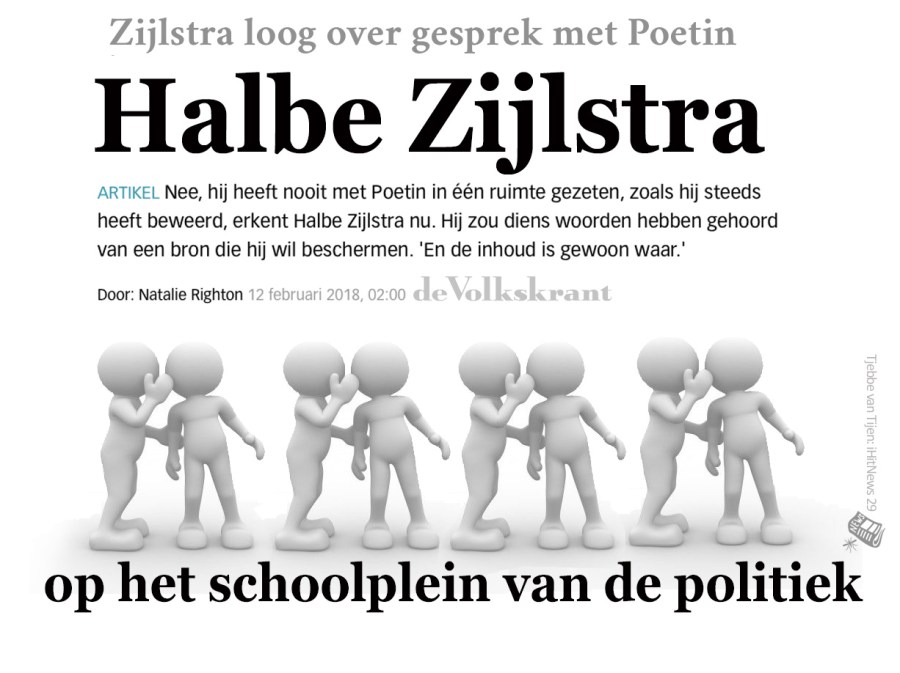 Wie een beetje Russische geschiedenis kent weet dat ‘het van horen zeggen’, van de diplomatieke post uit de tijd van Catherina II en haar sterke man Grigory Potemkin , tot de Lenin, Stalin en andere Kremlin ‘watchers’ fluistercampagnes, haar logisch vervolg gekregen heeft met de ‘welingelichte kringen’ van het Poetin-tijdperk… Of dit van horen zeggen Правда’ (Pravda/Waarheid) is, hele, halve of verdraaide, niemand die het echt kan ontkennen of echt kan bevestigen. Wat ‘gezegd’ is of ‘gezegd zou zijn’ is daarmee nog niet gedaan, dat is wél zeker. Het construeren van een dreiging, het instandhouden van ‘de entente’, het creëren van ‘hoop’, al dat passeert van mond tot oor in het kwadraat en in dit fluisterspel veranderd de oorspronkelijke boodschap nog al eens, al was het maar door een bewust of onbewust misverstaan of misverstand. Zo gaan we een oorlog aan die voorkomen had kunnen worden of het omgekeerde.
Wie een beetje Russische geschiedenis kent weet dat ‘het van horen zeggen’, van de diplomatieke post uit de tijd van Catherina II en haar sterke man Grigory Potemkin , tot de Lenin, Stalin en andere Kremlin ‘watchers’ fluistercampagnes, haar logisch vervolg gekregen heeft met de ‘welingelichte kringen’ van het Poetin-tijdperk… Of dit van horen zeggen Правда’ (Pravda/Waarheid) is, hele, halve of verdraaide, niemand die het echt kan ontkennen of echt kan bevestigen. Wat ‘gezegd’ is of ‘gezegd zou zijn’ is daarmee nog niet gedaan, dat is wél zeker. Het construeren van een dreiging, het instandhouden van ‘de entente’, het creëren van ‘hoop’, al dat passeert van mond tot oor in het kwadraat en in dit fluisterspel veranderd de oorspronkelijke boodschap nog al eens, al was het maar door een bewust of onbewust misverstaan of misverstand. Zo gaan we een oorlog aan die voorkomen had kunnen worden of het omgekeerde.
Halbe Zijlstra lijkt mij iemand die van jongsaf aan groen achter de oren was en dat zijn leven lang zal blijven… het is verontrustend dat zo’n politieke kleuter ons buitenlandbeleid bestierd.
[iHitNews nummer 29]
ref: “Halbe Zijlstra geeft leugen toe: ontmoeting met Poetin heeft nooit plaatsgevonden // Minister Halbe Zijlstra van Buitenlandse Zaken heeft jarenlang gelogen over een ontmoeting met Vladimir Poetin. In tegenstelling tot zijn eerdere beweringen was de VVD’er in 2006 niet aanwezig op een bijeenkomst met de Russische president in diens buitenhuis. Premier Mark Rutte is al ‘enkele weken’ op de hoogte van het nepverhaal.” Lees verder de De Volkskrant site
#WijZijnAmsterdam hekje voor 2018
Posted in Amsterdam World Village, Uncategorized, tagged #Iamsterdam, #WijZijnAmsterdam, mass tourism, massatoerisme on December 31, 2017| Leave a Comment »
[iHitNews 20 31/12/2017]
als er enkel nog ‘gasten’ zijn in oude binnensteden
gaat ‘gastvrijheid’ er ten onder
maak alle steden zo aantrekkelijk
dat je er het hele jaar wilt vertoeven
zonder op reis te gaan
~
if there only guests in old inner towns
hospitality will be drowned there
do make all towns so convivial
that one would like to dwell there the whole year
without the need to travel
Gay Pride Canal Parade 2012: who is next to come out?
Posted in Amsterdam World Village, Discrimination, Dutch politics, Emancipation, Sexuality, tagged Canal Parade, Gay Pride 2012 Amsterdam, institutionalisation of emancipation movements on August 8, 2011| 1 Comment »
Gay Pride 2012, who is next to come out? The Dutch army and the National Bank (DNB) are only a few official institutions that participate with a boat of their own in the yearly Canal Parade of Gay Pride Amsterdam. The museum and cultural sector is presented with their own boat (Amsterdam Museum | Bijbels Museum | De Nieuwe Kerk Amsterdam | EYE/Filmmuseum | FOAM | Hermitage Amsterdam | Het Concertgebouw | Het Nationale Ballet | Joods Historisch Museum | Koninklijk Concertgebouworkest | Museum Van Loon | Nationaal Historisch Museum | Nederlands Bureau voor Toerisme en Congressen | Nederlands Philharmonisch Orkest | Ons’ Lieve Heer op Solder | Rijksmuseum | Scheepvaartmuseum | Stedelijk Museum | Tassenmuseum Hendrikje | Tropenmuseum | Van Gogh Museum) a never ending list. Even the government has their own (contested) boat – though the prime minister – Rutte – choose to profile himself at a more straight mass party around the corner on the same day as the Canal Parade: ‘Dance Valley’ . A Dutch Hindu boat was a newcomer this year following the trend of Christian, Islam and Jewish gay representation, during an event that seems to aim at embracing ‘the whole’ of Dutch society. But certain key sectors of the Netherlands keep ‘missing the emancipation boat’, fail the institutionalised ‘coming out’: Dutch football business, the Dutch Royal House of Orange (and they have several nice boats ready to take part) and a boat of a section of this society that is thought to consist mainly of macho heteros, the Dutch Mafia. Here is an underworld that should be targeted, stimulated to ‘come out of their closets’. One can already enjoy the vision of a ‘parade of sails’ of hash and cocaine boats chaperoned by armoured speedboats, with the crew dressed in proper t-shirts and sunglassed criminals with their water-pistols doing ‘bang, bang, bang’.
Musea zonder H van Historisch: toeristische trekpleisters op het zere verleden
Posted in Amsterdam history, Amsterdam World Village, Museums, National propaganda, tagged Amsterdams Historisch Museum (AHM), Hermitage aan de Amstel, Joods Historisch Museum (JHM), museumkritiek, Nationaal Historisch Museum (NHM), onthistoriseren van musea, schuilmusea on December 24, 2010| 1 Comment »

Kop van Het Parool vandaag: “Amsterdam Museum, zonder Historisch.”
Dat beweer ik nu al weer geruime tijd: “die ‘H’ in de naam van het ‘Amsterdams Historisch Museum’ is een letter en een woord teveel. Een museum dat niet langer in staat is het verleden steeds weer kritisch te hereiken (*), mag zich geen ‘Historisch’ Museum noemen, maar verwordt tot een uitstalkast van oude voorwerpen die als enig doel hebben om genoeg pannenkoeken en prentbriefkaarten te verkopen middels de museumkantine en -winkel, om de ‘oudheidkamers’ tussen Kalverstraat en Nieuwe Zijds draaiende te houden.
Vanaf januari wordt het ‘AHM’ dus kortweg ‘AM’ en dat past perfect in de looproute van ‘de toeristische trekpleisters op het zere verleden’, van Anne Frankhuis en Madame Tussaud, tot Rembrandthuis en een ander museum – dat gezien haar tentoonstellingsbeleid van de afgelopen decennia – wellicht ook het recht op die letter ‘H’ dreigt te verliezen, Het Joods Historisch Museum aan het Jonas Daniel Meijerplein (**). Als we de trekpleisterroute vervolgen en de brug bij de Weesperstraat oversteken en langs het voormalig ouden van dagen huis het Amstelhof lopen is er nog een museum dat de letter ‘H’ al bij haar openingstentoonstelling heeft moeten inleveren: de ‘Ermitage aan de Amstel’, met haar kritiekloos etaleren van de pronkstukken van het door lijfeigenen rijk geworden geslacht van de Romanovs met vermijding van het historisch verband tussen het autocratisch tsarisme en het daaruit voortgekomen Sovjetbewind. Niet voor niets was zowel Koningin Beatrix als President Dmitry Medvedev bij de opening (met in het gevolg ook nog de toenmalige CEO van de Koninklijke Shell Jeroen van der Veer die de gelegenheid aangreep om een nieuwe deal over olievelden in Siberië aan te kaarten).
Ook het bijna doodgeboren ‘Nationaal Historisch Museum’ dat zich vanaf januari 2011 – eveneens in Amsterdam – schuil gaat houden in een kerk aan de Sint Anthoniesbreestraat dreigt het zonder ‘H’ te moeten stellen, omdat het bij decreet vastgestelde aantal vensters op de nationale geschiedeniscanon, nauwelijks binnen de eerdere genoemde definitie van het bijvoeglijke naamwoord ‘historisch’ te vatten is: ‘het verleden steeds weer kritisch hereiken’. ‘Nationaal Museum; is korter en dekt ook beter de door voormalig SP kamerlid Jan Marijnissen geformuleerde taakstelling van het bevorderen van een ‘neo-nationaalbewustzijn’ (***).
Duidt dit jongste gebeuren op een ware trend van onthistorisering van musea, zeker nu er van regeringswege verklaard is dat musea met onvoldoende bezoekersaantallen niet langer op rijkssteun mogen rekenen? Hebben ‘de succesvolle managers’ het niet al lang overgenomen van ‘de studieuze wetenschappers’ in de directiekamers van onze lokale en nationale erfgoedinstellingen? Een tentoonstellingsbeleid gericht op ‘kassakrakers’ ligt in het verschiet, waarbij de ‘de historie’ zeker overleven zal, zij het uit het zicht, in goed verborgen ‘schuilmusea’.
—
(*) …zoals met de éénzijdig royalistische Oranjetentoonstelling van scheidend directrice Pauline Kruseman (nu nog Vicevoorzitter Raad van Toezicht Nationaal Historisch Museum); ‘Theater na Tomaat’ een buitenshuis samengestelde, slordige tentoonstelling, waarbij zelfs het jongste verleden onvoldoende bestudeerd was en onbestaande verbanden als historische feiten gepresenteerd werden (zie een meer feitelijke beschrijving op mijn web site); de viering van “Vier eeuwen vriendschap” tussen Amsterdam en New York met totale verwaarlozing van zowel het weinig succesvolle en ook gewelddadige kortstondige Hollandse bewind aldaar en met een algeheel negeren van de revolutionaire ideeën van de 17e eeuwse Amsterdammer Franciscus van den Enden en zijn utopische visie voor een nieuwe volksplanting op de plek die later New York is gaan heten: “Kort Verhael van Nieuw-Nederlant” (1662). Dit laatste is wel de allergrootste gemiste kans van een museum in jaren, om zo’n hinderlijk ‘zoveel eeuwen’ jubileum niet aan te grijpen om een onderbelicht deel van de geschiedenis onder de aandacht te brengen. [n.b. Wim Klever heeft verschillende teksten van Francsicus van den Enden opnieuw bezorgd en van commentaar voorzien]
(**) …het Joods Historisch Museum ziet het niet als haar taak om de lokaal pijnlijke geschiedenis van de efficiënt georganiseerde deportatie van Joden vanuit Amsterdam pregnant in beeld te brengen (de beruchte Gemeentelijke planningskaart voor het Joodse Ghetto van Amsterdam hangt wonderlijk genoeg verderop in Het Verzetsmuseum). Museumprojecten die jonge generaties Amsterdammers kunnen helpen om een ander inzicht te geven in de geschiedenis van het Jodendom en hun vervolging worden node gemist. Wat steeds ontbreekt bij het vormen van een eigen inzicht is de onaangename geschiedenis van de medewerking – van zowel Nederlandse autoriteiten als vertegenwoordigers van de Amsterdamse Joodse gemeenschap – aan de deportaties. Zo’n zelfkritische historische benadering is een voorwaarde om een beter debat over het huidige door oppervlakkige argumenten gestuurde anti-semitisme mogelijk te maken.
(***) Jan Marijnissen: “Een volk zonder geschiedenis bestaat niet. Elk volk, ook het Nederlandse volk, heeft dus een geschiedenis. De hedendaagse verwarring over onze morele, culturele en politieke identiteit vindt voor een deel haar verklaring in het ontbreken van historisch besef in brede lagen van de bevolking.” Voor eerder commentaar op het 19e eeuwse idee van een ‘Nationaal Historisch Museum’ aan het begin van de 21e eeuw zie mijn post “Good news: plan for new National Historical Museum of the Netherlands cancelled” op dit blog.
Amsterdam shopping: courtesy slips away while turnover is on the rise.
Posted in Amsterdam World Village, Urban questions, tagged discrimated eldery, shopping arcades, snow, uitglijden on December 18, 2010| Leave a Comment »
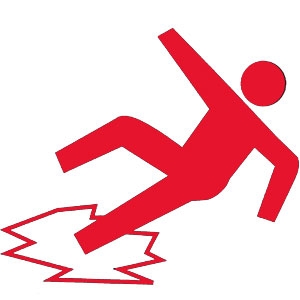
Uitglijden = to slip and modern Dutch society always eager for making a big bug without showing any courtesy is at its merciless best these days with regular snowfall.
The main shopping arcade street, Kalverstraat – good for a turn over of many millions these holy consuming days – has a parade of hundred thousands of unstable tripping shoes as not a penny is invested in doing anything about the slippery mass on the pavement.
One may observe fragile older people making their unescorted foray for their daily milk and bread up the slippery stairs of the biggest luxurious supermarkets of Albert Heijn in the inner town (because often that are the only shops left in the area), with the multinational food chain not making any effort to help these customers, handicapped by the uncommon weather conditions…
This is turning a ‘happy white christmas’ into ‘a white terror’ for those who have come to an age where a slip will not be followed by getting up again for a long while… The Netherlands stronghold of discourtesy. The Netherlands paradise of eager egoists.
Whereby an extra stimulus for falling is offered by the polished expensive natural stone surfaces in these fashionable shops which have never been tested in such thousands of wet shoes entering conditions. My guess is that architects nowadays do not know anymore about the need of a good grip of a shoe sole on pavement and floors… and liability because of neglect of shopkeepers or municipality in such circumstances is hardly a known phenomenon in the Low Countries.
Are we too childish to prevent child abuse?
Posted in Amsterdam World Village, Sexuality, tagged child abuse, pedo hysteria, pedophilia on December 14, 2010| 4 Comments »

Asphalt-Art in the Dutch dunes at Wassenaarseslag picture taken summer 2010: flames have burned this schablone of peaceful walking into the hot asphalt of the meandering road to the beach, to put everybody in their own protected trajectory: pedestrians and bicycles alike, both having joint access to this path.
As with all pictures there is a new reading of the image, not at all intended by its designers – say three or four decades ago. The new reading = pedophilia… this because yet another case came up of a man misusing his position in a children care center in Amsterdam. This time it is not the Catholic Church… so they must be a tiny bit happy in the Dutch bishops rooms and Rome…about the latest news it is not only “us” misbehaving.
Yes indeed, effects of human desire can be as bad as that and as nice as if in heaven…. Little nude angels are haunting churches and museum walls alike all over Europe for centuries, but innocence has always been hard to protect here on earth. If the sensational news coverage of such criminal behaviour – as now in Amsterdam case – will have any positive effective can be doubted.
How do societies deal with deviance in general? How do they deal with sexual deviance? Children can be endangered both at home and in any institution. We should be so honest at least to recognise such a fact. Maybe we lack time and interest in studying and getting to know our own human behaviour in all its manifestations… Maybe we are too childish to prevent child abuse.
Tuesday December 14th. 2010
”Men and child nurseries a charged combination” is a heading of the Dutch daily “De Volkskrant” today. A comment on a recent case of child abuse by a man working as a child care taker. Gender discrimination is unsubtle introduced by a journalism that tries to wip up an exception to such an extant that it seems to have become the rule.
Bygone are the days of gender emancipation, like the White Childrfen Plan (witte kinderenplan) born from the Amsterdam Provo movment in the mid sixties. I was one of the parents volunteering one or two mornings a week to care for our children in the creche in the Keizersstraat. Later this volunteer roulating system has been taken over by a man, Siem, who has been a fantastic child care taker for several decades (Siem died a few years ago at a too young age)…
The proposed solutions for controlling deviant behaviour now-a-days tend to be of the same order: screening, video cameras, databases. The absurd end of such a pedo-fear driven policy line would be ‘in vitro’ conception of children and gender and age apartheid.
Visualisatie en Ljoedmila Chodynskaja: Laten we een wandeling maken door Amsterdam
Posted in Amsterdam World Village, Psychogeography, Visual Language, tagged Denis Loffe, Людмила Ходынская, Ljoedmila Chodynskaja, russische dichtkunst (vertaald in het Nederlands) on November 6, 2010| Leave a Comment »
laten we een wandeling maken door Amsterdam
het over marihuana hebben
de avond spreidt zachtjes de gesprekken uit
de avond omsnoert stevig de blikken
laten wij ons haasten om naar de jazz van de regen te luisteren
in het ‘Alto’ van nachtelijk Amsterdam
ouderwets met zijn tweeën bij de schoorsteen
zonder liefdesverklaring… dat voor
de noot regen
vloeide samen met de noot jazz
tot de compositie van nachtelijke extase
de noot regen
haalde de gril van de snaar er tot het uiterste uit
om de toonladder ‘wij’ te spelen
laatste versie van de visualisatie van het gedicht…klik beeld voor grotere weergave
Vanmorgen vond ik in mijn brievenbus het Tijdschrift voor Slavische Literatuur van oktober/november 2010, eenvoudig uitgeven, altijd met verfijnde inhoud en deze keer trof mij het werk van de in Amsterdam wonende Russische dichteres Ljoedmila Chodynskaja (Людмила Ходынская) met een inleiding van Denis Ioffe in een vertaling van Willem Weststeijn. De stad waar ik woon, gezien en gevoeld door onNederlandse ogen en andere zintuigen, heeft mij altijd aangetrokken, omdat ik vaak moeite heb deze stad nog met een blik zonder oordelend weten te kunnen zien. Als lezer van de ervaring van een ander, kan ik mij op deze wijze weer een eigen beeld van de stad Amsterdam maken. Tijdens het lezen kwam mij een recente – onbeduidende – foto die ik op een late avondwandeling maakte in gedachte, zo’n foto waarbij de sfeer van het moment je omarmt en tegelijk vervliegt als je dat met een camera probeert te vangen…

…en met een paar Google Image zoektochtjes en Photoshop-handelingen vloeiden enkele – wellicht al te letterlijke – beeldassociaties daar doorheen. Het eerste probeersel staat hieronder en kreeg direct al de zelf-dis-qualificatie ‘kitsch’ door de erotische suggesties van het gedicht middels het gezicht van een genietende dame en het teveel aan andere toegevoegde beeldelementen. Het bekende probleem van het dupliceren van wat in de tekst staat met beeld, alsook het onvermogen van beeld om de werking van poëzie te imiteren. Picturale bouwstenen laten zich niet volgens dezelfde principes als woorden stapelen: avondbeeld van de Amsterdamse grachten + silhouette van hand in hand wandelend stel + gesolariseerd beeld van een marihuanaplant + door ritmische muziek gestuurde lichtpatronen + vrouwengezicht tijdens het bedrijven van de liefde (eigenlijk een pornografisch beeldcliché). Dit alles bij elkaar leverde onderstaande soeppige prent op.
Hieronder de vereenvoudigde latere versie…. direct onder het gedicht staat steeds de laatste versie. Klik platen voor groeter beeld.

Bij al de mogelijkheden die de elektronische montage en collage te bieden heeft is het zo dat – gelijk aan muziek en poëzie – de suggestieve ruimte tussen de klanken, tussen de door woorden opgeroepen beelden – het doelbewust weggelatene – even belangrijk is als dat wat aan beeld ingebracht wordt. De selectie gevolgd door de deselectie. Theoretisch gesproken weet ik het al lang, het gaat meer om de opgeroepen persoonlijk gemaakte (idiosyncratische) associaties met een tekst dan om de verdubbeling van het geschrevene en gelezene, zoals bij de toelichtende tekening, de illustratie, de al te letterlijke ‘ licht werpende verduidelijking’. Daar waar ik mij een associatief beeld wenste ben ik geëindigd met een illustratief beeld. Het resultaat van mijn oefening om dat wat met een mooi woord ‘psychogeografische visualisering’ genoemd kan worden, toe te passen op een gedicht van Ljoedmila Chodynskaja blijft onbevredigend. In eerdere visualisatie-studies van teksten van anderen, gebruikte ik meestal niet een rechthoekig kader, maar een perspectivische bol, zoals in de studie van de ‘literaire pyschogeografie’ van Edo Tokyo. De vertekening van de (glazen) bol, geeft in zijn vorm al aan dat het om een ‘reflectie’ en niet om een ‘projectie’ gaat. Wellicht moet ik die methode ook voor dit gedicht proberen toe te passen. Jammer genoeg is mijn camera met een vissenoog lens kapot en zal ik het door middel van een meetkundige vervorming met gebruik van software moeten proberen. Dat is voor later. Eventuele resultaten zal ik toevoegen aan deze zelfde ‘posting’ op dit blog (via Comments RSS functie button – die enkel zichtbaar is als er één enkele post bekeken wordt – kunt u toevoegingen laten signaleren). Degene die zich geroepen voelt het zelf anders en/of beter te doen…. aarzel niet, files kunnen naar info@imaginarymuseum.org.
Hieronder documenteer ik de visualisatie-oefening, iets wat ik eigenlijk nooit doe, dit om de redeneringen tijdens het maken van beeld – die anders in het hoofd blijven – nu eens met woorden proberen weer te geven:
[Zondagavond 7 november: Toch nog het element uit het gedicht van de snaar erbij gestopt… heel letterlijk iemand die jazz gitaar speelt “haalde de gril van de snaar er tot het uiterste uit”. Elegante handen die de snaren beroeren en vrouwelijke rondingen, ook weer zulke onontkoombare beeldassociaties.
[Maandag 8 november tijdens een koffiepauze: Het hand in hand wandelen silhouet blijft een irritant ‘banaal’ element, ondanks de lichte transparantie met de achtergrond. Wat maakt iets ‘banaal’ is dan de vraag, die beantwoord moet worden. Het tussendoor onderzoek gaat verder tj.]
[Maandag 8 november in de vroege avond: het silhouet zag er ‘banaal’ uit door de houterigheid van de vereenvoudigde uitsnede. De linker figuur meer uit het beeld geplaatst waardoor het afwijkend perspectief van deze ingeplakte figuren minder zichtbaar is; iets transparanter gemaakt en wat in kleur verschoven ten opzichte van de doorschijnende achtergrond. De golflijn van de gitaar komt er nu mooi doorheen en verbindt de hand in han d wandelaars met het gitaarspel; dat effect wat versterkt door het contrast van de beeldlaag met het bespelen van de gitaar wat te verhogen.]
Elektriese hoenkie boenk dreunkasten “bij ons in de Jordaan”
Posted in Amsterdam World Village, The downside of leisure industry, tagged akoestische traditie, hoenkie boenk (overal doorheen dreunende electronisch versterkte muziek met een volume boven de 80 dBA), Jordaanfestival, lawaaioverlast, unplugged music on September 2, 2010| Leave a Comment »
In het Parool van vandaag staat een stukje “Is één Jordaanfestival niet genoeg?” over de stammenstrijd der Jordanezen en hoe twee festivals die het nooit zo bestaande verleden van deze roemrijke buurt in herinnering denken te roepen elkaar op leven en brood beconcurreren om wie het meest lawaai mag gaan maken.
De stekker eruit! Dat lost alles op…. gewoon autistisch en akoestisch blèren voor wie er lol in heeft en er vlakbij omheen gaan staan. Vooruit een accordeon maakt genoeg geluid en “als je niet genoeg stem heb dan doe je het maar voor je eige onder de doesj” Het is de bulderboks, het is de ritmeboks en de elektriese dreunkasten die er een probleem van maken… Terug naar de wortel van de Jordaan en als je zonodig een podium nodig hebt neem dan een stijfselkissie om op te staan. Nog beter is er een werkelijk Jordaanfestival van te maken, voor de hele Jordaan, alle straatjes en grachtjes krijgen een beurt… niets is mooier als het aanzwellen en wegstervende van de klanken van een lopend orkestje in de stadsruimte. Dat is het enige werkelijke alternatief voor de door velen verafschuwde dronkenlappen aantrekkende elektronische ‘hoenkie boenk terreur’.
World Village Amsterdam: “This station is closed” decline of public services in a segregated city
Posted in Amsterdam World Village, tagged Amsterdam public transport, Amsterdam subway, Bijlmer-ghetto, discrimination, planning failures, tourism on August 16, 2010| Leave a Comment »
Today the subway in Amsterdam opens again after being closed for six weeks because of an administrative mistake. This is NO joke, this is the infamous world village of Amsterdam. Working on a tramway or railway or whatever way in this muddy village most often results in closing off for what seems to be an unlimited time, whatever traffic passage may be concerned. The contract with the building firm that was at the basis of the decision to close down the metro for six weeks, was refuted because terms could not be met, but nevertheless the subway was closed down, because as a spokesman said the subway drivers all had been send already with holidays… This left me wondering about the sublime working conditions: 6 weeks in one go? As this is a segregated city – though in full denial of the fact – it is “only” the predominant ‘non-wester-allochtones’ suffered (sorry for the Dutch Apartheid vocabulary, you may need to check Wikpedia for this) that especially need to travel back & forward from the suburban Bijlmer-ghetto to the inner city.
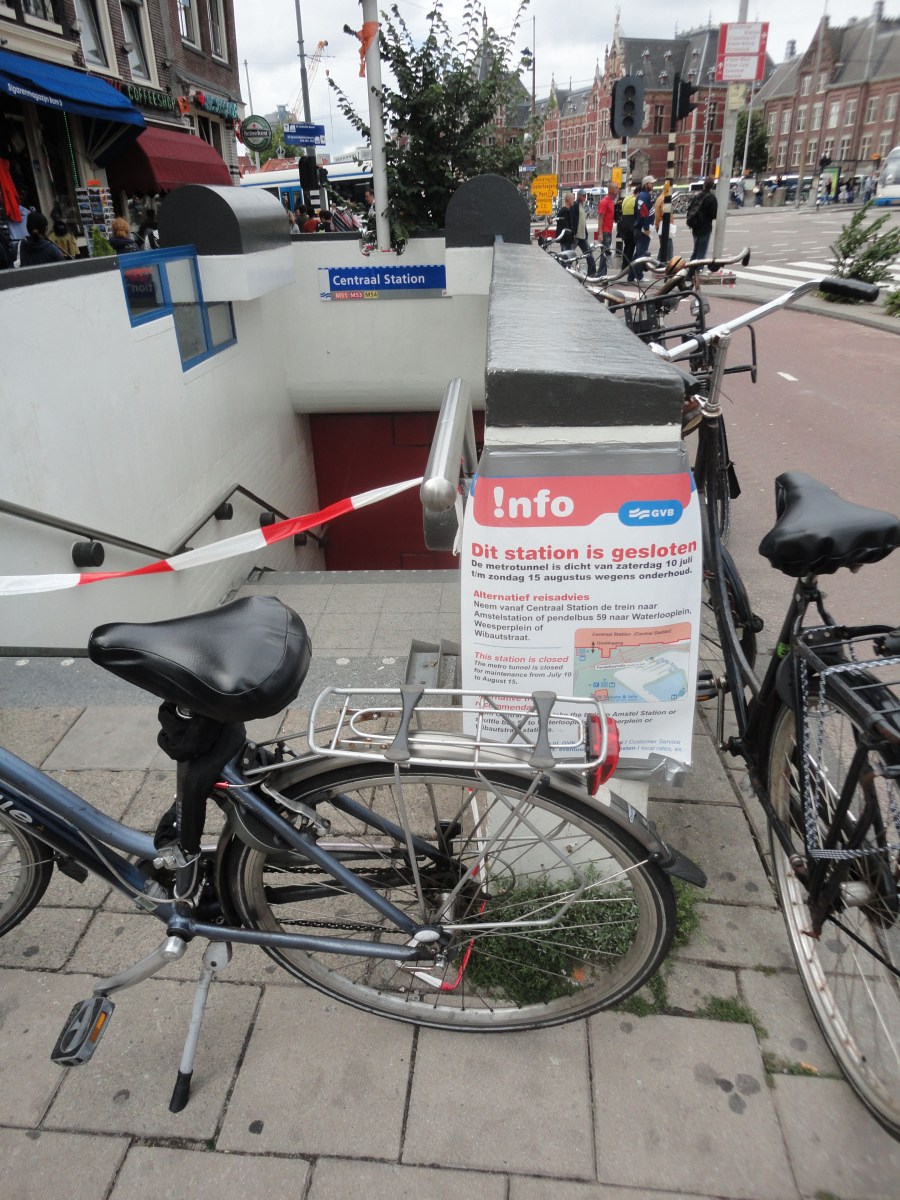
It is (only) thanks to the upcoming SAIL tourist event – where eager entrepreneurs hope to welcome a million extra clients – that the wind will blow some life into the subterranean public transport system. The photograph above shows a clumsy sign at one of the entrances of the subway system at the Central Station. At the most central Waterlooplein subway station that can be seen from my window there was NO sign whatsoever about why the doors were closed, till when and how to get to the Bijlmer-ghetto from here…

Also during six weeks we did not have early morning transport from the centre of town to the main railway station on saturdays and sundays. So I have seen bunches of desperate tourists wandering around in panic because they needed to be at the airport in time and were expecting regular public transport running around seven in the morning, but found the village of Amsterdam still sleeping… tram conductors still not on the road… HAPPY taxidrivers… that is the sunny side of it all. Also this planning mistake has meant some extra income for Polish bus drivers that are usually temporally employed to drive the busses that supply an alternative connection for the closed metro, but do take a completely different route.
I remember now calling the ‘public transport’ information number to find out where these alternative bus stops actually were – because the map on the internet had only big fat lines on a too small scale to discern actual bus stop indications) even the very friendly help desk person was not able to tell me where exactly this bus could be taken in the area around the Waterlooplein. One does not catch an airplane by wandering the streets in the hope to catch a bus and see it race by….

As can be seen on this time table photographed on the Waterlooplein on August 18. 2010 the first tram to the Central Station is planned for 7:41 in the morning. Later we discovered that there were socalled 'night busses' also at this stop that ran still around seven in the morning on sundays BUT surprise surprise the general electronic chip card - which is the only thing that can be used now in Amsterdam public transport - was not valid for the (early morning) 'night bus' as the nigh transport has its own special cards and tariffs. The bus driver being fed up with complaining passengers about this 'wonder of planning' gave my friend - who wanted to go to the railway station - a free drive. So in the end personal solutions are needed to overcome general planning stupidity. Click picture for full size view.
A “segregated city” I said, so let me try to show how this translates into a map for the case of the Bijlmermeer suburb build in the early sixties, conceived in the fifties as an ulimate pure example of the ideas of the CIAM (Congrès International d’Architecture Moderne) with their separation of functions: living, working, recreation, traffic. Later in the eighties and nineties the urban concept has been remoulded into amore classic integrated street model with rows of suburban houses. Maybe the red arrows in the map below should be just blue… as the inhabitants of the Bijlmermeer are commuting on a daily basis to the inner town. The inhabitants of the inner town on the other hand hardly ever will go to the Bijlmermeer.
I have used the word ‘ghetto‘ in the opening paragraph on purpose and in the correct way, it’s common definition being: “an overcrowded urban area often associated with a specific ethnic or racial population; especially because of social, legal, or economic pressure.” Historically speaking the word associates with inner-city areas, but with the expansion of cities and the higher levels of mobility and immigration, the same phenomenon can now-a-days also be found in suburban and satellite cities.
The word ghetto in Amsterdam points to dark pages of its history, the establishment of a Jewish ghetto in the inner city of Amsterdam in 1941 by the German occupying authorities with a surprising level of collaboration by the local authorities. The word ‘ghetto’ for certain inner town areas (Jodenhoek) in Amsterdam was locally used before without the connotation of a waiting room for mass murder.
The Bijlmermeer was a satellite city build in ‘a polder’ (former lake) at some distance of Amsterdam proper. The planned inhabitants were upcoming middle class families which would by there supposed climbing of the social ladder move out of their actual small dwellings in a previous generation suburban garden city area at the west side of the city (Westelijke tuinsteden) to the high rise grand surface apartments to enjoy “licht, lucht en ruimte” (light sky and space). This scheme utterly failed because of too high rents and so many of new houses in the Bijlmer stayed empty untill the moment that an sudden influx of migrants from the former Dutch colony of Surinam took possession. At first by squatting, later through an adapted municipal housing distribution system. The standard definition of the word ‘ghetto’ speaks of “social, legal, or economic pressure”, but what should be added, especially in the case of the Bijlmer is the ‘cultural’ element. The recreation of a living atmosphere, protective feelings of togetherness and so on. Though some urban sociology researchers (“Amsterdam human capital” published in 2003 by Sako Musterd and W. G. M. Salet; page 181-) deny that a real social segregation is developing in Amsterdam on the basis of complex statistical models, I from my side have my own daily life observations that make me conclude the opposite. When one takes a very early morning metro/subway of the Bijlmer to the centre of town (Oostlijn) 2/3 of the commuters are mainly black migrants of whatever generation on their way to the less magnificent jobs Dutch society is offering. The last subway crowd the other way also show a predominantly young and black population who after congregating and partying in the inner city go home, which is for many of them the Bijlmer. From my house window I have observed this development for decades which created another kind of statistics in my mind. These notes will lead me to a an exercise in teh future with more scrutiny to test my hypothesis.
Another (yet) primitive attempt to show the segregated inner city of Amsterdam in relation to the suburb the Bijlmermeer, whereby the size of the arrows display quantity… this needs more study and statistic data to gets its form. For the time being here is sketch 2…

LOKHOLLANDERS TEGEN PROVOCATIE & GEWELD ter verlokking van de Marokkaanse en andere jeugd
Posted in Amsterdam history, Amsterdam World Village, Colonial history, Discrimination, Dutch politics, Memorials, Migration, National propaganda, Nederlandse rechtsstaat, Urban questions, tagged agent-provocateurs, Ahmed Marcouch, Amsterdamse geschiedenis, anti-semitisme, culturele identiteit, gastarbeiders, hoofddoekjes, jodenvervolging, kleding, lokhomo's, lokjoden, Marokkaanse jonegeren, oranjefans, potenrammers, punks, racisme, rechtsprincipes, segregatie, uitlokking van geweld on June 20, 2010| Leave a Comment »
Lokjoden, lokhomo’s, als jood of als homo verklede politie-agent-provocateurs die hierdoor aangetrokken joden- en potenrammers in de kraag gaan grijpen. Recente voorstellen (*) voor Amsterdam met positieve discriminatie als doel, maar in mijn visie zijn het middelen die het doel in de verkeerde richting voorbijstreven. Ook zwaardere straffen voor geweld tegen homo’s behoren mijns inziens tot de categorie van middelen die niet in overeenstemming zijn met het uiteindelijke doel: gelijkwaardigheid van alle mensen. Dat gaat ook op als er gestraft moet worden.

Marcouch wil dat de politie daadkrachtig optreedt tegen daders van antisemitisch geweld. "Ik vind dat je alles moet doen om die etters, die kwelgeesten, die criminelen te pakken." De PvdA'er reageert hiermee op berichten dat joden in sommige Amsterdamse stadsdelen zich niet meer veilig voelen op straat met een keppeltje op. Klik beeld voor link naar artikel op de web site van Amsterdamse lokale televisie AT5.
Ooit waren uiterlijke kenmerken van het tot een maatschappelijke groep behoren van overheidswege opgelegd. Het koloniale bewind van de Hollanders hield – bijvoorbeeld – middels strenge kledingvoorschriften controle over miljoenen onderdanen in Oost-Indië. Inlander, Chinees, Indo en raszuivere Hollanders konden zo keurig op geruime afstand onderscheiden worden door hun kleding en daarmee gemakkelijker in het gelid gehouden worden. Apartheid is niet voor niets een Hollands woord en ergens dringt dit uiterlijk en ruimtelijk gescheiden houden van religies, rassen, klassen en standen, voortdurend in de ‘vaderlandsche’ geschiedenis door: van half verborgen schuilkerken voor niet staats-protestante christenen, tot stegen en sloppen voor de armen net even apart van de grachtenhuizen voor de rijken, van bewaakte asociale dorpen in Amsterdam-Noord tot burgerwijken in oud-Zuid. Segregatie ook in het huidige Amsterdam van Buitenveldert tot Bijlmer, van Grachtegordel tot De Baarsjes.
De relatieve onzichtbaarheid – op straat – van het tot een gemeenschap behoren, in de moderne verstedelijkte samenleving wens ik als een emancipatie te zien. De tegenbeweging met haarbedekking voor vrouwen en geloofsduidende hoedjes en petjes voor mannen lijkt gelijke tred te houden met ander uniformgedrag van neo-punkers tot oranjefans. Als de lokale politie hier zich nu opzichtig als homoachtige homo of joodachtige jood gaat verkleden om, met deze stereotypen een stereotype reactie uit te lokken, bij een doelgroep die door de vele bestraffend wijzende Hollandse vingers in hun ghetto gehouden worden (de Marokkaanse jongeren), dan vind ik dat een handelen dat van een onbeschrijfelijk gebrek aan inzicht getuigt. Uitlokking genereert en bevestigt geweld. Dat dit soort onbezonnen voorstellen ook nog eens een functie van populariteit bevorderende maatregelen voor bepaalde politici hebben maakt het nog eens te meer kwalijk.
Verbetering van hoe wij met elkaar omgaan is niet met dit soort ‘stereotype hypes’ gediend. We kennen de overgeleverde slogans: ‘ze moeten wel met hun poten van onze rot-joden afblijven’ en een enigszins positief bedoeld ‘onze rot-marokkanen’ bestaat ook al enige jaren (uitspraak toebedeeld aan Pim Fortuyn, die er – anders dan Wilders – bij zei dat het daarom ook “ons probleem” was); zo dient een ieder ook met zijn poten van onze ‘rot-poten’ af te blijven. Maar zulke op een gespleten karakter wijzende half-goedbedoelde-leuzen waren en zijn onvoldoende.
Het zijn ‘onze rot-Hollanders’ die maar niet in het reine wensen te komen met hun eigen ‘rot-geschiedenis’ die deel van het probleem zijn, maar het niet van zichzelf willen weten. Als nu eens in plaats van de oranje gekleurde ‘fata morgana’s’ van nationalistische geschiedenis interpretaties en het “Nederland kan het weer! Die VOC mentaliteit…” (Balkenende, 2006), een omslag in het begrijpen van het verleden van dit land zou plaats vinden, dan was daarmee tevens een basis gelegd voor een andere opvoeding en scholing van ‘onze jeugd’, ongeacht hun af- en herkomst. Als de ‘huichelhollander’ het onaangenaam verleden gemaakt door vorige generaties – waarvoor hij/zij zelf niet verantwoordelijk gehouden kan worden – gewoon onder ogen zou zien en dit onverbloemd voor zichzelf en aan de jeugd duidelijk zou weten te maken, dan komt er ruimte voor een mentaliteitsomslag. Leren, uitleggen, begrijpen, hoe joden en homo’s hier in de loop van de geschiedenis in de de verdrukking zijn gekomen, tot aan de onaangename details van registratie, concentratie en deportatie van de meeste Nederlandse joden met medewerking van Nederlandse autoriteiten en joodse notabelen die dachten het onheil te kunnen keren, tijdens de Duitse bezetting. Onder ogen zien hoe de eerste generatie na-oorlogse gastarbeiders hier binnengehaald werden op vrijwel gelijk wijze als de Chinese, Javaanse en Hindoestaanse ‘koelies’ in de nadagen van het Nederlands koloniaal stelsel naar Suriname werden gehaald. Arbeiders die hier decennialang bijgedragen hebben aan de groeiende welvaart en waarvan werkgevers en autoriteiten dachten dat ze even onopvallend als ze binnengehaald werden wel weer zouden verdwijnen. Ik zie nog voor mijn ogen de spandoeken van gastarbeiders-demonstraties op het einde van de zeventiger jaren toen de conjunctuur langzamerhand terug begon te lopen met leuzen als “Wij willen werken”, iets wat Geert Wilders (1963-) geweten had kunnen hebben als hij als tiener zijn ogen had opengehouden.

"Hoe het begon, de vele gezichten van Marokkaans Nederland", een reeks documentaires van de NOS waarin een onthullende oude Polygoon reportage uit 1969 over het ronselen van arbeiders op contract door de Nederlandse regering in Marokko is te zien... de hele serie zou vast onderdeel dienen te zijn van de geschiedenisles op Nederlandse middelbare scholen. Klik plaat om naar de on-line versie van deze videos te gaan.
Als ook de vensters van de ‘national geschiedenis canon‘ vermeerderd worden en de versluierende vitrages weggetrokken worden, opdat massamoord, slavenhandel en tal van vormen van koloniale exploitatie en lokale uitbuiting in zijn volle omvang begrepen kunnen worden, dan is dat de voedingsbodem waarop het zaad van een minder gewelddadige samenleving gezaaid kan worden, waarmee jonge generaties Marokkanen en wie er nog meer behoefte aan hebben tot andere gedachten gebracht kunnen worden. Daarmee en daardoor wordt een leraar – van lagere school tot MBO – in staat gesteld om de Holocaust in een begrijpelijk geheel van gebeurtenissen te plaatsen; dan kan ook de complexe geschiedenis van de Maghreb, de Arabische veroveringstochten, het Ottomaanse rijk, het Franse en Spaanse kolonialisme, de regionale tegenstellingen en het ontstaan van het conflict in het huidige Midden Oosten, begrijpbaar en bespreekbaar gemaakt worden. Ook hier is veel onverkwikkelijks te melden niet enkel ov er de vestiging van de staat Israel en onteigening en ontheemding van de Palestijnen, maar eveneens de tumulteuse Noord-Afrikaanse geschiedenis. Ook daar ligt er een verhullende sluier over het verleden.
Wie de tentoonstellingsagenda van de laatste vier decennia van het Amsterdamse Joods Historisch museum en het Amsterdams Historisch Museum (AHM) kent, weet dat deze door de gemeente gesteunde culturele en educatieve instellingen niet of nauwelijks bij machte geweest zijn om bovengeschetste onderwerpen tot het centrum van een kritisch debat te maken (buiten de uitzondering die gemaakt kan worden voor het onderwerp van homoseksualiteit in het AHM). Met name het Joods Historisch Museum is de grote afwezige als het gaat om deelname aan een bestaand maatschappelijk debat bij de keuze van haar tentoonstellingen. Waarom niet het anti-joodse sentiment bij (een deel van) de Marokkaanse jeugd tot een museum-presentatie of project gemaakt? Waarom is de tragedie van Amsterdam, de constructie van het joodse ghetto, de bureaucratie van de Joodse Raad en het falen van het verzet ertegen niet ter lering en als waarschuwing, in een permanente opstelling in meerdere talen, te zien in dit museum, een verhaal dat dieper graaft en verder durft te gaan dan dat wat nu in het toeristisch lokkertje van het Anne Frankhuis aan verhullen verhaal te zien is?
Een tastbaar monument voor eigen historisch onvermogen zou deze stad sieren. Dat is pas dapper. Daarmee en daardoor valt uit het verleden te leren. Niet het sprookje over ‘Amsterdam die tolerante stad’ die nooit bestaan heeft. Zulk een zelfkritische presentatie zal iedereen zo ver uit de eigen tent weten te lokken dat we elkaar weer recht in de ogen kunnen kijken en op voet van gelijkheid met elkaar over heden en verleden kunnen spreken. Dat is geen politie en justitie taak, dat is een culturele taak, het wordt tijd voor voor LOKHOLLANDERS TEGEN GEWELD met acties ter verlokking van de Marokkaanse en alle andere jeugd.
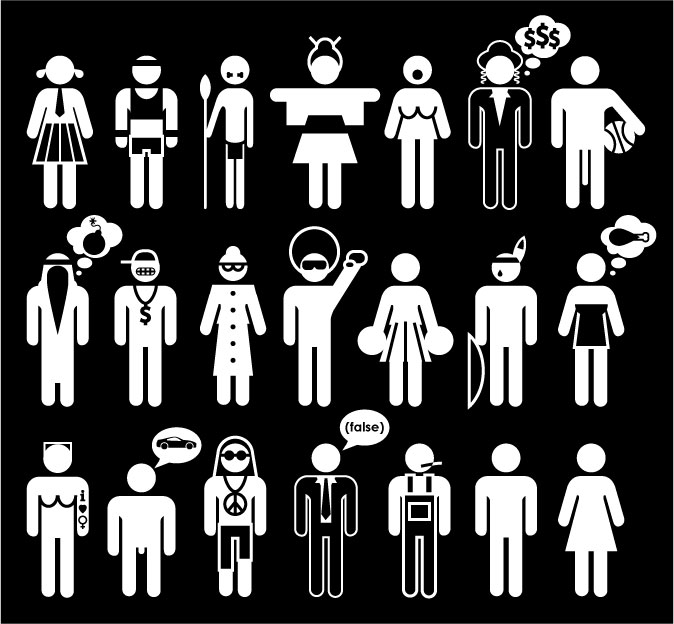
Een reeks iconen met stereotypen, waarvan ik de precieze bron nog niet heb kunnen vinden, maar waarbij het vrijwel zeker gaat om 'teenagers stereotypen'. Het zou goed zijn als een jong talent eens in dergelijke reeks van stereo-typen voor Nederland/Amsterdam zou maken. Vereenvoudigde, schematische beelden zoals die nu bij teenagers bestaan. De benoeming van Marokkaanse jongeren en dan met name Marokkaanse jongens als 'straat-terroristen' (Wilders, 2009/210) is op zich net zo'n stereotype.
====
(*) Recente voorstellen lokhomo’s en lokjoden info & links:
– Omdat dit artikel in de Elsevier van 19 juni2010 enkel gedeeltelijk on-line staat, citeer ik hier in extenso de formulering van René van Rijckevorsel (plaatsvervangend hoofdredacteur van Elsevier) “Is geweld tegen joden en homo’s soms normaal?.” Voor mij getuigt de hieronder gevoerde redeneertrant van een te nauwe focus op een deelprobleem, waarbij dan weer een deeloplossing aangedragen wordt, die meer problemen zal veroorzaken dan oplossen. Dit terwijl de onderliggende fundamentele vraag onbeantwoord blijft, wat dan wel de Nederlandse samenleving is, waaraan als buitenstaanders voelende en behandelde groepen, aangepast dienen te worden. Mij bekruipt een huiver ook door het geciteerde taalgebruik van de heer Marcouch: “Deze jongens hebben een speciale behandeling nodig. Ze moeten geknipt en geschoren worden, voordat ze weer op straat staan.”
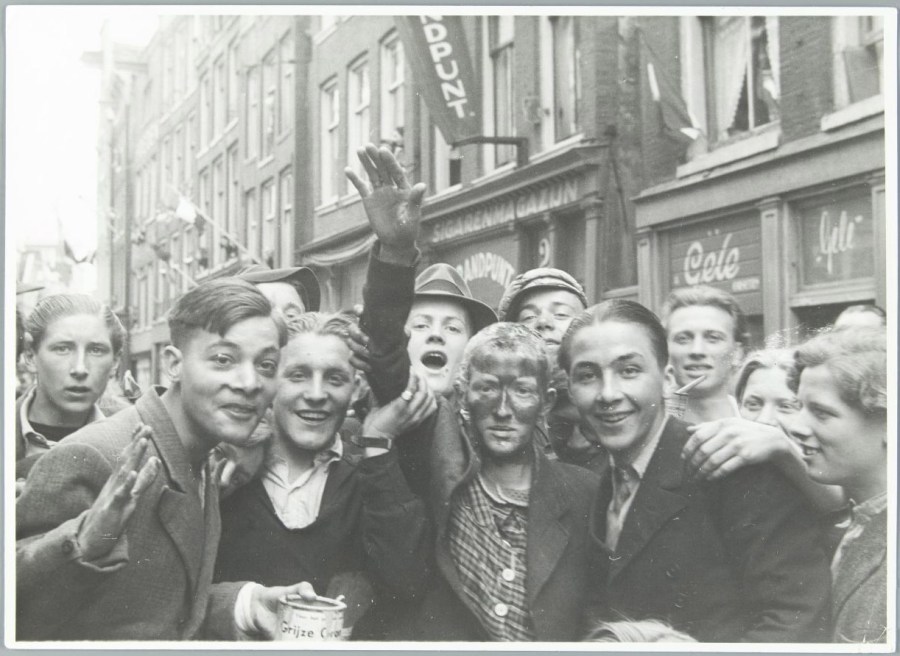
"Moffenhoer" behandeling van een vrouw met een Duits liefje op 8 mei 1945 in Amsterdam: kaalgeknipt en geschoren en met pek ingesmeerd en gedwongen voor de foto de Hitlergroet te brengen. Een voorbeeld van hoe snel bij een machts- en rolomdraaiing de strafhandeling verwordt tot een spiegelbeeld van wat verafschuwd werd..
“Geknipt en geschoren”, voor mij zijn dat een hele reeks beelden: ‘bijltjesdag’ waarbij een niet geheel koshere menigte de liefjes van Duitse soldaten op straat kaalscheren; militair geleide heropvoedingsgestichten voor straatbengels zoals beschreven in de jeugdromans van ‘Pietje Bel’ tot ‘Willem Roorda’; dorpsgerichten op het Italiaanse platteland in de zestiger jaren waar hippies (cappelloni) de haren afgeknipt werden… Zulke beelden vliegen zo snel door je hoofd en laten zich zo traag opschrijven en lezen, dat ik nu verder René van Rijckevorsel aan het woord laat:
“Verontwaardiging
Terwijl Geert Wilders door heel politiek correct Nederland wordt gekapitteld voor zijn generieke opvattingen en ongenuanceerde uitlatingen over moslims, is er relatief weinig publieke verontwaardiging over de wijze waarop jonge Marokkaanse Nederlanders in de publieke ruimte redelijk ongestoord hun antisemitisme kunnen botvieren.
Maar wat Marokkaanse Nederlanders denken en zeggen over joden, gaat nog een tandje verder dan wat Wilders beweert over moslims. Overigens heeft die nooit gezegd dat álle moslims Nederland uit moeten, zoals tegenstanders zijn woorden uitleggen, hij had het over criminele moslims en ‘straatterroristen’ met dubbele nationaliteit.
Vinexwijk
Niet alleen joodse Nederlanders hebben het steeds zwaarder te verduren. Het is met de dag onveiliger om ostentatief als homo over straat te gaan in wat ooit de ‘gay capital of the world’ was. Of om als homostel in vinexwijk de Leidsche Rijn in Utrecht te wonen. Twee mannen zijn er uit hun koophuis getreiterd door Marokkaanse jeugd. Er is nog niemand gearresteerd, omdat er niet genoeg bewijs is, aldus burgemeester Aleid Wolfsen (PvdA).
De onrust over het toenemende anti-homogeweld leidde afgelopen zondag tot een spontaan protest bij het homomonument in de schaduw van de Amsterdamse Westertoren. In aanwezigheid van het nieuwe PvdA-Kamerlid Ahmed Marcouch kwamen honderden demonstranten bijeen.
Behandeling
Marcouch wond er geen doekjes om: ‘Deze jongens hebben een speciale behandeling nodig. Ze moeten geknipt en geschoren worden, voordat ze weer op straat staan.’ Hij wees erop dat er geen hek om Nederland staat, daarbij degenen aansprekend die de vrijheid en tolerantie blijkbaar niet kunnen verdragen. Later in de week bepleitte hij zelfs het inzetten van ‘lokjoden’.”
Damschreeuwer = vrijgelaten maar (nog) niet vrijgesproken
Posted in Amsterdam history, Amsterdam World Village, Dutch politics, Dutch Royal House: 21st Century View, Justice, Nederlandse rechtsstaat, Uncategorized on June 11, 2010| Leave a Comment »
37e dag voorarrest 10 juni 2010:
De Damschreeuwer = VRIJ maar nog niet vrijgesproken.
416 mensen ondertekenden de petities gestart door Hen Krol, talloze commentaren en veroordelingen van zijn gijzeling/voorarrest waren in de eerste twee weken te horen, later verminderde de belangstelling, zoals fraai te zien is op de petities.nl web site. Voor het digitale nageslacht hierbij de belangstellingscurve… van de petitie-site.
De conference van Freek de Jonge aan de vooravond van de verkiezingen zal zeker aan de overwegingen van de rechters om hem niet langer in voorarrest te houden hebben bijgedragen. Toch nog de macht van het woord? Wel versterkt door geconcentreerde media-aanschat (1.6 miljoen kijkers) denk ik mij als getal te herinneren. De zaak zelf is nog niet afgedaan. Het is van belang om ook de nu intredende vertragingstactiek van het rechtssysteem bij te houden. De zaak begint nu overeenkomsten te vertonen met die van de wegens majesteitsschennis op de Dam in Amsterdam opgepakte Uruguayse demonstrant tegen “De Domme Prins” en zijn ontkenning van enige betrokkenheid van zijn schoonvader bij de Argentijnse genocide tijdens de vuile oorlog (in het jaar 2002). Waarmee we tevens in de toekomst kijken en luisteren en een schreeuw over de Dam denken te horen “Nunca Mas!” tijdens de kroning van Willem Alexander met Pa Zorreguieta op het bordes van het paleis. De lieden die dat mogelijk gaan roepen zijn waarschijnlijk meer nuchter dan de Damschreeuwer op de vroege avond van 4 mei 2010.
[Deze tekst werd geschreven voor de Facebook campagnepagina: DE DAMSCHREEUWER MOET VRIJ!]
Kort videofragment met verklaring advocaat van de Damschreeuwer voor lokale televisie AT5
Klompenmania: Amsterdam’s oversized tourism and the need to measure
Posted in Amsterdam history, Amsterdam World Village, The downside of leisure industry, Urban questions, tagged AI! Amsterdam, Amsterdam inner city, darkrooms (sexual). coffeeshops (soft drugs), gay culture, gentrification, Gert Hekma, hashish, I Amsterdam, klompen, linkedin, marihuana, mass tourism, neo-colonial nationalism, opium trade, recreational drugs, Red Light district Amsterdam, sexual segregation, Warmoesstraat on September 28, 2009| 6 Comments »
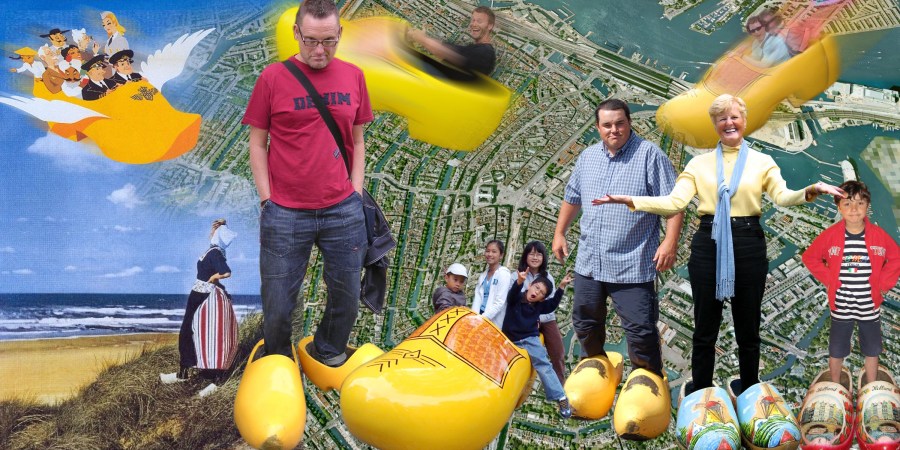
Two KLM airway posters from the fifties combined (*) with a Google Earth view of Amsterdam and seven examples of cut-out, non montaged real street photographs of oversized Dutch wooden shoes (klompen) that can be found in all tourists areas of the town, outside the shops that sell tourist gadgets. Tourist like to pose standing in them for a picture – by their family or friends. An uncountable number of such photographs of people in disproportioned Dutch footwear must be around in personal collection all over the world as a reminder of a visit to the city of Amsterdam. It keeps me wondering, was it really fun? Did they have any association wearing these big clogs, like the word ‘sabot’ for wooden feetwear of workers in French, from which comes the word ‘sabotage’? The Dutch wooden shoes, ‘klompen’, have mostly disappeared from daily life in the Low Countries, though some farmers and workers in the fields may still use them. The footwear was meant only for outside and would be left at the porch, so one was walking inside on ‘socks-feet’ (op kousenvoeten). ‘Klompen’ for the Dutch themselves associates strongly with no-fuss, sometimes even rough behavior, something fragile being trodden by a sabot. The most frequently used Dutch expression referring to ‘klompen’ is “dat kun je op je klompen aanvoelen” (you can sense that with your wooden-shoes on). Click picture for full size view of the collage.
Splendid weather yesterday, a late September saturday afternoon, it made my friend and me decide to walk to the Lindengracht market at the other side of the town center. So, the Red Light district, the major shopping streets and one of the soft-drug tourism arteries, the Haarlemmerstraat had to be crossed. These are areas which I always try to avoid when going by bicycle, but now we were on a social-geographic survey of these parts of town, which I had not seen for quite a while.The streets were bustling with tourists and their non-directional pace of walking: halting to study their maps without concern for the other pedestrians and cyclists – often in the middle of the road; whimsically crossing as if the streets were empty; framing their camera pictures while forgetting about the world outside their viewer – causing frequent near accidents; being absorbed in consuming their walk-about-lunch; trying to keep group cohesion despite the fragmented Amsterdam public sidewalks with their thresholds and anti-car parking poles. A mixed aroma of exhausting fumes, hashish and the smell of cheap pizza touches our nostrils as we manage to proceed slowly in the direction of our evening meal shopping market in the Jordaan neighborhood.
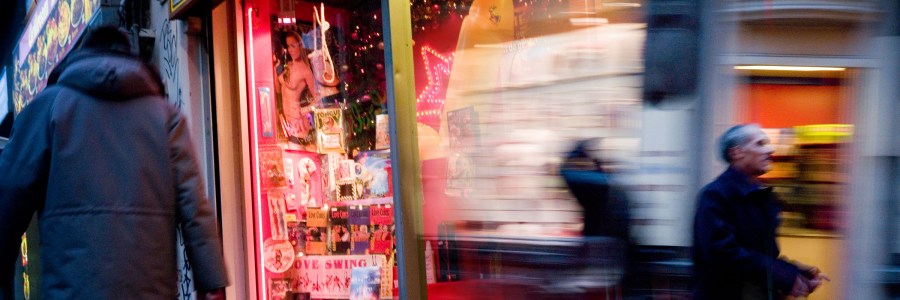
I montaged two modernistic tourist photographs in this illustration, photographs I found on Flickr, made by a man posting under the alias ‘Urbandiscount’; a photographer with a talent for catching the atmosphere, better than most regular flat tourist photographs (**). Click picture for full size view.

Amsterdam, Warmoesstraat, at two different moments montaged in one view, showing the regular tourist crowds. Click picture to study the text and images on the sign posts.
As this walk was meant a survey as well, I scan the street fronts of the houses and shops for apparent changes, and there were many. The main trend is not typical for the inner town of Amsterdam, but maybe more outspoken and dramatic than elsewhere. Most of the surviving shops that had some direct function for the life of the locals are gone: grocery and green grocers, the traditional coffee-burning and grinding shops, tobacconists, hardware shops, dry cleaning and the like, with one exception, the bakery shops, the last ones seem to survive all modern massification and monopolization and are thriving with new tourist customers. Venues like the open front walk in ‘coffeeshops’ are examples of replacements. Coffeeshops (the Dutch way of spelling it) whose business is in fact selling hashish and offering smoking facilities for those who claim to smoke it pure… (so the anti-smoke law for public spaces does not apply). Waves of loud music pour from these establishments and there seem to be no more local residents left at the floors above who could rightfully protest against the reproduced sound levels. Shops specializing in ‘recreational drugs’ paraphernalia pop up with regular intervals along our trajectory, also tattoo and piercing studios, male and female lingerie boutiques and sex cinemas. The condom shop is still there (called ‘Condomerie’) it exists already for twenty years in the Warmoesstraat, once started as a fun idea in one of the groundfloor shops of the then squatted housing block ‘Blauwlakenblok’, developing into a regular business enterprise soon after. A bit further on, in the direction of the train station, many gay bars, hotels and ‘darkrooms’ (mainly male) have settled in the last two decades. A historical function one may say, as the Warmoeststraat has done the sexual catering for both the sailors and local inhabitants for centuries. What is different though – compared to the past – is the density of such facilities now, and the fact that homosexual services are openly promoted. House after house in the Warmoesstraat and surroundings have been taken over by a ‘troika’ of the recreational sex and drug industry combined with what we Dutch call ‘horeca’ (snackbars, restaurants, cafés). The ‘horeca’ is there mainly to supply the armies of ‘lurkers’ – those who are just watching – with an alibi to have a drink and snack, wander around and stare. Step by step this troika has pushed out services providing for the daily needs of local residents. I still remember the area as a mixture of cafés, restaurants, sex business, small workshops and family living. I have not seen statistics yet on the dwindling number of normal resident houses or apartments in the Red Light district and adjacent areas, but that it is strongly diminishing is something anyone “can feel with their wooden-shoes on.”
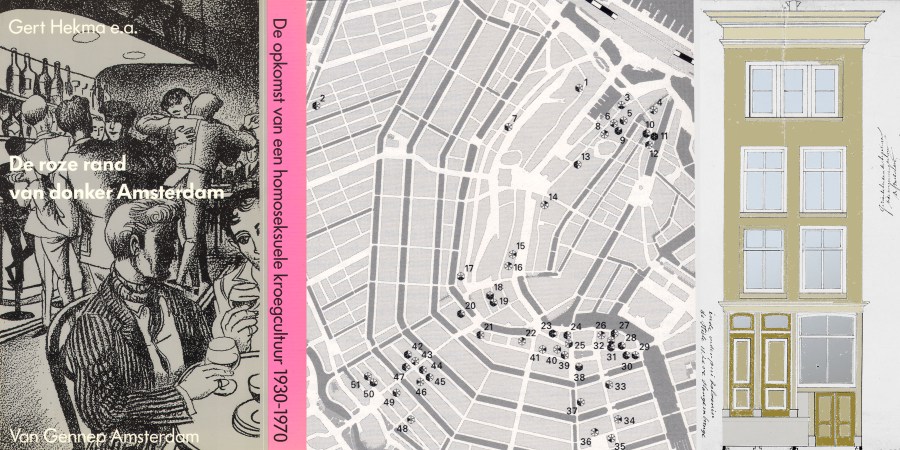
“The pink margin of dark Amsterdam, rise of the homosexual bar-culture in Amsterdam 1930-1970” a 1992 publication by Gert Hekma (University of Amsterdam) and his wide circle of informants, with a map showing the location of bars over 60 years. Each dark triangle in the rosettes on the map represents a decade. At the left a facade drawing I found in the municipal archive of Warmoesstraat 20, where from 1955 to 1971 Hotel Tiemersma with its pre-darkroom facilities had its abode. I have slightly colored the facade drawing because it would otherwise hardly be visible. To be able to see the details you have to click the picture..
What was – only forty years ago – a very much needed sexual emancipation of suppressed gay people, has grown into an industry concentrating to such a level in certain areas of town, that other social and economical functions are marginalized by it, or cease to exist. In a very instructive little book “De roze rand van donker Amsterdam” (the pink margin of dark Amsterdam) delivered by Gert Hekma of the University of Amsterdam in 1992, one can read about the very slow rise of “a homosexual bar-culture” in the period 1930-1970 and the inventive ways of gay people to congregate in times that homosexuality was a thing not even mentioned. It is only in the fifties that the worse forms of police prosecution are over and several membership clubs start to offer some sort of safe heaven for (mostly male) homosexuals to meet, like the drab DOK cellar at the Singel (in ‘gebouw Odeon’) seen – once forty years ago – as the biggest gay dancing in Europe. The Warmoesstraat and its surroundings do have over half a century of history in supplying gay entertainment. A pioneering place was Hotel Tiemersma, once a tobacco shop at number 20 of the Warmoestraat, started by a sailor man Sako Jan Tiemersma. From the early fifties the hotel also had a tiny bar (without a permit at first) with a permissive barkeeper that allowed some forms of intimacy. The hotel rooms had no lock and the clientèle also behaved with little restrictions and a kind of ‘darkrooms’ avant-la-lettre existed there. The hotel was a meeting point for the early leather scene (‘leerwereld’ in Dutch, which is a funny word as it also means ‘world of learning’), a scene that heralded the shift from the feminine tot the macho-type of homosexual behavior. The Amsterdam homo community before WWII had its division in active penetrating males (called ‘tules’) and passive receiving feminine males (called ‘nichten’). It was a community in which sexual partners from the twilight zone of heterosexuality also participated as ‘tules’. With the advent of the leather scene this attitude changed, as Hekma puts it “The ‘homos’ now could fornicate each other and horniness, to be satisfied, needed the outside world much less.” [my free rendering of his sentence on page 73; tj.] Any nowadays sex tourist can find the new gay-meeting points by a quick search on the internet, zooming in at leisure to specialized areas like the Warmoesstraat and reads about: – Argos at number 95 “The oldest and possibly most famous leather bar in Amsterdam. Sexy, cruisey and heavy. S.O.S. (Sex on Sundays)”; – Dirty Dicks at number 86 “A late night leather bar. This place really lives up to it’s name”; – Stable Master at number 23 “Bar and Hotel famous for it’s jack off / wanking / masturbation parties in the downstairs bar held regularly.”

Indirect depiction of the dark room phenomenon without real action: a sling and smeared walls exposed by a flash light from a camera. In the middle a reflection in a puddle of a Warmoestraat gay bar by a talented photographer I found on Flickr using the long alias name “AmsterS@m – The Wicked Reflectah’s photostream” (***)
When emancipation of homosexuals ends up in a commercialized segregation of leisure and pleasure with expanding specialized zones clustering around Amstel-Rembrandtplein-Utrechtsestraat-Reguliersdwarsstraat, Warmoestraat-Zeedijk, and Kerkstraat-Leidesplein, I am tempted to ask what about “equality” as one of the important substances of my own idea of what emancipation is about? Why not have fun all together, beyond the tender and gender divide? Why this self-imposed social Apartheid? Also, what about the level of, say ‘homosexual’ emancipation and ‘tolerance’ of drugs in all the countries of origin of the hordes of sex and drugs tourists filling the Amsterdam inner town? Did they vote Berlusconi, Sarkozy, Merkel, Putin and thus can’t they smoke a joint at home or in a pub in peace? Is it the Pope, an imman, a rural evangelic fundamentalist that keeps them from doing or at least inquiring about unknown sensual territories at home? And … most important for us locals, is the blunt commercial exploitation through which the tourists are paraded in Amsterdam, – with some side-tripping to Anne Frank and Vincent van Gogh – something we should be proud of? Is that what we want to present to the world? Or is it this, what is most typical Dutch after all, only about making a good buck… on anybody using any opportunity?

Recent Indonesian history depiction of the arrival of the brothers Cornelis and Frederik de Houtman at the Bantam (west coast of Java) in 1596, the picture does not show the firing of ship canons at the native settlements as a result of animosity between the locals, the Portugese and the Dutch. The middle picture is a drawing of the pepper plant from the VOC archives, at the right Robert Jasper Grootveld (1977) while talking about the origin of Dutch drug-trade and the importance to keep everything ‘droog’ (dry), the origin of the word ‘drugs’.
“DROOG, here in the Netherlands, is the most important word.” All the coffeeshop signs with cannabis leaves, in the streets we passed through – this saturday afternoon September 2009- made me think back at that sentence which starts a brilliant and humorous discourse by Amsterdam’s city shaman Robert Jasper Grootveld back in 1977. Grootveld (1932 – 2009) spoke about Amsterdam’s historical role as a market for spices, dried plants and herbs – from far away places like the East Indies – in a documentary movie by filmmaker Louis van Gasteren: “Allemaal Rebellen” (all of them rebels) about Amsterdam radicals of the fifties and sixties. Droog in Dutch is ‘dry’ in English and most lexicographers point to the possible origin of the the word ‘drugs’ in English, ‘drogue’ in French, ‘droga’ in Italian, ‘Drogen’ in German and so on, from the Dutch word ‘droog’. “Dry, here in the Netherlands, is the most important word, a land that had to be drained from a swamp (…) that did send its sailors to the other part of the world – whereby half the crew did not make it back- which was a human offering! … why all that? What you could find there, was something extra, to give some spicy jolt to life: pepper, mace, nutmeg and other plantlike products … and there was only one way to get that from there to here, namely by keeping it: dry (droog).” In this lively interview Grootveld reminds us of the staple-market economy of Amsterdam in the 17th century and the importance within that constellation of – what he properly calls – the “drug-trade” (drugshandel). Grootveld is not an academic, his associations and actions do have a strong persistency nevertheless. The Dutch involvement in opium trade from 1613 up to 1942, during the 19th century even a monopoly of the state from the beginning of the 19th century onward, is something Grootveld certainly knew, but does not mention during this interview. In 1928 the law curtailing the use of opium and other narcotic drugs is proclaimed in the Netherlands, though at the same time keeping the opium trade in the colonies of the Dutch East Indies outside of these regulations. Ewald Vanvugt has written an extensive book on this matter “Wettig Opium” (Lawful opium) in 1985, no translations exists in English, but there is a short interesting online English reference by Dirk Teeuwen (2007), about Dutch state opium trade.

Natives smoking opium in Batavia (Djakarta) 1925 and a view of the Dutch Jl. Salemba opium factory in Batavia, 1925 with machines for mechanical filling of tubes with opium. The opium production and trade was a Dutch state monopoly starting in 1827 in the East Indies and lasting till 1942.
Back from sidestepping and continuing our trip.. As we walked the streets and struggled through the tourist crowd, I had a short fantasy of my own, being a telepathic guide, able to impress my views of the town and its history on each of the leisurely wandering tourists that catched my eye:
“What you see is the product of Double Dutch standards, moral sermons at home, covering up far away exploitive practices. Like our prime-minister Jan Peter Balkenende who does not get tired to preach about the Golden Age and the ‘spirit of enterprise’ of the Dutch East Indian Company (VOC) which we should try to regain today, forgetting to mention the black pages of history of the trading and maltreatment of black slaves, let alone the life of the 17th century poor in the Low Countrries. The historical ‘freedom of trade’, which found once in the city of Amsterdam one of its important bases, was nothing more than the freedoms one can allow oneself when making bad deals – for the natives – backed up by warships with canons. Half the number of poor souls that were crimped into VOC service as sailors died on their voyage to the east. Recruitment officers would round up bums in taverns and on the street, even imprison them, till the moment their ship sailed away. The Dutch that nowadays like to praise themselves for their development aid to poor countries, still fail to recognize that they were fighting colonial wars up to 1961, officially called – to this very day – pacifying ‘police actions’ (“politionele acties” in Indonesia 1945 – 1949 against the Indonesian War of Independence)… “

At the left a (not montaged) photograph of Dutch Prime Minister Jan Peter Balkenende opening the exhibition “Power and Glory: shipping in the Golden Age”, March 2008 in the Maritime Museum of Rotterdam; overlayed at the right with an allegoric painting commemorating a century (1602 – 1702) of VOC (United East Indies Company) business in Amsterdam by the painter Nicolaas Verkolje (who made in the same period a painting depicting Ovidius’s “The theft of Europe”, the ‘theft of Asia’ was a theme far beyond the imagination of any European artist of that time). The painting is part of the Rijksmuseum collection. Click picture for a full size view. Note at the right hand side of the painting two cherubs with a cornucopia from which spices pour: cinnamon and nutmeg, the last is even a tiny bit hallucinatory when used in big quantities.
As it is just a fantasy, I do not get out of breath and my audience does not walk away from the historical hootch their guide is offering, I even manage – for myself – to make a desperate link between things of the past and the present, between the historical void in the brains of the oversized tourist crowds and my own agitated feelings of having lost something, the town I knew, the town I liked… and I explain to my imaginary audience once more, before taking a side street out of the Red Light district:
“The 17th century Dutch trade mentality still lingers on in the veins of the city, sips through the pavement, leaks into the cellars, pollutes the drinking water, but its object has changed. It is is not any more wealth gathered in faraway countries brought back to the Netherlands, instead, there is a progressively developing reversal: tourists flying en masse to Amsterdam and trading the city away. The wooden shoes, once the trademark of this country, its firmness, its endurance in the fight against wind, rain and sea, have grown to an absurd size and – as in a fairy tale – they fit only the tourists, who have great fun banging around in them, not on purpose, just unconscious of the fragility of the city’s civil structures they encounter.”
Crossing the main streets to the Central Station, The Damrak and Nieuwe Zijds Voorburgwal, brings us out of the Red Light district and the number of sex facilities decreases, though the occurrence of coffeeshops only diminishes when we reach the more classy areas of what is called ‘de grachtengordel’ (the girdle of canals). This has a historical reason as the old city ordinances prohibited the construction of alleys and houses of the poor in this area. Also here something has fundamentally changed lately: terraces have sprang up at the most odd and unhandy places, leaving even less space to walk as in the traditional sidewalk layout of this part of town. Where from the fifties onward cars had invaded the inner city and lined all the canals to supply the needed parking space, a new and more profitable development can be noticed: tiny terraces scattered on the sidewalks, along the waterfront and at the sides of bridges. As it was a very warm and sunny September afternoon, all terraces were filled to the brink and so the glasses of the customers, making what was once a quiet zone into yet another bustling boulevard, a scenery even further enlivened by a parade of private pleasure boats in the canals with their ostensibly wealthy and joyful drinking passengers and the traditional big tourist boats maneuvering in between them…

Canal side frenzy with neo-colonial rickshaw services, rentable canalbikes and terraces filling each empty corner.
It can not be helped, describing the scenery of the overcrowded inner town of Amsterdam, ends up in a discouraging and irritating litany … we did arrive in the end at the Lindengracht market and that was not a happy ending. I could have known it, the gentrification of the Jordaan neighborhood have downgraded the variety of foodstuff and upgraded the prices. It did not compete in any way with our regular trip to the Albert Cuyp Market in the 19th century neighborhood of De Pijp. “It looks like a market, but it is only a visual suggestion of it” was my friend’s comment.
On our way back – this time evading the Red Light district – I pondered over the question whether there is any limit to which extend a town can be consumed? What it is that needs to be done to alert people about the negative effects of oversized tourism. A comparative study of mass tourism might be an idea. Paris, Rome and London certainly are not a model because they are much bigger in size and city layout than Amsterdam. Venezia, Firenze are smaller but have a much more cultural oriented clientèle. The Amsterdam city authorities are far from even envisaging such a studious exercise, they may try and shift away the focus from sex and drugs to culture (there are many reports about that), but whatever their fancy, growth of the number of tourists is their uncontested prime policy. Debating tourist policy is anyhow a very unpopular subject with many of my fellow citizens. There are those who do not care because they do not live in the city center or are fortunate enough to find themselves in some of the non-tourists corners. Next comes the economic argument, that it brings a lot of necessary income for the town. As I do not sell beer or drugs and do not own a hotel or restaurant I can see very little direct profit coming my way and indirectly I only notice the rising of municipal taxes over the years as I am supposed to live on what is called a A-locations and taxes are determined by real-estate market value. Nobody has seen it fit yet to study the nuisance of the tourist and party-industry in the inner town and translated that in a tax reduction equal to the level of suffering inflicted on the inhabitants. Is it unacceptable egoism that makes me wish to exclude all those suburbia prisoners that are craving for a real city experience and buy a temporal escape ticket to Amsterdam?
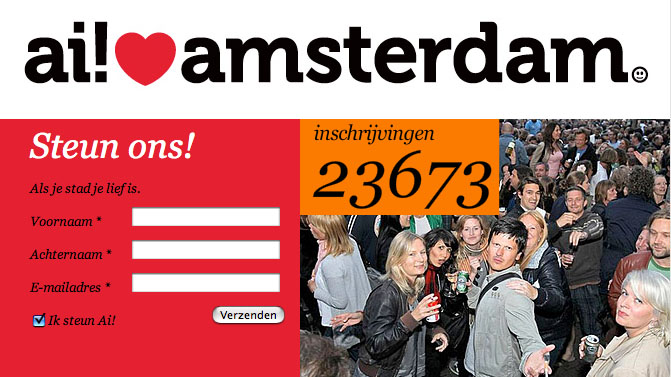
“Hands of my town” (blijf van mijn stad af) somewhere near the Jordaan during our walk I saw a poster with this slogan and I thought at first “Ah! these are people which are fed up also with the down side of the leisure industry.” WRONG! At home I searched for their web site and soon discovered that this is a local pressure group that wants less limitations on terraces, red light district, and other rules regulating inner city life. They are the organizers of a recent ‘drink inn’ to protest against a new local rule that forbids people on terraces to gather and drink while standing (an odd rule that has some rationale in exceptional cases where a whole street will be filled with a drinking crowd). They plan to hold a city referendum turning back all kind of regulations they see as limiting their freedom. Little can be read in their manifesto about neighbors who need some sort of rest, some sort of subdued city silence and one wonders where all the signatories of their petition are living. Certainly not straight above a popular terrace frequented by a “freedom loving” crowd, is my guess. When you read Dutch you may enjoy their argumentation that sounds similar to the good old VOC time rethoric of our prime-minister: “Amsterdam, once the center of the world. Where Rembrandt harvested his fame, Michiel de Ruyter (a Dutch admiral) began his voyages, the great philosophers Descartes and Spinoza wrote their most important works…” Well let me stop here, enough nonsense as De Ruyter was mainly fighting wars and was not a discoverer, which is suggested, Descartes was traveling a lot and only spent two years in Amsterdam, and Spinoza had to flee Amsterdam after conflict with religious and city authorities, doing his writing in Rijnsburg, Voorburg and The Hague. What to think about the concluding paragraph on the city of Amsterdam: “A fantastic place where especially freedom of the way of life and enterprise is signed on its banner for centuries” (Een fantastische plek waar juist vrijheid in leven en ondernemen al eeuwen lang hoog in het vaandel staat). The relativity of the notion of freedom must have escaped this bunch of happy hour drinkers, who direct most of their person oriented anger at the head of the inner city council. Click the picture to have a look at their web site.
Is there some hope in recent developments of Dutch cities next to the Belgian border, that have closed all coffeeshops and organized even a kind of razzias against cross-border drug tourism? No, in spite of all my observations and negative appreciation of the Amsterdam drug tourist scene, I dislike this abrupt and oppressive option. Like the homosexual emancipation there has also been an emancipation of the drug user, from a persecuted criminal to a tolerated recreational consumer. The liberating mind expanding aspects of soft drugs as formulated by idealists of the sixties may have long faded away and turned into hard core business, but the basic assumptions remains valid: to be master of one’s own mind and body and decide by one’s own reasoning instead of external coercion.
There are many options and levels of steering, controlling, and arguing which could bring the transborder soft drug users and the international leisure industry back to acceptable proportions and some sort of balance with the social environment they share with others. When only those who are profiting have a say, when authorities are deaf for the complaints of their citizens and turn a blind eye on the degrading effects of mass tourism, one has to wait for the occurence of some sort of tragic incident before the extravaganza of oversized tourism, of Klompenmania, will be countered.
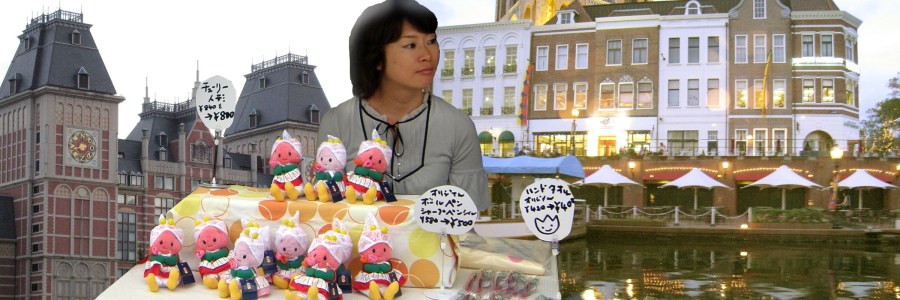
Maybe we should replicate Amsterdam a few times and post it on each continent in an appropriate theme park. A pioneering exercise has already be done in Japan, Nagasaki with the Dutch Theme Park Huis ten Bosch, which has its canals, cosy European alleys and a detailed replica of the Central Station in Amsterdam (*****)
Maybe it is time for the ’emancipation’ of city dwellers, recognizing their “equal rights” on the use of the city, not treating them anymore as Disney actors in their own town, appreciating them for their living knowledge of their house, their street, their neighborhood, their city. The first step toward a city dwellers emancipation is the recognition that injustice has been done, that it is time for measuring tourism, to fit it to the existing scale of a city and not the other way around.
Epilogue
The association in the article with Robert Jasper Grootveld and his discourse on ‘droog’ and ‘drugs’ may seem somehow beside the point for those who have not witnessed the rise of the recreational drug tourism in Amsterdam from the early sixties onward. So I feel a need to explain why it is essential for me. Grootveld has played an important dual role in the history of Amsterdam as a soft drug tourist center, both as one of the first street campaigner against the smoking of tobacco and the dangers of cancer, and as a propagator of the smoking of marihuana, instead. Tobacco was for him not only a health danger, but also an example of of consumer manipulation. He aimed his playful actions at first against the big tobacco industries and their psychological tricks – their “hidden persuaders” – that lured people into satisfying needs constructed by the advertisement industry. His utmost primitive duplicated magazine “De Hippe Zweter” was pointing to the book “Hidden persuaders” By Vance Packard (1957). His actions – an odd mix of dadaism and ‘urban shamanism’ – were aimed at “the liberation of the addicted consumer of tomorrow.” Grootveld’s actions fell in fertile ground. The Amsterdam scene of the sixties was a constant turmoil in which dissidents from the artistic, political and esoteric realms mixed. The people involved came from different backgrounds but still had something strongly in common: egalitarian and communal principles. This has laid the basis for all kinds of social movements that – over the years – freed Dutch society from its authoritarian straightjacket. It is unfortunate that by now this heritage has been spoiled and the former liberating principles only remain as an “imago”. Grootveld’s vision of 1962, a “Magic Amsterdam” as a center of the “Western asphalt jungle”, was already taken over by KLM and the Dutch Tourist Agency (VVV) in the mid sixties and started the influx of beatniks and hippies and other ‘sleeping-bag-tourists’. Only an echo of it rings in the 21st century advertisement agency slogan “I Am Amsterdam” commissioned by the municipality, a faked tourist industry imago that is eagerly consumed by a new generation of ‘addicted city hopping consumers’.

This photograph by Cor Jaring (****) is from 1971 and shows the boat ‘De Witte Raaf’ (the White Raven) moored straight opposite the local Amsterdam police station of Kattenburg, selling marihuana plants, for one guilder each. We see Kees Hoekert at the left and on the right (with a spade and ‘klompen’) Robert Jasper Grootveld. It is a playful subversive enterprise under the name “Lowland Weed Company.” At that time someone had studied the Dutch anti-opium law and had discovered that it banned only explicitly the dried leaves of this plant. Growing plants were not subject to this law and it is through this loophole in the jurisdiction that the wide use of this soft-drug and the soft drug tolerance policy of Dutch authorities came into existence. Grootveld who had been active as an anti-smoke-magician fighting the big Tobacco industry in his own unique ways (because of cancer danger of regular cigarets) had been using and propagating marihuana (instead) from early on. It is at the end of the sixties and the very beginning of the seventies, with the influx of hippies and other young people traveling around cheaply by hitchhiking, that a new form of tourism started to develop in Amsterdam. At first the young people often slept outdoors on the steps of the National Monument at the Dam Square and in the Vondelpark. Outdoor sleeping was soon regulated by limiting the permitted areas and providing cheap accommodation called ‘sleep-inns’, a kind of hip youth hostels, that often provide some cultural program at the side. Youth clubs came into existence, some of them squatted at first but soon legalized, others initiated by the city government who tried to get the youngsters of the street by offering them music and dancing halls. Local cannabis production (nederwiet) was sold in small quantities in these venues. The whole multi-million recreational drug industry originates in this chain of sub-cultural events.
Almost four decades lay between the “Lowland Weed Comapny” of Kees Hoekert, Robert Jasper Grootveld and others, run from a crummy houseboat, a little bit offside the town center, and new cannabis businessmen like Arjan Roskam and Olaf van Tulder. The businessmen own a chain of enterprises with different outlets: coffeeshops, a clothing and accessory line and luxurious rental apartments in the town center (several coffeeshop owners have started to diversify their businesses, in case the tolerance policy will change). There is a Youtube movie of the opening ceremony of their sumptuous coffeeshop at the Haarlemmerstraat (opposite the historical building of the Dutch West Indian Company). First speaker is August de Loor, a former street-corner worker helping hard-drug-addicts for decades, now presented in the movie as a “Drugsexpert”, his speech is about the legal front door for the customers, the half legal shady back door where the drugs come in and the threat of a possible change in the liberal soft drug policy of the government. The proud owners explain the decorations in the different rooms of their new establishment, including their own depiction in Delft Blue tiles, dressed up as “King of Cannabis” and “Lieutenant Admiral of Greenhouse.”

In january this year a new coffeeshop (from the Greenhouse chain) has opened in the Haarlemmerstraat, where the owners have chosen to display themselves on the walls in colonial settings in newly made ’Delft Blue’ tile tableaus. The shop owners and managers can be seen on deck of a 17th century sailing ships. A banner text is partly visible and seems to read: “…those who have the history … will shape … the future.” In a Youtube video owner Arjan Gorter speaks about “the inspirational history of Amsterdam in the Golden Age” which has been brought back in the interior. It is as if I hear Prime Minister Balkenende speak similar words, about a national past that never existed.
———–
(*) The two KLM posters that have been fused in the left hand part of the Klompenmania collage can be found on the web site of the “Urban Nebula” study group. The site has some flash animation installed which does not allow me to make a precise link, you have to search the checkerboard of poster details to find your way.
(**) Warmoesstraat pictures by “urbandiscount” posted on Flickr.
(***) “Some guys and a Sexshop on the Warmoesstraat, reflected in a puddle in Amsterdam”, artistic photographs of Amsterdam reflexions in rain puddles by “AmsterS@m – The Wicked Reflectah’s photostream” posted on Flickr
(****) Web site of photographer of Cor Jaring, a must for anyone interested in Amsterdam history as seen form the margin.
(*****) The website of Huis ten Bosch Nagasaki can be found here.
This by the way is the second time that this building (Amsterdam central Station) has been replicated in Japan, Tokyo Central Station, dating from 1914 is somewhat freely modeled by the Japanese architect Tatsuno Kingo after the creation of P.J.H. Cuypers from 1889, though ther are archiecture historians who deny it; I personally know both station well and must say that I was struck by their ananlogies from the first moment I entered the Tokyo version.
Animals & Humans in city parks: whose terrain?
Posted in Amsterdam history, Amsterdam World Village, Ecology, The downside of leisure industry, Urban questions, tagged Appelsap hiphop festival Amsterdam, city animals, free space for alcoholists, hoenk, hoenkie boenk (overal doorheen dreunende electronisch versterkte muziek met een volume boven de 80 dBA), loud music, Martin Verbeet (PvdA/Amsterdam), music festivals, Oosterpark Amsterdam, public parks, rabbits, sound addiction, sound pollution on August 10, 2009| Leave a Comment »
How to do a poll on the level of appreciation of animals of human loud music festivals in public parks and if needed to take appropriate measures? As policy change can be slow, I just designed a set of earmuffs for the rabbits of the Amsterdam Oosterpark (as they have an extreme sensitive hearing apparatus)
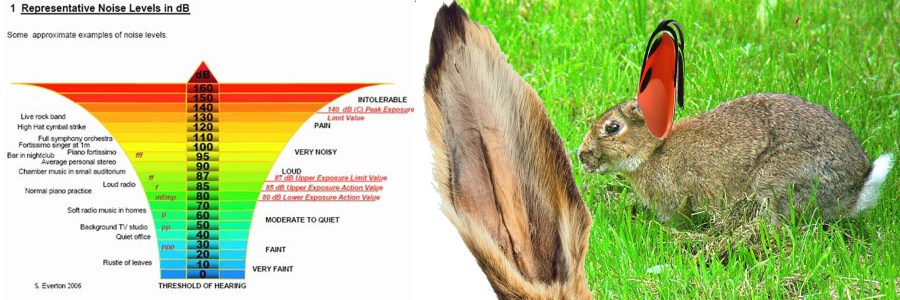
When human city culture gets in the red decibel-zone the park rabbits will be handed out specially adapted earmuffs.
The ‘partying nation’ Holland will not fail to use any occasion to throw a public manifestation of leisurely fun which, since ubiquitous cheap electronic sound amplifying devices have become available, means lots of noise enhanced by lots of drinks. One of the favorite venues for these undertakings is the Amsterdam Oosterpark which recently hosted a festival called ‘Appelsap‘ (apple juice) organized by a bunch of friends, all hip hop aficionados, which was certainly not non-alcoholic, with Heineken as one of the main sponsors. “THE best) Dutch hiphop-events. In the beautiful Oosterpark we take hiphop back to its roots”, reads their web site. Lots of fun for sure: out, proud & loud … but what about … the roots of the park and what makes up its innate beauty?
This a one of the many Youtube renderings of the recent Appelsap hiphop event in the Oosterpark, the sound must have been so loud and/or the recording equipment may have had no special dimming switch, because the sound track is totally overmodulated, so rejoice the noise….

Change of original design intend and actual usage of the musique kiosk/dome at the Amsterdam Oosterpark; both options could coexist but when one takes in account the frequency of such loud events the question can be raised if animals and vegetation of our city parks can cope with the crowd and its noise. I also found some web-traces of a Christian evangelic organization that used the same music temple for their 2009 Pentecost praise-the-lord meeting... so who knows what paradisal scenes could have been observed at that other instant of park life.
This spring a local city councilman Martin Verbeet (of the social-democrat party/PvdA) made an attempt at restoring the park to its “historic function” by banning all alcohol usage within the park confines. This measure was aimed primary at full-time alcoholics, a species that traditionally congregrates in public parks (can be seen all over the world). In fact the alcohol-habit people disturb not too much and even give a certain security by their daylong presence on the park benches withholding more badly inclined park visitors from trespassing upon non-assertive park dwellers. Side effect of this zealous municipal policy was that local inhabitants who like to have a nice drink with their picnic would also fall under the new alcohol ban. Apart from the feared diaspora of debased alcoholics onto the doorsteps of the neighboring streets, the new regulation had a surprising exception paragraph for major events like Queens-day (the 30th of April, a Dionysian national bacchanal in the Netherlands). Who knows if beer-multinational Heineken has been lobbying, or it could have been the feared loss of votes from the partying minded masses, within a few weeks the zero-alcohol-in-the-park campaign was withdrawn by the local council. Some park visitors regret this sudden retreat and signal that the group of drinkers can get so big that certain people feel menaced and do not dare to pass the drinkers benches….

The official Amsterdam city sign that makes many people, not just tourists, wonder what this could mean and next to it a make shift bar during the Appelsap (apple juice) festival which had more than just soft drinks.
Fellow councillors of other parties have been mocking the zero-alcohol measures of their colleague Verbeet (chairman of the local council), some (D66 party members) even have held an illegal demonstrative drinking party, the local daily newspaper Het Parool wrote negatively about the alcohol ban, and members of Verbeet his own party choose not to support him on this topic. A personal démasqué for Martin Verbeet, but maybe some of the good intentions of the councillor may have been overlooked. In november last year the local party fraction of the social democrats made a research on the functioning of the Oosterpark (102 respondents, 81 on-line inquiry, 21 written reactions/ street interviews) and it must have been upon the outcome of this small research that the zero-alcohol measures have been decided.

There is a lot of moaning in the bare 13 pages of this report from gays that frequent the bushes for back to nature outdoor sex, to the obligatory complaints about dog shit, befouling humans, public toilets, unleashed dogs and dog fights, mopeds and bicycles on pedestrian ways … Surprising is that – apart from dogs – animals are hardly mentioned in the report, or it must be the escaped or freed green parakeets that some people hold to be a nuisance and of course the arch enemies of any human: the rats who criss cross the park at will. Geese, moor-hens, swans and herons are taken for granted, rabbits remain unnoticed and I am sure that a tiny corner of the arch of Noah should be reserved for other more discrete park inhabitants that have managed to escape our attention.
Noise nuisance, sound pollution if you want, is mentioned by several interviewees, especially late night drumming, screaming and other forms of rambunctious behavior. There is also a positive approach to the park, an attempt to formulate what it can or should be, as shown in the following statistic.

-Green lung for the town -Play area for children -Sporting area - Oasis of tranquility -Hang-out spot for youngsters -Art stage -Other functions: tai chi spot; picnic and party; garden architecture; café, terrace environment (...)
Again animals are only implicitly represented in the report as part of the “green lung of the town” or the “oasis of tranquility”, though tranquility may for some people exclude even the communication of birds. There are known instances of deportations – organized by a team of city-biologists – of whole troops of geese whose claxoning was found to be unbearable by human city dwellers. Which tempts me to deviate to the somewhat reversed subject of birds dialoguing with the city sounds of ambulances and car alarms (I do have at times whistling conversations with birds that reside in the tree across my kitchen window). This to emphasis that an insight in the animal experience of human sound production and its cornucopia of amplifying devices is very much needed. What are they doing when there is an influx of a rock, hiphop or jembee drums? Are they fleeing? Hiding? Creeping deep in a hole safely below the roots of a tree? Do they leave the park forever after yet another blast-out? Just play the Appelsap Youtube video once again and let your imagination work. When the hiphoppers speak about roots, let me do so so as well:
What then,was the idea of having a city park? Bringing nature -in an organized human format – into the city? Giving the experience of a garden to those who did not have one? Breathing fresh air? A practicing ground for civic behavior? A place to show yourself and your family if you were wealthy enough? A way to get some understanding of nature – for alienated city dwellers? Or is all that totally out of fashion and should we better think about a dropping-ground for children, a jogging parcours, a skaters circuit, a music esplanade, a juvenile hang-out, a cruising area, a chill-out spot? Is there any possibility to fuse modern city culture with its apparent need for loud sounds and mass audiences with an ecological attitude that can be branded ‘modern’ as well? Can these two practices be reconciled at all? Might it be an idea to get as aware of people’s “noise habits” as we are of people’s “drinking habits?”




